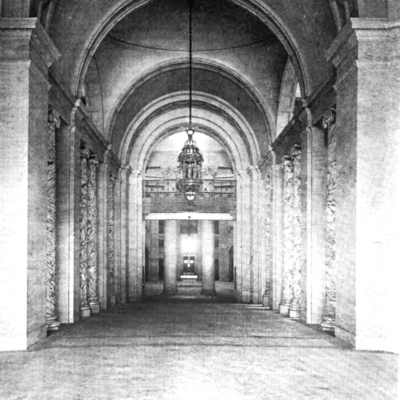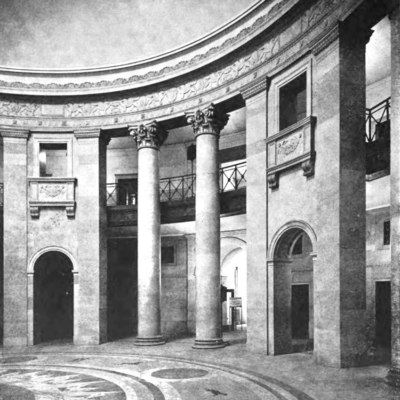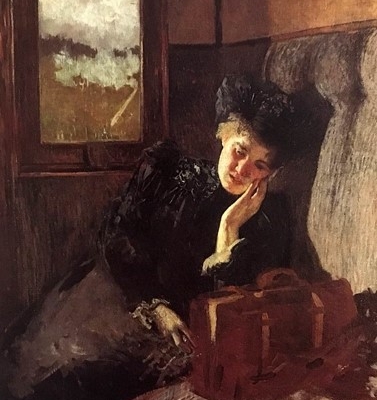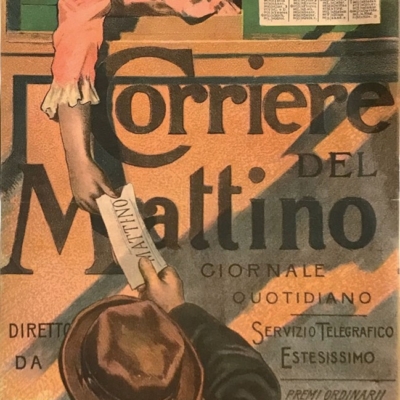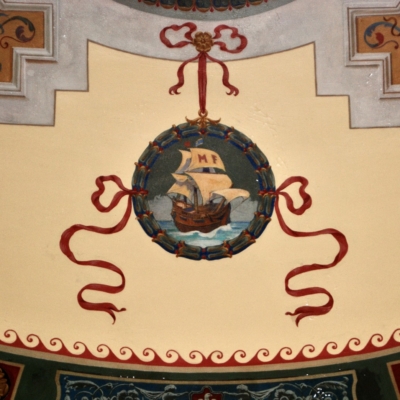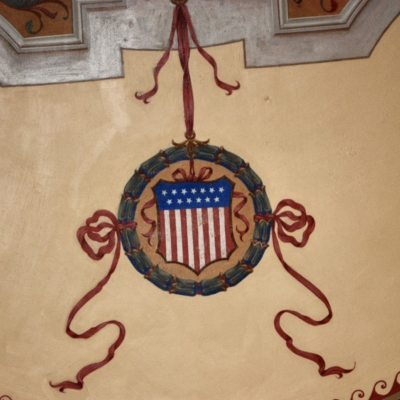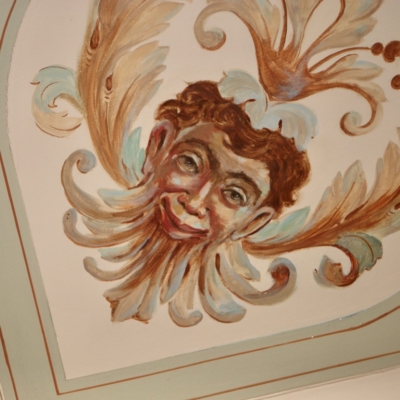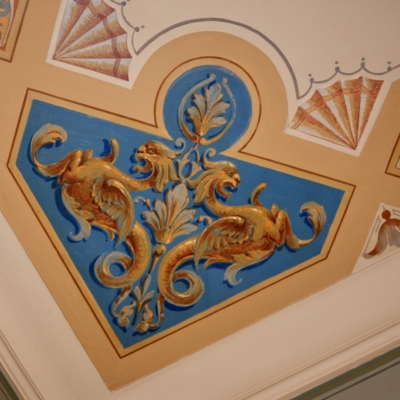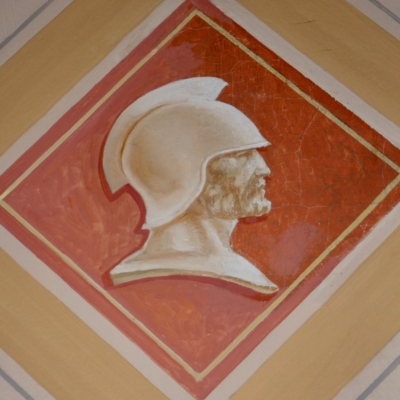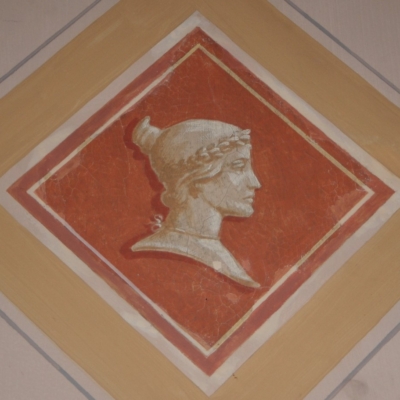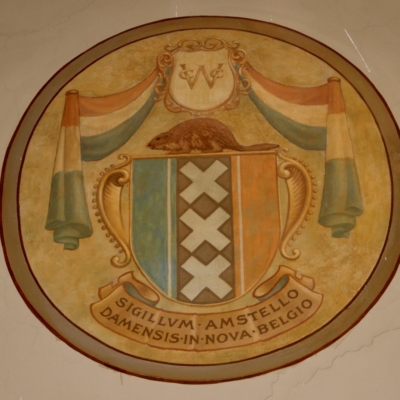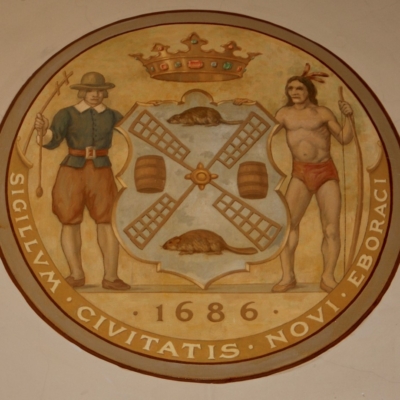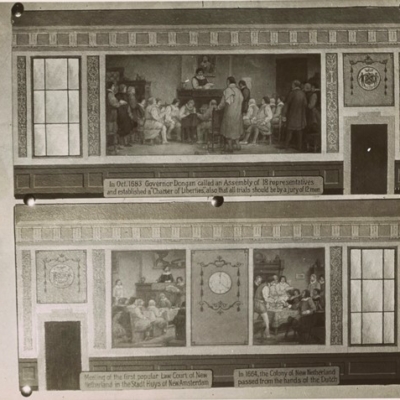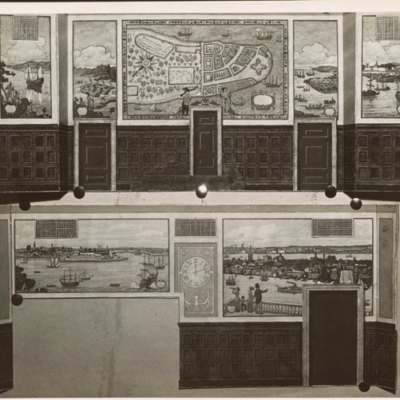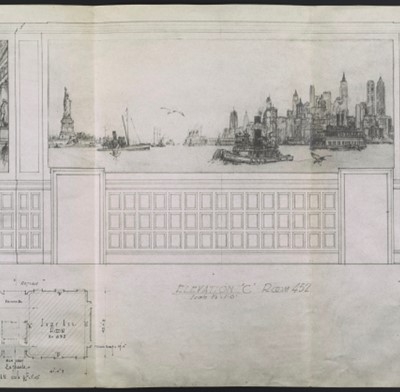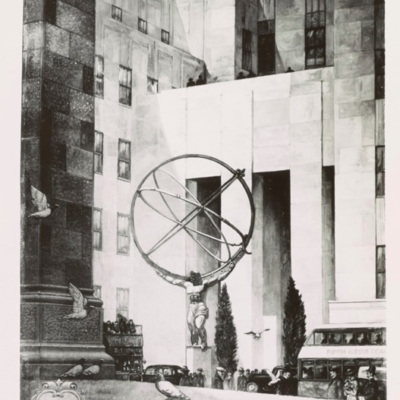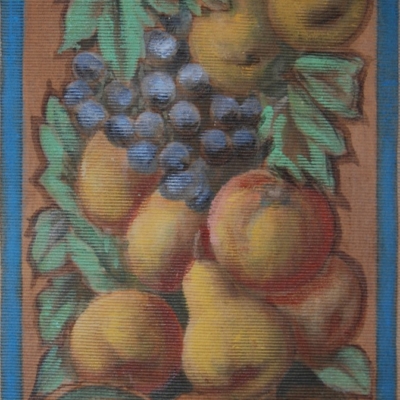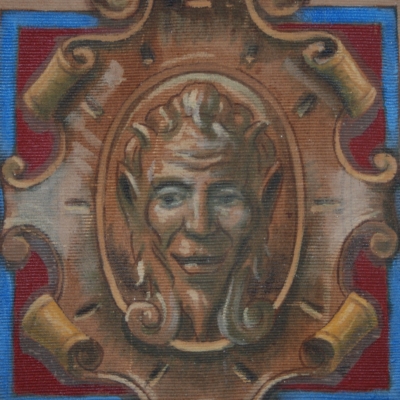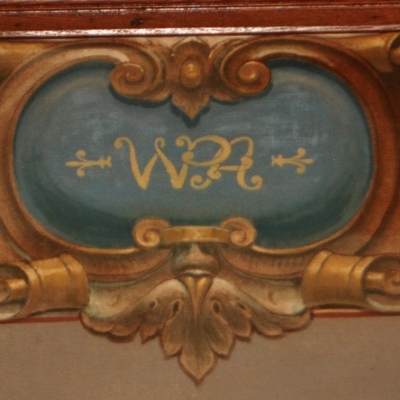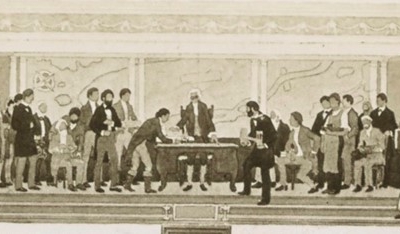The Depression-Era Murals of the New York County Courthouse
by Robert C. Meade, Jr., Esq.[*]
This article is dedicated to the memory of the Honorable Norman Goodman, the very-long serving County Clerk of New York County and a devoted guardian of the New York County Courthouse.
The murals of the New York County Courthouse, of which there are 38, have, since their creation during the Great Depression, been widely recognized as treasures, among the outstanding works of such art in the great metropolis of New York, the country’s principal center of artistic life and work. In 1981, the Landmarks Preservation Commission of the City of New York designated as landmarks the “excellent” and “powerful” murals of the first two floors of the County Courthouse.[1] And when a painter, muralist, and scholar of art collected images of and wrote about the leading examples of mural art in New York City, namely, the 33 most important, influential, and impressive murals in the city, the murals of 60 Centre Street received a chapter, as they certainly deserved.[2] The great murals at the New York County Courthouse, like those elsewhere in New York City, “say to those who inspect them that they too are part of this magnificent continuum of human endeavor and achievement that is New York.”[3]
What follows is the story of the murals. This story has multiple dimensions, and some of these extend beyond the history and artistic programs of the physical paintings themselves. These dimensions shed some light on important aspects of America in the 20th century. They tell us something about hard work, effort, and inspiration: the struggle of the immigrant to make his way in a foreign culture in which many, perhaps the majority, speak a language different from his own and of the sacrifices the journey to this country required; the effort of artists to carve out for themselves a career that is successful artistically, but that is also financially realistic in a commercially-driven country; and the never-ending struggle to bring beauty to public life. One dimension of the story concerns the seriousness of the challenges that faced so many ordinary people during the tremendous economic catastrophe that was the Great Depression, the worst in the history of the country, and the efforts of the government to help artists, like other workers, to survive and maintain their skills, while enriching the national life by bringing art to the American people. This story, being centered around the work of one of the country’s most important and widely-recognized courthouses, also gives us reason to think about the struggle to honor, but also to bring to reality for everyone, the ideals of justice and fairness in a system of ordered liberty under law. Finally, the story underscores the duty that falls on all of us to respect and preserve for future generations the artistic heritage of this country, which has so often been created by artists at great personal cost.
I. The Murals of the First and Second Floors
There are, as I said, 38 murals at the New York County Courthouse. (See the appendix for a listing.). This figure does not take into account the decorative (as opposed to mainly representational) murals on the first and second floors and in some other locations on upper floors. There are five representational murals on the first and second floors: the three-domed painting on the ceiling of the vestibule; the paintings over the two hallway passages in the vestibule; the painting on the ceiling of the main corridor; and the painting on the ceiling of the rotunda. There is also a substantial mural over the entrance to Courtroom 130. All of the mural paintings on the first and second floors are frescoes, which I will explain later. All but three of the 32 paintings on the upper floors are oils painted on canvas. The main representational murals on the first floor and in the rotunda are ceiling paintings, although there are three wall paintings on the first floor as well. The decorative paintings in the corridors on the first and second floors are on their walls and ceilings. All of the murals on the upper floors, on the other hand, are wall paintings. The principal paintings on the first floor and in the rotunda are by far the largest in the building.
I will first discuss the history of the murals on the first and second floors, their principal creator, and their artistic programs (i.e., their subjects). Thereafter, I will address the history of the murals on the upper floors, the identities and backgrounds of their creators, and the artistic programs of these paintings. Later, I will describe what I call missing murals and some other matters.
A. The Architect’s Plan
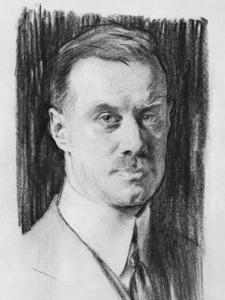
The New York County Courthouse was the work of Guy Lowell, “the quintessential gentleman architect of the American Renaissance,”[4] a scion of one of the most prominent Boston families, who was also well-known as a landscape architect. He designed and built the edifice over a very lengthy period. My colleague, John F. Werner, Esq., and I recount the history of the design and construction of this neo-Classical masterpiece and other aspects of the building in an article for the Historical Society of the New York Courts and I refer readers who may be interested in the architecture of the building and its history to that work.[5] One of the significant aspects of Lowell’s design was that there were to be decorations on walls and ceilings in portions of the new building. He planned that various spaces in the facility would be adorned with murals, above all in the rotunda of the main hall around which the building is centered and its life in many ways revolves. This plan was not a vague goal or general abstraction. It advanced to the point that he selected a muralist for the project he envisioned. This was Attilio Pusterla, whose background, life and work as a painter we will describe later in this article. In the end, Mr. Pusterla created the principal murals and oversaw the entire project of decoration, but that project did not proceed as rapidly as Lowell had no doubt hoped, as fate intervened.
During Guy Lowell’s work on the courthouse, he called upon Pusterla to make drawings for the murals that he planned for his new edifice. Pusterla did this and submitted the drawings and models to Lowell.[6] As best I can determine, Lowell was satisfied with Pusterla’s designs. I do not know, however, how much of the courthouse Lowell’s plans embraced, whether all of the walls and ceilings that were ultimately painted on were included in these designs, nor whether Lowell intended that murals be painted in additional sites in the building, including in the four locations for which murals were later formally proposed, and in one instance approved, but where none was ever executed. The murals were not, however, created before the dedication of the courthouse, which took place in February 1927. It may be that court authorities were anxious that the building be opened for court operations as soon as possible and that therefore other work on the project was given priority. The birth of the courthouse had after all been a troubled and an extraordinarily protracted process — a gestation of 14 years. A design competition for the project had been held in 1913 and progress on the project had been delayed by World War I, during which the site of the courthouse had been the location of a military facility. The war also had brought about fiscal problems for New York City that caused Lowell’s original design for a mammoth circular courthouse to be discarded and the project to be re-designed in a manner that would be less costly.[7]
After the courthouse was dedicated, work on the murals still did not commence promptly. It ought to have been possible to proceed with the creation of the murals while the courthouse was in operation, as this in fact came to pass when the project was put into action later. It seems to us that the untimely death of Lowell just days before the dedication ceremony probably interfered with the work contemplated. But that would not provide an explanation for why the work still did not proceed for years thereafter, which is what transpired. Mr. Pusterla’s drawings and models remained with Major John H. House Jr., an architect who was an associate of
Lowell,[8] who could have overseen the implementation of Lowell’s decorative ideas by Mr. Pusterla. From the length of the delay, the fact that the Great Depression began a little over two years after the dedication, and the fact that in the end the project began to come to life when a specific funding source became available, I deduce that it was funding challenges that principally brought about this delay.[9]
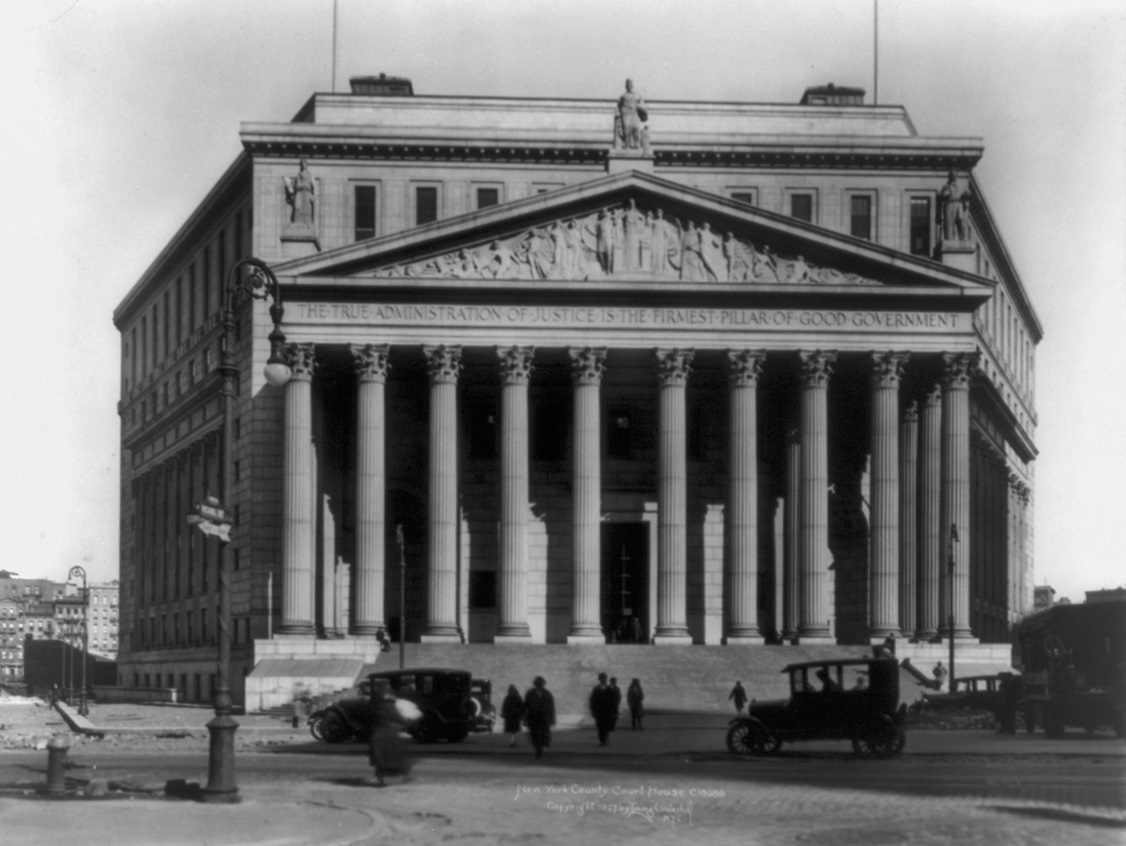
Thus, despite the intentions of the architect, when the courthouse opened in February 1927, its ceilings and walls were entirely devoid of decoration and it would be years, in the case of the ceiling of the main hall about a decade, before those decorations were created and installed.
What changed the status of the plans for the murals was that, after the economic disaster had descended upon the country, the government responded to the crisis with a variety of interventions, including a group of government-supported arts programs. Two of these programs made all the difference to the planned murals. Indeed, it is certainly possible that had these programs never been created, all the walls and ceilings of the courthouse would remain blank to this day.
B. The New Deal Art Programs
The funding that was to prove to be determinative for the creation of the murals came from federal art programs that were sponsored by the government under the Works Progress Administration (“WPA”) and other governmental bodies. These programs were created to address the unqualified disaster that befell the artistic community in America when the Depression began. One scholar describes succinctly what life became for artists during this terrible time:
The Depression had struck hardest at the American artist. His usual sources of income were destroyed and the market for what he could produce disappeared. As a result, he was forced to take whatever employment he could find or to go on the “dole.” The first option diminished his creative skills; the second, his self-esteem. [10]
There was at the time and remains today a marked tendency to think and speak of “the WPA art projects,” but that phrase is inaccurate. There were in fact four federal art programs that existed at various times between late 1933 and spring 1943, only one of which was administered under the WPA. These programs were known as – and here we must dip our spoon into the New Deal’s alphabet soup – (1) the Public Works of Art Project (1933-1934)(“the PWAP”); (2) the Treasury Department’s Section of Fine Arts (earlier known under the name of the Section of Painting and Sculpture)(1934-1943); (3) the Treasury Department’s Treasury Relief Art Project (1935-1939)(“the TRAP”); and (4) the Federal Art Project of the WPA (1935-1943). The four art programs assisted artists nationwide under somewhat varying rules and were funded in several ways. All of the art programs sought to assist artists financially at a time of economic crisis while bringing art to the public in public buildings across the country and in other ways, such as, in the case of the Federal Art Project, easel painting, posters, galleries, and art education. All of the programs sought to provide a wage or what I might call a relief wage to artists who met the requirements of the programs in return for the artists’ professional labors. These artists worked on art projects approved and supervised by the art programs. The largest of the art programs was the Federal Art Project of the WPA. The work on the murals at the New York County Courthouse was initially sponsored and the wages of the artists who carried out this work were paid by the Public Works of Art Project and thereafter by the Federal Art Project of the WPA.[11]
The Public Works of Art Project
The Public Works of Art Project, the PWAP, was set up within the Treasury Department in the early days of the Roosevelt Administration, with funds provided by the Civil Works Administration. In May 1933, painter George Biddle wrote to President Roosevelt, a close personal friend and former fellow student at Groton, to urge government support for mural art. This appears to have planted a seed.[12] (Later, in 1936, Biddle was to paint perhaps his greatest work, the fresco “Society Freed Through Justice,” on the fifth floor of the Justice Department Building in Washington with the sponsorship of the Section of Fine Arts of the Treasury Department. It no doubt did not hurt his ability to receive this assignment that he knew President Roosevelt so well. The social standing and connections of the Biddle family were substantial: George was also the brother of Francis Biddle, Attorney General of the United States for a number of years under Roosevelt. An ancestor, Nicholas Biddle, had been the President of the Bank of the United States and, in that role, an antagonist of President Andrew Jackson.)
Months after Biddle sent his letter, the PWAP was established. It began and moved ahead under the leadership of Edward Bruce, a remarkable man. He was a Columbia Law School graduate and practicing lawyer and businessman who, at age 44, had given up his business activities to become an artist, at which he had worked with some success for almost ten years. The inaugural meeting was held at Bruce’s house in December 1933, which was attended by museum directors and other leading figures in the art world from around the country, as well as Mrs. Roosevelt. The purpose of the PWAP was to provide support for artists to create public works of art in an effort to reduce unemployment and to benefit public spaces in the process.[13]
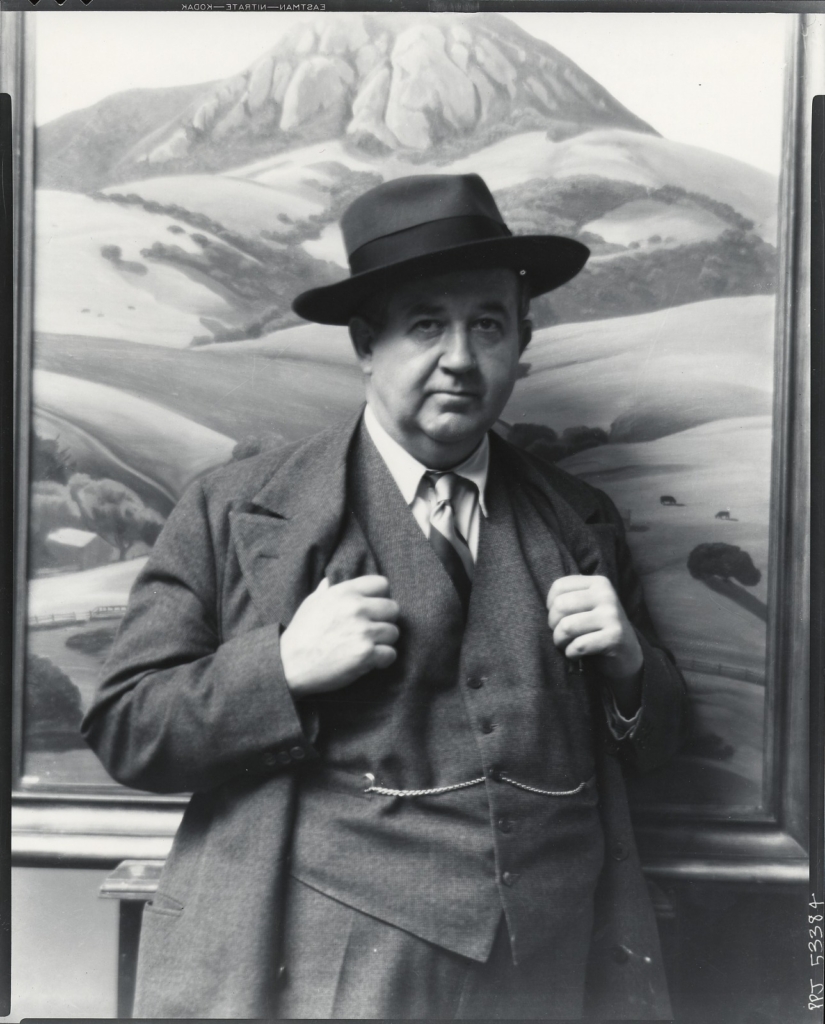
When the Civil Works Administration announced the availability of funds for the employment of artists through the PWAP to create public works of art, New York City naturally became a locus of interest since the City was, as it still is today, the art capital of America. New York City remained prominent in the Federal arts programs throughout their lives. In late 1937, for instance, New York employed through the Federal Art Project 44.5 % of all artists participating in that program.[14] Mrs. Juliana Force, the director of the Whitney Museum of American Art, was chosen as the regional chair of the PWAP.
The administration of the project in New York witnessed some controversies, which arose elsewhere as well. Forbes Watson, the technical director of PWAP, expressed at its outset its ambition to allow the artist “complete freedom,” without its procedures constraining the artist’s imagination to academicism on the one hand or radicalism on the other.[15] But this expression of intent did not carry the day in every region in every case. This should have surprised no one since art is, and throughout its history has been, often controversial, and the sensitivity of the public about the aims and quality of art was naturally heightened when public monies were being spent on the creation of art during a national crisis, at a time when the need for such funds was deep and widespread.
One controversy in New York concerned differences over aesthetic tendencies, with critics expressing concerns about the risk of favoritism on the part of Mrs. Force for modernist artists over traditional ones and the exclusion from the administration of representatives of traditional groups. On the other hand, there were artists who felt themselves unduly constrained by what they perceived as PWAP’s objections to abstraction.[16] Another dispute, perhaps fed by some confusion or uncertainty in Washington, had to do with the extent to which talent and skill should be important factors in the awarding of PWAP jobs. Edward Bruce specified a dual standard for the selection of artists: the artist had to be in genuine need and professionally competent. He wrote to Mrs. Force at the outset of the project that a phase of “this work, of course, is to put men to work, but I think that we ought all remember that we are putting artists to work and not trying to make artists out of bums.” He saw PWAP not as a relief measure, but as a public works program to employ artists to make public buildings beautiful. The tension or uncertainty around this issue was never perfectly resolved in the brief life of the PWAP.[17]
There was also a controversy over politics, with militant artists picketing and protesting at the Whitney and in the streets.[18] The leadership of the PWAP specified that artists were to interpret the “American scene” and so foreign subjects were to be avoided. “The goal of the PWAP was a permanent record of the aspirations and achievements of the American people.”[19] Some artists sought to present radical visions of American life that were out of keeping with the ethos of the leadership and there were some controversies about such works elsewhere in the country as well.[20] According to one scholar, however, “[t]he large majority who received PWAP checks did not feel compromised by conforming with PWAP’s definition of the American scene.”[21]
The Artists Union in New York protested against what it considered to be unreasonable limitations upon the number of artists who could be employed, but there were real difficulties, with the quota of positions for the New York region in February 1934 being 500 artists, although 4,000 artists had registered with the program in Manhattan alone.[22] The need was greater than the funds available.
The Public Works of Art Project lasted for only about six months, through June 1934, although ad hoc arrangements were made to finance the completion of work that was not finished at the formal end of the Project. During this brief period, over 3,700 artists received checks and in return produced 15,663 pieces of art and craft. Although that is a significant reach for a program in operation for such a short time, most of the artists in need of employment in America were not helped by PWAP and of those who were, about 50 % were non-relief. No direct means tests were used to administer the program.[23] These limitations or shortcomings, if you will, presaged a broader relief-based program to come.
Murals constituted only a small percentage of the work of PWAP. Although there was great demand for murals, there were a limited number of experienced muralists. Nevertheless, murals received attention far out of proportion to their number. The mural was, after all, well suited to fulfill the objectives of the program, being art that serves to decorate what is often public space and thus art that can be available on a permanent basis to the public in a way that other art will not be. Art project rules – – and of course there were rules – – allowed artists to decorate any public building, federal, state or local. “Government art became chiefly mural art in the public mind.” [24]
The Treasury Section of Fine Arts
Aid to art was also supplied during the Depression through the Section of Fine Arts in the Treasury Department. The Section, which was inaugurated in October 1934, after the end of the PWAP, and was again under the leadership of Edward Bruce, sponsored and oversaw the decoration of new federal buildings, including office buildings and many post offices, with an emphasis upon assuring the quality of the art produced. An emergency program for the construction of courthouses and post offices across the country was in place under the control of the Treasury Department, which had historically had responsibility for such construction. Secretary of the Treasury Henry Morgenthau issued an order that one percent of the total cost of each building would be allotted for decoration, and this was intended to provide the financial underpinning for the Section of Fine Arts. The artists who obtained the work would be assigned contracts, as in any other job involved in the construction of federal buildings, and thus would be independent contractors and entrepreneurs. This method of administration meant that this art program could be viewed as a part of doing what the government had always done, building and decorating federal buildings, now merely on a different scale; thus, the effort could be seen as being not truly, or at least not primarily, a matter of relief, which made it more palatable to the public and to political forces opposed to or doubtful about the New Deal.[25] In contrast, the Federal Art Project, which I will discuss shortly, distributed work on the basis of financial need and its artists were employed directly by the government. The Section’s artists for the most part worked alone in their studios whereas artists of the Federal Art Project were often assigned to a group supervised by a master artist.[26]
Despite the loftiness of its aims and its undoubted successes, the story of the Section of Fine Arts is also one, in part, of complicated bureaucratic wrangling and inter-agency discord, including continuing tension between the Section and the Works Progress Administration, discussed hereafter, which must have been quite disheartening to those seeking to advance the arts in America while assisting artists during these challenging years. [27] Obtaining financing for the Section was an ongoing challenge, which produced budgetary uncertainty. In practice, Secretary Morgenthau’s order resulted in the production of funds for the decoration of only about a third of the new buildings.[28] Even taking into account the difficulties in obtaining funds, however, “the Section,” one scholar concludes, “placed before the nation an impressive amount of mural, sculptural, and other art.” [29] The Section sponsored about 1,116 murals and 300 sculptures in federal buildings around the country.[30] The fact that the President, his wife, Secretary Morgenthau, and his wife all believed in the effort helped to protect the Section and its work.
A central feature of the Section’s administration was the competition. Before World War II diverted resources from this work, the Section sponsored 190 competitions in which 15,426 artists submitted 40,426 sketches.[31] The juries were mostly local, but they did not have final word on the winners; that was up to the Section staff in Washington. The Section encouraged initiative and action on the part of the local juries and urged them to seek out artists from the area involved or nearby to take part in the competitions and to solicit ideas from the members of the local community. The sketches of the competing artists would be reviewed anonymously, by the local jury and by Section staff in Washington. The staff would tend to approve the selection of the jury if that selection met the Section’s standards of quality and competence.[32]
Most of the work commissioned by the Section was not actually arrived at by awards to artists who prevailed in the competitions. Although it held 190 competitions, the Section eventually awarded 1,371 commissions. Most of the commissions awarded without competition went to artists who had impressed the staff of the Section by submissions in previous competitions.[33]
The use of competitions avoided favoritism and political interference in the assignment of contracts. It also gave opportunities to young and unknown artists. At a time of ideological conflict, the Section was able to and did assign projects to artists of every political persuasion. The Section was a failure when it came to assignments to African-American artists. It did, however, award many commissions to women; about one-sixth of the artists working for the Section were women. The Section also made special efforts to commission Native American and western artists who had not previously been recognized by the government.[34]
The Section supervised the work of its artists, including through the evaluation of commissioned work as it progressed, and at least one scholar asserts that the Section limited the freedom it afforded to these artists. Thomas Hart Benton, the great American Regionalist, was invited a number of times to work for the Section, but never did. He wrote to an administrator there in 1936:
If you can ever give me a contract in which all responsibility is mine, in which I am completely trusted to do a good job and over which no one but myself has effective rights of approval or disapproval I’ll work. Otherwise, I can’t be sure I’ll do a real piece of work.[35]
The Section sought art of quality and defined quality in a more or less traditional way. This meant that it excluded abstract and otherwise avantgarde work and favored realistic, representational work. It sought to advance a contemporary American art that was neither academic nor avantgarde, one that could be accessible to the general public. Thus, the art it produced was not at the leading edge of the currents in the art of the world of the time.[36] This fact has been the basis for criticism. But, some scholars observe:
To some, the Section’s art may seem to promote a middle-class, consensus view of the world, but in the 1930s … this positive vision reflected a confidence in the possibility of change. It was not a picture of the status quo but of a society undergoing fundamental improvement….[The art of the Section] was … true to the widespread belief that progress, based on the work, the efforts, and the faith of “the people,” would win out.[37]
The Section’s work revealed a tension between fine art and democracy. The Section did not want to impose art upon the people that they might find incomprehensible or offensive. This was illustrated by the exclusion of abstract painters, but also by the struggle that manifested itself more than rarely between the vision of the artist and the will of local or national committees that reviewed it.
While the Section strove to produce art of quality, it eschewed elitism in the sense that it did not confine its endeavors to the cities, where art had been most concentrated in the past. It was committed to making art a reality of daily life in small towns and rural areas across the country as well. A mechanism for achieving this end was the decoration of 1,100 new post offices across the country. The post office in those days was an important institution, often located on the main street in town, where ordinary citizens conducted normal business. It provided an ideal venue for the art the Section endeavored to promote. The Section sought to and did sponsor murals for these locations that would represent or reflect the lives, history, and concerns of the local community rather than themes that might be of interest to the great and remote national government.[38]
The Treasury Relief Art Project
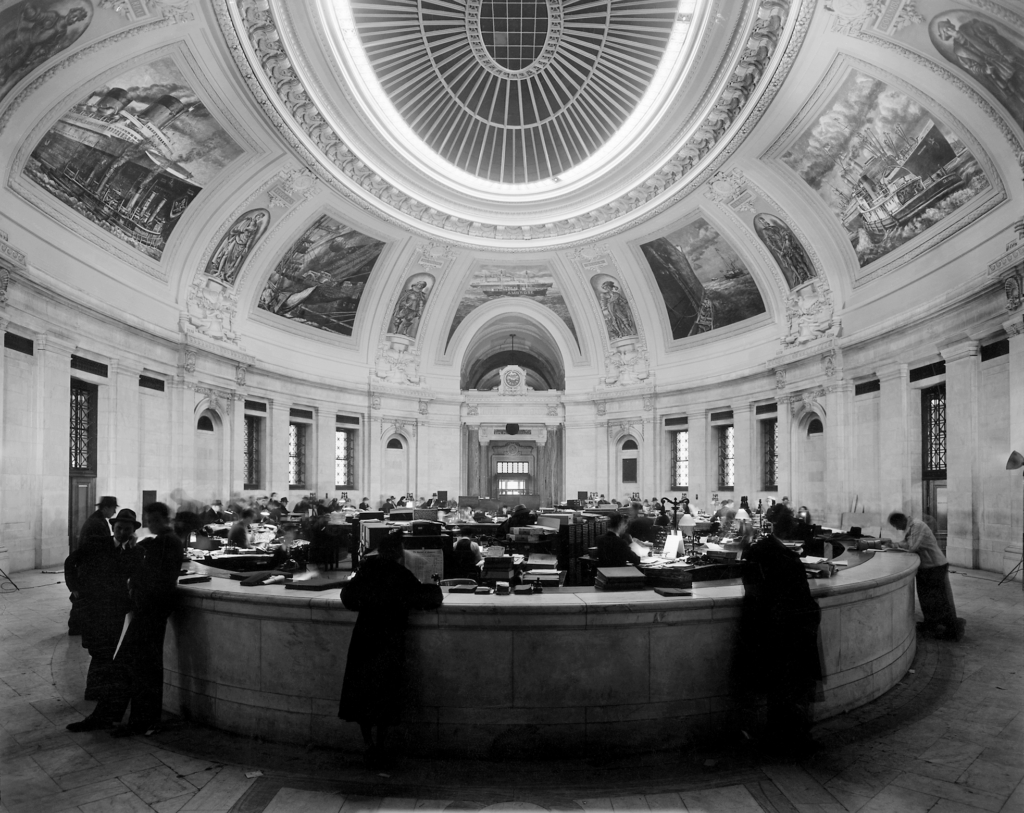
By late 1934, the Roosevelt Administration was actively studying ways to address the need for more effective national relief. The Works Progress Administration emerged out of these deliberations, as explained hereafter. Treasury, which had not concentrated on relief programs, did not want to undertake a large relief art project on the scale propose, particularly as it was to include music, drama, and writing. So, the WPA proceeded as the vehicle for programs of artistic relief. When the Section of Fine Arts in Treasury indicated that it could handle additional funds, the WPA made a grant of funds to Treasury in July 1935 for the decoration of federal buildings. These funds were to be expended by Treasury, not under the rules that applied to the Section of Fine Arts, but under the same rules as were applied by the WPA. This led to another effort within Treasury, which was called the Treasury Relief Art Project, the TRAP. Seventy-five percent of those employed by TRAP were on relief. The number of persons employed by this project was considerably smaller than those employed by the initial Public Works of Art Project.[39] Most of the work done by TRAP artists was for post offices,[40] although certainly not all; one of its most challenging and successful efforts was the decoration in fresco secco of the dome of Cass Gilbert’s Custom House on the Battery by Reginald Marsh, who, in 1937, with the aid of eight assistants, painted very impressive and dynamic harbor scenes and pictures of explorers.[41] One scholar calls these murals, which cover about 2,000 square feet, “by far the greatest achievement of the TRAP and quite possibly one of the most comprehensive and successful mural schemes carried out under the New Deal projects.” [42] An illustration of the kind of political pressure that artists working in the federal projects could encounter was the complaint made to the Secretary of the Treasury by the Chairman of the United States Maritime Commission, Joseph P. Kennedy, that Marsh was depicting foreign vessels, including the Queen Mary. To their credit, Secretary Morgenthau and Mr. Bruce stuck with Marsh’s designs.[43]
The Federal Art Project of the WPA
The principal federal project supporting art and artists was the Federal Art Project of the WPA. The Federal Art Project came into being in the following way. In late 1934, Harry Hopkins urged that President Roosevelt put in place a better relief program than that then in existence. The administration worked on creating such a program over the winter of 1934-35. Legislation aimed at achieving this goal was proposed and it was enacted in spring 1935. The Works Progress Administration was established later that year as the bureaucratic entity charged
with carrying out the relief program. The WPA was intended to help workers doing work on what might be called a mass scale, such as construction workers. At its height, the WPA employed millions in improving the public infrastructure, such things as parks, roads, schools, and bridges. But the WPA was also to provide assistance to creative workers. Four separate units were established within WPA to provide support for artists, actors and theater workers, musicians, and writers. The Federal Art Project was the entity that addressed the needs of the artistic sector and artists.
Holger Cahill, who, among other things, had served as acting director of the Museum of Modern Art in 1932-33 and who had had a highly unusual, peripatetic, and adventurous life as a young man, was selected by Hopkins to be the director of the Federal Art Project,[44] which turned out to be an inspired choice. Cahill proved to be an effective administrator and skillful at avoiding the risks inherent in his position at the top of a public arts agency at a time when the public might be expected to harbor some concern about the practicality and utility of aid to artists. Cahill sought to give artists a place in American life and to persuade the broad public that they were getting something of real value in return for the government funds expended on art. Cahill said that “[h]is guiding principle . . . was to make a connection between art and daily life.”[45]
Looking to murals alone, Mr. Cahill reported in 1937 that in the first year of the Federal Art Project, 434 murals had been completed, 55 were in progress and sketches were being prepared for a great many others, with hundreds of requests for other murals pending and waiting lists in every section of the country.[46] By the end, the Federal Art Project produced 2,566 murals, as well as a great deal of easel painting, sculpture, designs and other art objects.[47]
The relief support programs provided for artists by the WPA’s Federal Arts Project received and distributed much more money, aided far more artists – – perhaps ten times as many – – and brought a great deal more art to the public than did Treasury’s Section of Fine Arts. The Section aimed to improve the economic situation for American artists and to enhance the artistic understanding and taste of the American public, but sought to achieve these things through the provision of the best art possible for federal buildings; as noted, the Section, in the words of one of its administrators, “was not set up to engage in widespread relief”[48] and sought to obtain a portion of construction funding for art to be placed in the buildings. The emphasis of the Federal Art Project was somewhat different because it developed as a part of the government’s larger program of public relief and relied for its financing upon relief funds. The principal concrete objectives of the Federal Art Project were to provide support for persons facing severe financial hardship and to preserve their skills, while contributing to a more artistically sensitive and informed public and presenting worthwhile art. Its leadership tended to emphasize, or emphasize more strongly, the encouragement of production of numerous works rather than fewer works of “high quality,” as did the Section, a standard that in practice was not always easy to implement. Holger Cahill believed that the making of a connection between art and daily life could better be achieved by aiming to produce much art, which could stimulate from artists much good, and even some great, art, rather than by favoring a select group of the “best” artists,[49] as the Section of Fine Arts was thought to do. Even so, the director of the Federal Art Project struggled to address the problem of artists of limited competence. If an artist was given a chance to demonstrate ability, but clearly failed to do so, then, the director believed, he or she ought to be moved into different but useful projects.[50] The Federal Art Project was better known and, in some quarters, more controversial than the Section.[51]
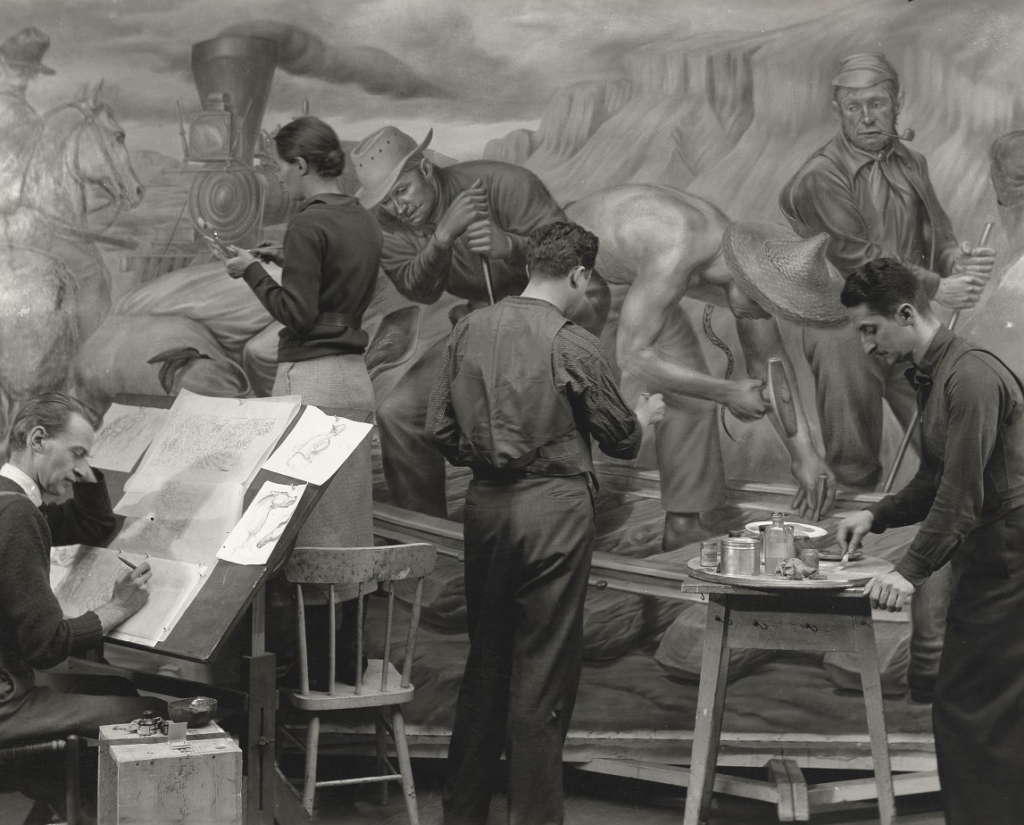
One of the administrators of the Treasury art projects reflecting years afterward on his experiences stated that “a healthy rivalry developed between the WPA [the Federal Art Project] and ourselves which stimulated each of us to outdo the other.”[52] He elaborated:
We … suggested that the Treasury was after “quality,” while the WPA offered “relief,” but the public has never made any distinction whatsoever. You still hear remarks about those WPA murals in post offices; and as to quality, both programs produced fine jobs. In fact, the inclusive net of WPA employment quite often achieved first rate results. It cost more, but then that money would presumably have been spent on relief anyhow. [53]
Beyond these differences in vision, or at least in tendencies, was a difference in administration. One scholar opined that one of the great advantages that the Federal Art Project had was that it had practicing artists supervising the activities of the various divisions of the organization, rather than well-intentioned, but inexperienced bureaucrats. The head of the Art Project’s mural division in New York, for instance, was Burgoyne Diller, who was an abstract artist “who showed an almost fatherly concern for the artists under him and great skill at turning bureaucratic regulations and restrictions to their best advantage.” [54]
The Federal Arts Project had a more dependable fiscal footing than the Section, but its future was nevertheless always in some doubt. Cahill believed that if Hopkins and Mrs. Roosevelt were to lose interest in it, the second tier of WPA administrators might undermine it. The Project had this in common with the Section of Fine Arts – – it was heavily affected by bureaucratic maneuvers and squabbling.[55] One scholar states that “[a] sizeable part of the New Deal art story concerns colliding empires, federal-state conflicts, and petty outrages of a thousand sorts.”[56] A persistent problem was the fact that the Federal Art Project necessarily had a different professional ethos than that which animated the WPA generally. As the WPA had been designed to address relief for large numbers of people engaged in mass activities, such as construction projects, its patterns of employment and rules often fit uncomfortably with the work of artists. It did not easily accommodate “workers” who had never been involved in mass projects or subject to industrial discipline or standardized commercial requirements and many of whom worked as individuals. Early on, for instance, Cahill had to bring to Hopkins’s attention the unsuitability of a WPA rule that placed artists on a working schedule overseen by a timekeeper, who would conduct random inspections from time to time. Hopkins approved Cahill’s experimenting with an honor system for artists, in which artists were judged not on how many hours they put in, but by their completion of projects on a reasonable schedule, but administrators in the states in question demanded a return to the rule out of fear that they might be blamed for a waste of funds.[57] One can easily imagine the fury with which Michelangelo would have reacted to any similar rule.
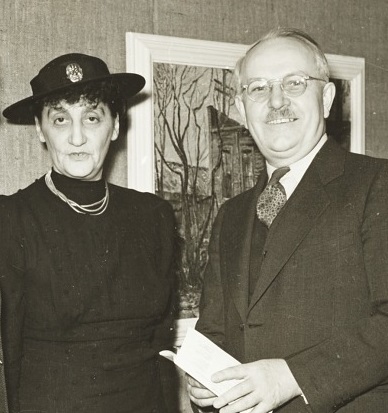
Audrey McMahon, who served as regional administrator of the Federal Art Project in New York City, New York State, New Jersey, and, briefly, Philadelphia, remembered decades later a period when the Federal Art Project operated “under the thumb,” as she put it, of the WPA administrator for the area. This administrator disliked the Art Project and did not understand it or art or artists and held a deep belief that creating a painting was not “work.” He also believed that the art projects were centers of extremism, which it was his duty to “clean up.”[58] Mrs. McMahon stated that he and she were diametrically opposed and, “looking backward, I realize with a certain amount of joy that I must have been as great a burden to him as he was to me.”[59]
In view of the relief nature of the Federal Art Project, it was in the early days required that 75% of the artists employed by it be on relief, a figure that was later increased to 90%. This created difficulties for the administrators, who needed some flexibility to be able to find technically competent supervisors for the large mural, sculpture, and other projects and experienced artists able to provide leadership to the less experienced. To receive relief, artists had to meet a “needs” test, which sometimes caused real hardship. Adding to the challenges was, in Mrs. McMahon’s words, “a horrifying uncertainty as to the duration of Project employment, which … seeped down to the artists, [and] was vastly detrimental to their efforts and morale.” [60]
The WPA was built upon a principle of cooperation between the federal government and state and local government, which contributed part of the costs. This arrangement made sense politically, but it also led to many quarrels and administrative difficulties for the Art Project.[61] Holger Cahill did his best to refrain from interfering with the style and subject matter of the artists’ work, including the muralists. There were, however, notable instances of controversy when local agencies or the press found fault with the subject matter, artistic purpose, or style of work done by muralists in the Federal Art Project. [62]
There were also many disputes over the years between the federal programs and artists unions over the number of available jobs and government rules. One of the Treasury administrators confessed years later that, in his opinion, “[i]t was grotesque and an anomaly to have artists unionized against a government which for the first time in its history was doing something about them professionally.” [63] Mrs. McMahon took a more charitable view of the matter. The unions made the administrators’ work more complicated, but, in her opinion, their basic purpose was similar, if not identical, to hers. Still, the fact that they were often on the same side of the issue “did not serve to soften many bitter encounters.” [64] The activities of the unions, which included picket lines, sit-ins, strikes, and building takeovers, also “did not help the image of the Project in the public eye.” [65]
For all of the difficulties encountered, however, Mrs. McMahon reflected on the Federal Art Project decades afterward with some satisfaction:
That we had a political administration which subscribed to [the idea that work was both essential and a good way of life], and would not humiliate us with a dole, but offered us a chance to ply our crafts, was the most wonderful possible circumstance, and that there were public places where the fruits of our labors were wanted and, indeed, needed, was balm to our souls. So, naturally, we did the best we could, and that best was very good. [66]
A historian, who presumably was more disinterested, looking back from the perspective of 1968, wrote that the federal art projects were
effective in aiding both established and unknown artists during a time of economic crisis, imaginative in their support of all areas of artistic endeavor and, most significant of all, productive of some of the best art of the decade.
He concluded that “these projects constitute a major turning point in the cultural history of our nation ….” [67]
The WPA and the several federal arts programs came to an end by spring 1943, at which time, the country being at war, unemployment had ceased to be the grave problem it had been during the height of the Depression.
The art projects had important effects on mural art in America. They stimulated a revival and intensification of interest in mural painting in the United States. Such interest had begun to develop in a serious way in the second half of the 19th century, at which time the work of John La Farge was highly influential, and in the early years of the 20th century a group of able artists specializing in mural painting had emerged, including Maxfield Parrish, H. Siddons Mowbray, and Edwin H. Blashfield. Mowbray, whom I will come back to later, and Blashfield were among ten leading painters who contributed to create the spectacular murals that adorn the courthouse of the Appellate Division, First Department on Madison Avenue in Manhattan, which opened in 1900. In the 1920’s, mural art in America was given a boost when the government of Mexico supported public mural projects that became well-known and influential, including the work of Diego Rivera, Jose Clemente Orozco, David Siqueiros, and Rufino Tamayo, and some of the leading Mexican muralists spent time in the United States, which helped to disseminate the influence of Mexican mural painting around the country. The Museum of Modern Art presented an exhibition of the work of 35 painters in 1932 that emphasized and elucidated the importance and value of mural painting.[68] From the days of the Civil Works Administration, the opportunities for artists to work on murals and their interest in doing so saw “continuous and dramatic” development.[69]
Some of the new energy favoring murals in the 1920’s through the 1940’s was a reaction against and away from the traditional line of mural decoration, which, in the eyes of some critics and painters, was excessively sentimentalized, overly ornate, almost baroque in its approach to themes and style. Whereas older muralists were often given to elaborate and complex allegorical representations of highly idealized, sometimes historically inaccurate, grand themes, such as in the case of The Apotheosis of Washington by Constantino Brumidi in the dome of the U.S. Capitol Building, some newer muralists wished to paint in a modernist representational style that was not highly idealized though not strictly realistic, as in the cases of Orozco and Rivera or in the flowing paintings of the Midwest of Thomas Hart Benton and John Steuart Curry, or, in some cases, those of Siqueiros, Tamayo, and Stuart Davis, for instance, in an abstract expressionist manner. There was also a desire to pursue themes that were more reflective of the realities of social life and of history. Some of the new muralists, such as Rivera, Siqueiros, and Davis, were advocates and practitioners of a highly politicized and controversial art, and both Benton and Curry encountered criticism when they painted murals about parts of history that were uncomfortable for their neighbors.
A great deal of work in murals, including those at the New York County Courthouse, was achieved through the art projects. The PWAP, the Treasury programs, and the Federal Art Project produced over 4,000 murals between 1933 and 1943; close to 400 of these were executed in New York City and State.[70] A large number of murals were created for the World’s Fair in Flushing Meadow in 1939-1940, although only a small number were sponsored by the Art Project because of its requirement that its art had to be permanently allocated to public buildings.[71] Over 60 % of the murals painted in New York under the Federal Art Project were on canvas, whereas the Fine Arts Section of the Treasury preferred fresco, as there was a desire to follow the lead of the Mexicans,[72] as well as traditions going back many centuries.
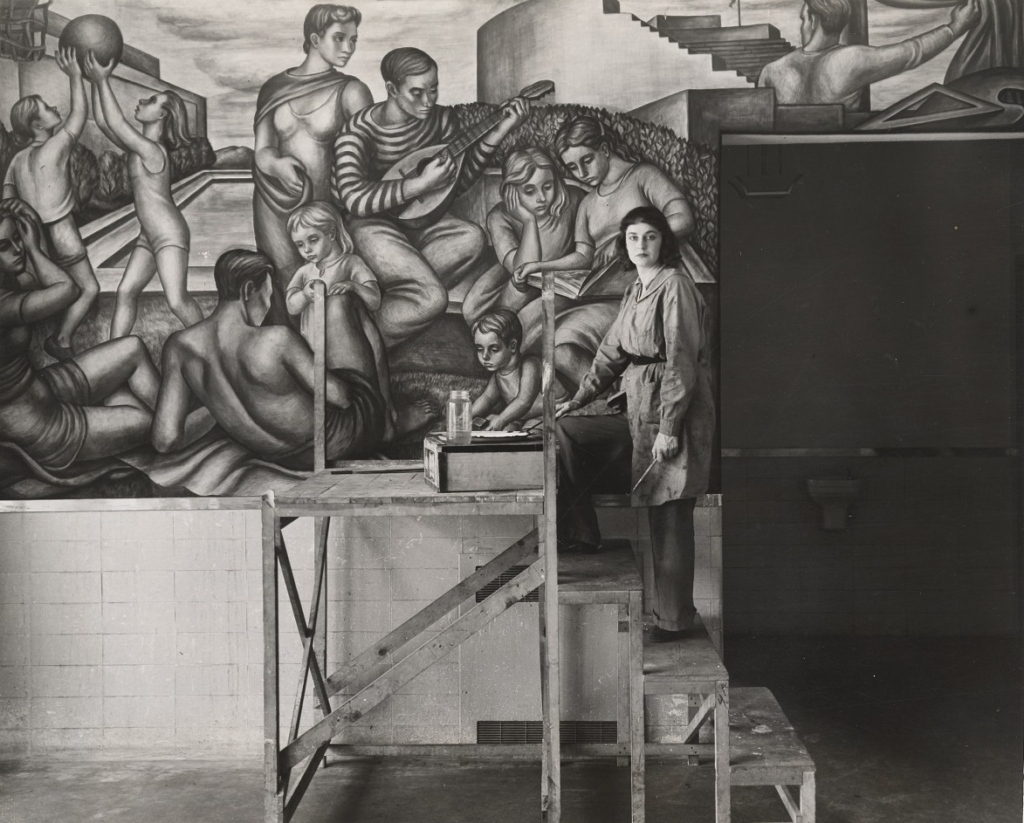
A variety of styles were employed in these works. At Newark Airport, Arshile Gorky did ten huge panels covering over 1,500 square feet of canvas in an abstract style on the theme of “Aviation” (1937). This was thought to be the largest abstract mural created under the Federal Art Project. James Brooks painted a mural, entitled “Flight,” in a blend of abstract and figurative styles for the Marine Air Terminal Building at LaGuardia Airport. Completed in 1942, this work covered a vast space, 2,820 square feet. Marion Greenwood, who, among other things, had studied with Orozco and Rivera in 1932 and worked in Mexico, painted a fresco for the Red Hook Houses in 1940, “Blueprint for Living,” that was influenced by the Mexican style. One of the most ambitious of the murals done under the Federal Art Project in New York was Edward Laning’s mural for the Aliens’ Dining Room at Ellis Island. This work, completed in 1937, was entitled “The Role of the Immigrant in the Industrial Development of America.” Painted in a dramatic, naturalistic style, it covered 1,000 square feet of canvas. The artist, who later, in 1940, did celebrated murals for the Art Project, “The Story of the Recorded Word,” that today lend beauty and an appropriate dignity to the McGraw Rotunda at the New York Public Library’s Schwarzman Building, obtained the commission for the Ellis Island project after the government bureaucrat in charge of the location had rejected the sketches of a predecessor and brow-beat him into withdrawing. [73]
C. Federal Support for the Murals at 60 Centre
Once it became clear in December 1933 that funds would be available from the then-new PWAP to pay the principal artist and his assistants, the Municipal Art Society of New York City submitted the murals project of the New York County Courthouse to the PWAP for its consideration. The proposal, which at that point was directed only to decoration of the vestibule of the building, was approved by Mrs. Force, the PWAP regional director. The murals project at the County Courthouse reportedly made the edifice the first public building in New York to benefit under the PWAP program,[74] which is to say, the first to receive assistance from a Federal art program. There does not appear to have been controversy about the artist who would preside over the work. Who received jobs was often a source of disagreement under the Federal Art Project and to a lesser degree as well in the case of the Treasury’s programs, which, as noted, relied upon competitions precisely to limit criticism of its selections and avoid importunities from influential artists or their sponsors with political connections. In the case of the courthouse, the circumstances were different, the artist having been chosen by the architect and preparatory work for the murals having been done before the courthouse had opened in 1927. When the application for approval was made, the sketches and models that Mr. Pusterla had done prior to the courthouse’s dedication were dusted off and resurrected and he was understood to be the person for the job.
The mural project, because it involved changes to the interior of a building owned by New York City, had to be approved by the Art Commission of the City of New York (today known as the Public Design Commission). On January 9, 1934, Samuel Levy, the Manhattan Borough President, and Mrs. Force on behalf of the PWAP submitted an application for approval of decorations for the vestibule of the courthouse. The application was received on the same day it was signed and preliminary approval was granted that day (so much for the customary bureaucratic delay).[75]
It is appropriate here to note of the New York City Art Commission that
[i]n general it was liberal and cooperative, and its painter-member, Ernest Peixotto, was open to new ideas and young talent [and, in the case of Pusterla, senior talent too]. Most important, the artist was free to develop his work on his own beyond the sketch stage …. The result was a dynamic and productive mural division which produced a number of major murals in various styles ranging from the naturalistic to the abstract. [76]
The proposed project was also submitted to the judge who chaired the Court House Board, which approved the proposal. A room in the courthouse was then set aside for Lowell’s architectural assistant and Pusterla and the team of assistants, who were to help with the work and some of whom were to aid in executing the designs under Mr. Pusterla’s direction.[77] Thus, by early January 1934, only weeks after the inaugural meeting of the PWAP in Mr. Bruce’s house, the work was ready to proceed.
Although the principal financing for the project was through the government agencies mentioned, contributions for materials and equipment were made locally by the public.[78]
With funding available (although uncertain) to pay the wages of Mr. Pusterla and his assistants and with approvals having been received, the process of creating the murals began. Work commenced on January 8, 1934 in the vestibule, with Pusterla and seven assistants present and with a plan for the hiring of additional assistants soon thereafter.[79] In February 1934, it was reported that 30 assistant muralists or laborers or assistants of other types were at work on or in connection with the murals.[80] The top salary paid in the New York district by the Civil Works Administration was reported to be $ 34 per week.[81]

I do not know the identity of those who directly assisted Pusterla in the painting of the murals, but it has been written that at least some were students of his from the Leonardo da Vinci School,[82] where he taught, probably immigrants in at least some instances, like Pusterla himself, since the school was directed toward providing education in art for laborers and immigrants at little cost. That Leonardo colleagues or students would be appointed to these positions seems logical since Pusterla would have had personal experience with their talents gained over time. In order to receive an assignment from the PWAP and its later successor, the Federal Art Project, however, these assistants would have had to register and comply with government requirements, meaning that in the case of the Federal Art Project they would have had to have been in need and show competence in painting.
By April 20, 1934, the work on the vestibule was nearing completion, with two more weeks expected to be necessary to bring the work to a conclusion.[83]
As the work began on the vestibule, Pusterla and others involved no doubt hoped that funding would develop to carry out more extensive work elsewhere in the courthouse, but he was compelled to await developments as the funding story evolved. The aspirations for extensive painting in the courthouse must have been clouded in uncertainty, and this must have caused Mr. Pusterla considerable anxiety. The ceiling over the rotunda would have obviously presented by far the greatest source of worry for Mr. Pusterla and his assistants. In time, though, funding was found for the entire project.
After the vestibule was completed, the main, colonnaded corridor, which runs from the vestibule to the central hall, was the next area of work. The ceiling over the colonnade consists of two vaulted barrels and a dome. On April 11, 1934, Borough President Samuel Levy, with the endorsement of Mrs. Force (who noted, however, that the PWAP would soon come to an end), submitted an application to the Art Commission seeking approval for the decoration of the corridor. Preliminary approval was granted on May 8, 1934[84] and the painting was executed.
Work on the main corridor was perhaps followed by the decorative painting on the ceilings in the corridors on the first floor and on the ceilings of the second-floor corridors, namely, the area adjacent to the elevators running around the circumference of the main hall on the first and second floors, the five radiating corridors on the first floor running from the circumference of the main hall to the outer areas of the building, where courtrooms and offices are located, and the five radiating corridors on the second floor.
In September 1935, the murals project at the courthouse came under the jurisdiction and the supporting hand of the Federal Art Project of the WPA. Borough President Levy submitted an application to the Art Commission on October 3, 1935 seeking preliminary approval for a mural, that was to be entitled “The Law Through the Ages,” to be painted on the ceiling of the rotunda. Accompanying the application was a model of the ceiling, scaled one inch to the foot, that was decorated with the design the artist envisioned for the mural. The Commission gave that approval on October 8, 1935.[85] The Commission required that Mr. Pusterla consult with the Painter Member of the Commission, Ernest Peixotto, in the continuing development of the designs, that full-sized drawings of the designs as they developed be submitted to the Commission before the final work was to begin, and that final approval be sought before the mural was installed.[86]
Thereafter, Mr. Pusterla began the painting of the dome. This formidable undertaking, which involved the execution of a single painting rather than a series of separate but related panels, was said to be the largest work supported by the Federal Art Project in New York[87] and must have been one of the grandest ever executed under any of the art projects in the entire country. The Art Commission gave final approval to the designs in 1936[88] and the Federal Art Project’s mural division would have given its approval as well. It was anticipated that the murals on the first floor would be completed by July 1, 1936,[89] but that estimate proved to be optimistic, as so many estimates do. By March of 1937, some touch-up work still remained on the principal mural on the first floor and it was expected that the unveiling would occur within a few weeks’ time.[90] After the work on the first and second floors, murals were completed elsewhere in the courthouse, as I explain hereafter.
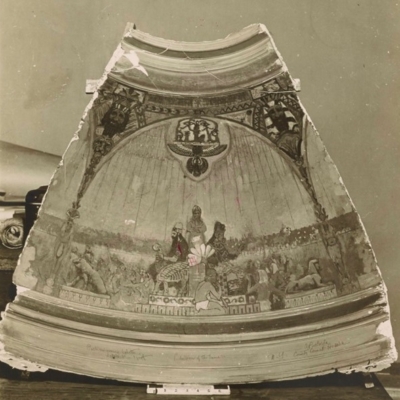
D. The Principal Artist
Attilio Pusterla, the principal artist and supervisor of the mammoth mural project at the New York County Courthouse, was an experienced painter, who had spent much of his life, but not all, as we shall see, working in that profession, for many years in Italy. He turned out to be a good choice for the challenging assignment.
The Life of an Italian Painter
Pusterla was born in Milan in 1862.[91] From 1878 to 1880, he attended the august Academy of Fine Arts of Brera in Milan, where he studied design, perspective, painting, and other subjects and where he became friendly with other artists associated with Brera who in time made names for themselves, such as Angelo Morbelli and Emilio Longoni. Thereafter, Pusterla spent several months at Lago Maggiore as a guest of a friend. He returned to Milan in 1883 and had his debut as a painter at Brera, where he presented four pictures. He exhibited at the International Exposition in Rome in 1883 and took part in exhibitions in Venice and in Milan in 1886. One observer in 1889 referred to his work as “very successful and praised,”[92] but, as we will see, his professional story was complicated.
Some of his friends, including Morbelli and Longoni, and other emerging artists such as Giovanni Segantini, Gaetano Previati, and Giuseppe Pellizza da Volpedo, became supporters and practitioners of a new artistic movement known as divisionismo (“divisionism”). This was a painting technique and philosophy, much influenced by science, in particular, advances in the understanding of human sight and how the eye perceives images, that looked on light as the foundation of artistic vision and sought to emphasize luminosity by setting forth bits of color closely together on the canvas rather than mixing the colors on the palette. This new technique “placed the rendering of light at the center of the act of painting …. “ [93] It took its name from its desire to “divide” colors rather than mix them on the palette, with the mixing instead taking place through the eye of the viewer. Various of the leading exponents and practitioners of the movement sought also to give content to a social and political vision in an Italy that had only recently been unified and was undergoing notable change and development.[94] This movement was influenced by, but differed somewhat from, “pointillism” in France. Whereas paintings in the latter mode used dots of color, the divisionists sought to apply small, narrow strokes of the brush.
Pusterla was taken note of by Vittorio Grubicy de Dragon, a painter, gallery owner, critic, and advocate for “divisionism,” and drew close to the circle of painters working in that style.[95] Pusterla sympathized with his friends, including in regard to their interests in the conditions of society, such that today, at the permanent gallery il Divisionismo in Tortona, Italy, three of his paintings form part of the collection.[96]
Pusterla developed an interest in expressing views of daily life in paint and documenting the social life of his time. As he progressed in his career, he become increasingly committed to an arte sociale, social realism and politically engaged art, not in the mere depiction of life and events. One scholar says of him that he was tied by anarchist/socialist sympathies to social realism as a manner of expression.[97]
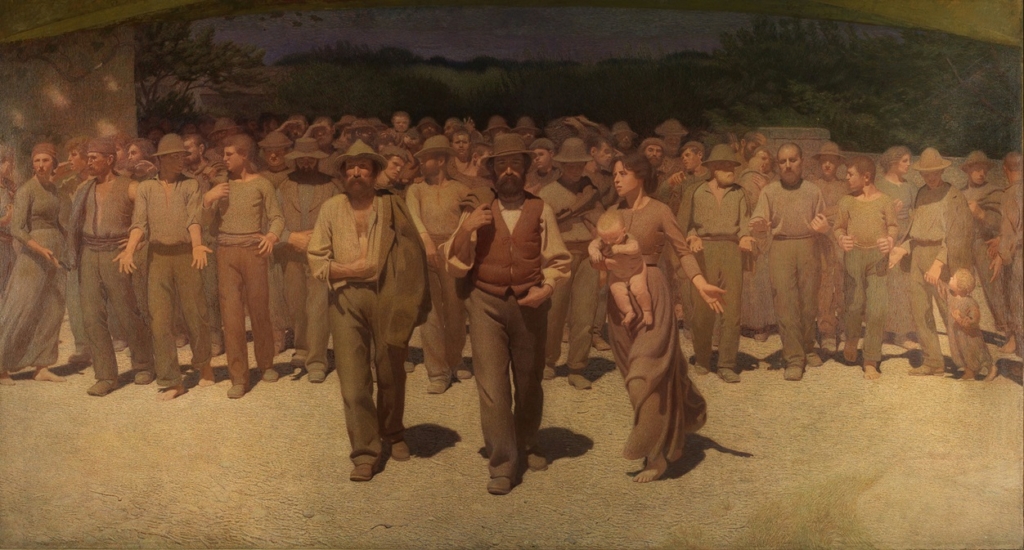
In his interest in social art he resembled others of his colleagues, such as Emilio Longoni in his Oratore dello Sciopero (1891) and Pellizza da Volpedo with his impressive masterpiece, Il Quarto Stato (“the Fourth Estate”) of 1901, today in the Galleria d’Arte Moderna in Milan. In this latter work, which is both beautiful and powerful, the painter shows a group of workers on the march to advance their economic rights.[98] The painting is notable for the balance of the composition and for the genuine dignity with which it invests the workers and the calm nature of their action. Pusterla’s increasing passion for this kind of painting is evident in his Poor People Begging, exhibited in Milan in 1885, well before Il Quarto Stato was finished, and today part of the collection of the Gallerie d’Italia.[99] In 1886, he presented paintings at an exhibition and at the Brera. He was associated with the Societa` per le Belle Arti ed Esposizione Permanente in Milan from 1886, when the Society opened a palazzo where it held exhibitions of fine art (known as “the Permanente”), until his departure from Italy.[100]
Pusterla also worked as an illustrator. In 1887, he provided watercolor drawings for a book of poetry by a friend. He also did some illustrations for journals, including Lotta di Classe (“Class Struggle”), the journal of the Socialist Party, and the cover for the Socialist Almanac in 1897, which reveal something of his political leanings.
Pusterla generated a great deal of attention with his presentation at Brera in 1887 of a large canvas entitled Le Cucine Economiche di Porta Nuova. In this work, Pusterla documented an aspect of the life of the poor and workers in Milan by depicting them eating food at a soup kitchen that had been constructed near the Porta Nuova a few years before, in 1883. In this period Italy was undergoing industrialization in the north, in and around Milan and Turin and elsewhere, the factories of which attracted many workers from around the country. Working conditions for these laborers were far from ideal, if not downright harsh. The area around Porta Nuova was one in which industrial establishments in increasing numbers, such as the Pirelli tire company, had opened and it was much frequented by workers. The soup kitchen created there had become an economic necessity for many workers, evolving in time into “one of the most important welfare institutions in Milan between the 19th and 20th centuries,”[101] virtually a symbol of poverty in Milan. This painting more than any other to that point in his career reflected Pusterla’s intention, not merely to depict scenes of beauty in landscapes and life, but to reflect routine but important aspects of the everyday life of ordinary people and to bring art to bear on the social problems of the day.
This painting generated “strong reactions, both for the subject and for the technique with which it was executed.”[102] Many painters of the time concentrated on creating landscapes, still-lifes, pictures of gardens, flowers, the sea shore and the like in which the purpose was to reflect and convey beauty and a sense of harmony with the world. Pusterla set aside that purpose in favor of depicting, with a harsh and unforgiving technique, a setting rarely seen in art, but all too commonly experienced by ordinary people every day. Pusterla sought to unsettle the viewer and make him or her think in a new way.
Some of his friends, it is said, urged him to soften the presentation of a scene that would inevitably be unsettling to many, but he declined to compromise. It is notable that the people depicted in the painting exhibit no signs of enjoying their meal, but appear to be going through the motions of dining while their minds are absorbed in thoughts of the unforgiving reality that awaits them when they finish. The painting is dominated by the action of eating, and only two persons in the foreground are differentiated from this action: a woman who seems to stare into space or at the viewer and a woman standing with a baby in her arms. Although the large room is occupied by people who are jammed in close together, to such an extent that it is impossible to see more than a small bit of the tables that fill the room, each seems caught in his or her own solitude.[103] The painting, a critic observes, is “contemptuous of any refinement as it is of any concern with trifling details, even being oppressive at times because the reality described is oppressive.”[104]
The scene is depicted with a crude realism, free of any ornament and free of any paternalistic tone, far from not only historic painting, but also genre painting … giving rise instead to a scrap of daily life in the dimensions of great painting.[105]
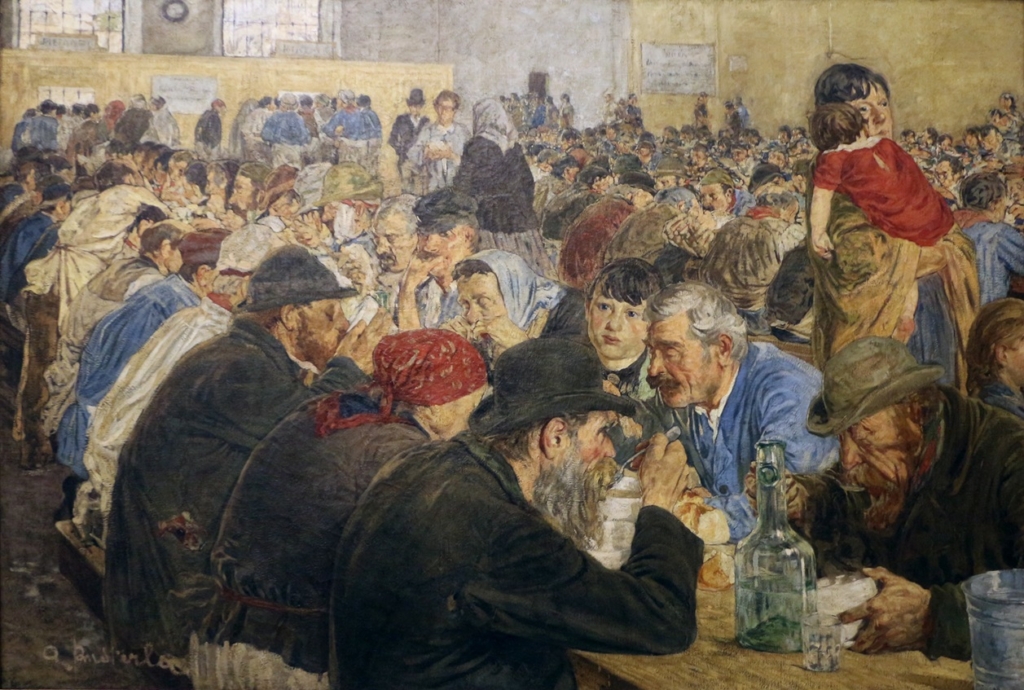
Despite the social purpose that animated this work, Pusterla hoped to receive the approval of the critics and a prize, but the latter did not come and the critical response was tepid at best, no doubt because of conservative resistance to the subject matter of the work and to its style. The painting did not sell in the exhibition, which of course did not help to cheer Pusterla’s spirits. Later, Vittorio Grubicy purchased the painting and, in 1888, showed it in London along with a group of 53 other works by Giovanni Segantini, Angelo Morbelli and other young Italian artists whom Grubicy favored as leaders of the emerging generation. The picture did not please the London market, returning to Italy unsold.[106] Eventually, the work was purchased from Grubicy by the Galleria d’Arte Moderna in Milan,[107] where today it remains part of the permanent collection. Despite Pusterla’s disappointment, this painting is recognized now as one of the seminal works of this period of Italian artistic history and it continues to be much discussed by critics and commentators, as can be seen from sources cited in the notes to this article. One commentator describes this work as “undoubtedly … one of the most interesting canvases in the panorama of painting in the second half of the 19th century.” [108]
Unhappy with the outcome of his work on this painting, Pusterla ceased showing in Milan for a period and took himself to Genoa and thereafter Florence.
In 1890, he exhibited in Bologna and in Turin.
In 1891, he returned to the world of Milanese exhibitions by participating in the Triennial Exhibition of Brera. A number of the painters of the divisionismo school took part in this exhibition as well and, indeed, it was here that that school truly burst on the artistic scene. According to one scholar, this exhibition represented “a decisive turn in the technique and aesthetic of painting in Italy.” [109] There were also a number of paintings presented that generated attention because of their social content, such as Longoni’s Oratore dello Sciopero. At this exhibition, Pusterla decorated the smoking room with a friend. He also presented a painting, The Blood Cure, that proved to be quite controversial. This work was set inside a slaughterhouse and centered on a dead animal and the figure of a gentlewoman afflicted with anemia who drinks a glass of blood as a restorative. Critical opinion was troubled by the choice of subject for this work. Nevertheless, it is said to have been “among the most significant paintings of the exhibition.” [110]
In this period, Pusterla was also engaged in creating pen drawings and paintings in oil.
In 1892, Pusterla executed decorative work. In the spring he painted a series of frescoes on the façade of a house in Milan; these no longer exist. He also participated in the Mylius competition for frescoes,[111] presenting a portrait of Giotto. That same year, he married.
In 1893, he traveled with a group of other artists to Chicago for the World Columbian Exposition. He and some of his friends, including Longoni and Previati, created a diorama recording the trip. He and two of these friends, along with a writer and a sculptor, planned to present a “Diorama Dantesco” at an art exhibition in Milan in 1894, but the project fell apart due to lack of funding. In 1894, he again participated in the Mylius fresco competition, presenting a portrait of Giovanni Bellini.
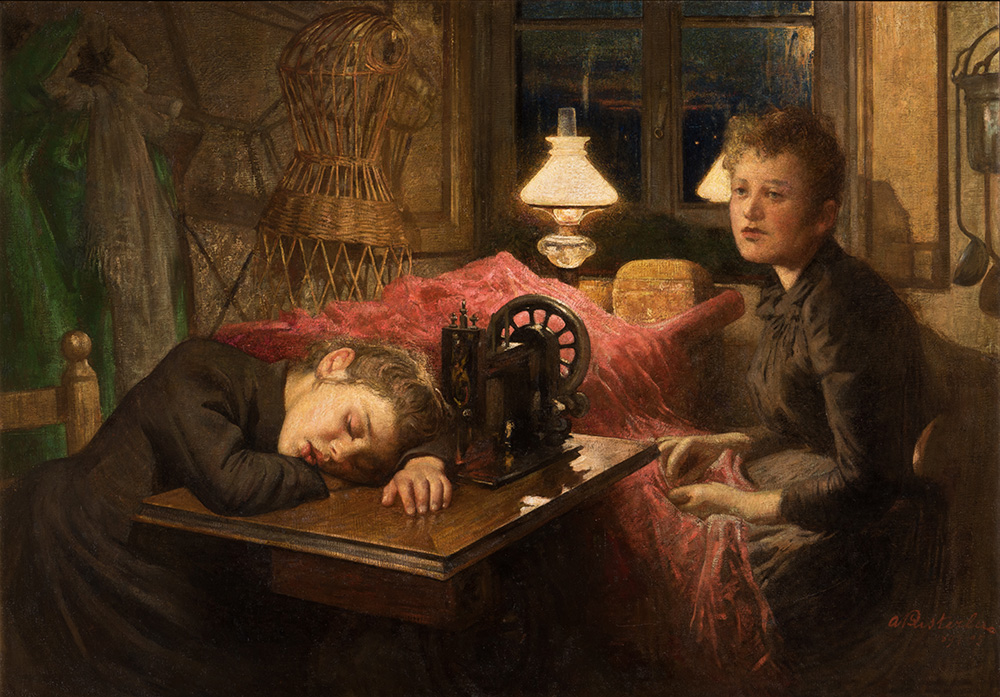
Around this time, he exhibited a painting in Venice (Riflessioni Dolorose (“Painful Reflections”)), which appears to be the one that is included with two others in the collection of the Divisionismo gallery in Tortona. In this picture, against an elaborate background, a seamstress working late at night thinks sad thoughts, no doubt about the financial challenges of life, as a younger seamstress nearby, perhaps her sister, has fallen asleep due to the arduous efforts of a long day.
In 1895 and 1896, Pusterla exhibited in Milan and Florence. One of the paintings he presented in the latter year was a second version of Le Cucine Economiche. It is not known why he returned to this theme, but it is notable that the atmosphere of this painting is more fraught and troubling than that of its predecessor from nine years before. Was this because he believed that social conditions had deteriorated, or was it perhaps due to his own state of mind? One critic observes that this second painting “sets itself far apart from its predecessor, not only in its general tone, which is decisively more melancholy and resigned, but also for the rendering of light and for the technique used in its execution.”[112] The colors in the second version are more somber than in the original, where the weight of the theme was relieved somewhat by the use of color, reds and blues, in the clothing of the subjects (although the blue was the color of protective attire often worn by factory workers and thus was in a sense necessary to the picture). Perhaps paradoxically, the painting is also melancholy because the hall of the soup kitchen is much less crowded than in the previous version; there are fewer people present taking advantage of the soup kitchen’s services, but those who are there seem to us even more isolated than were their fellows in the earlier painting.
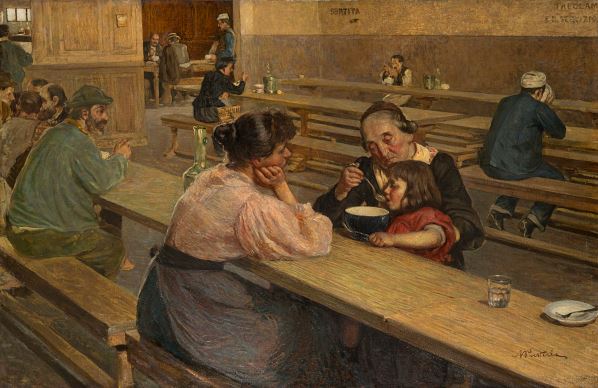
There is some disagreement among scholars about the extent to which Pusterla was an adherent to divisionism. Some, for instance, have viewed the first Cucine Economiche as having been influenced by impressionism, while others consider that Pusterla was anticipating the divisionist artists.[113] The critic quoted above finds the technique used in the second Cucine much changed from that of the first painting, noting the long filament-like brushstrokes evident in the figure of the young woman and the surface of the tables that “show alignment with the researches of the divisionist painters.” [114] Another scholar says that in the Cucine Economiche Pusterla drew close to the divisionist experience, but that he still maintained loyalty to design and to constructive brush work in the creation of form that made him “more a participant in the great European realist tradition than in the various luministic movements.” [115]
It has been said that Pusterla had a “vast production” of works, including socially engaged paintings but also portraits and landscapes, in oil and pastel.[116] Some of these are in private hands today, and others have been lost. Despite this productivity, however, by 1898, if not before, Pusterla was very hard pressed by financial problems. These led him to accept an assignment to decorate a café in Milan. His last exhibition in Italy apparently occurred in 1897.
By the end of 1898, Pusterla was greatly discouraged. His finances were in disarray and he was troubled by the inadequate success of his work from a commercial perspective, and by what he felt to be the indifference of the critics. Further, he was embittered by the evolution of the social and political situation in Italy.[117] In 1898, after a steep increase in the price of wheat, there was unrest over bread prices in various cities around Italy. In Milan in May, there were large-scale strikes and riots. The army was sent in to calm the situation, but overreacted, with the general in charge ordering his soldiers to fire on an unarmed crowd with guns and artillery, which resulted in the deaths of at least 80 protestors and hundreds of wounded. This was followed by government repression nationwide.[118] In January 1899, Pusterla and his wife left Italy for the United States.[119] His departure represented a significant loss to Italy, as one scholar describes him as “one of the most important figures in the art of Lombardy of the end of the [19th] century.” [120]
Mr. Pusterla Comes to America
Every immigrant, even the most courageous — and they all must have fortitude to abandon familiar habits and surroundings and the family and friends whom they have known throughout their lives — surely struggles with misgivings and fears about the prospects for success in a new life in a new country and in a different language. Undoubtedly, Pusterla had such feelings. But he had a reason for worry beyond that which burdens every immigrant, every mason or carpenter who comes to America. He was cutting himself off from the ways of life, the scenery, the social and artistic contexts, movements, and community in and among which he had lived and worked for 37 years and that had been the vital fuel for his work as an artist. Surely, he must have feared that, far more than the mason or carpenter, he would have difficulty bringing his skills, so rooted in a particular social and artistic setting, to a country about which he knew little and at what is for a painter who is starting over an advanced age.
In 1904, Pusterla directed the Italian section of the Universal Exposition at Saint Louis. There, he attended to the placement of a painting of his friend Angelo Morbelli. To Morbelli he expressed bitterness about his first years in the United States.[121]
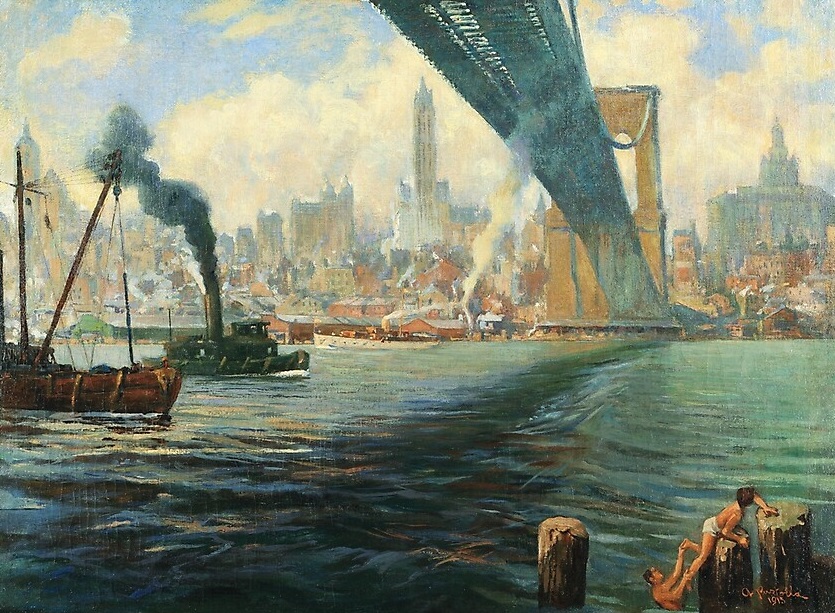
Among other work Pusterla completed in North America were murals at the Parliament Building in Ottawa, Canada. A fire in 1916 destroyed most of the Centre Block, where the Houses of Parliament are located. After the building was rebuilt, Pusterla was called upon to decorate the walls of the office of the Opposition Leader in the House of Commons. He painted a series of frescoes on the upper walls, the only frescoes anywhere in the parliamentary complex. The frescoes depict scenes of knighthood and are intended to illustrate qualities, such as fearlessness, integrity, and wisdom, that the leader of the opposition ought to possess and that should help to advance the cause of beneficial legislation.[122] The Opposition Leader of the time, future Prime Minister William Mackenzie King, made many suggestions to Pusterla for the subjects of the murals, which the artist incorporated. King even went so far as to request that the face of an angel in one of the scenes be based upon that of his deceased mother, which, it is said, is what Pusterla did.[123] Images of the frescoes can be seen today in a publicly-available video.[124]
In the 1920’s, Pusterla painted a group of murals in the Senate of Canada, at least nine of ten, that celebrate the history of transportation and commerce in Canada. The murals show the daily life of ordinary Canadians, such as a lumberjack, a farmer, a miner, and a fisherwoman, in the early 20th century and before. They present images of ships, trains, canoes, and zeppelins set against Canadian landscapes. Unlike the frescoes in the House of Commons, the paintings were done on canvas, and they were affixed to plaster high up on the walls of the Railway Committee Room (also known as the Banking, Trade, and Commerce Committee Room) of the Senate of Canada in the Central Block of the Parliament Building.
In 2019, the Senate moved to a new building to permit extensive renovations to be made to its permanent home. Artwork in the building had to be removed for its safety during the renovations, including the Pusterla murals. Scaffolding was erected in the Committee room. The murals were peeled off the walls and immediately rolled onto cardboard tubes. Next, they were unrolled onto a protective sheet, rerolled, and transported to storage. This process can be seen in a publicly-available video. The murals may be cleaned and conserved while in storage. When the building is ready to be reopened, they will once again adorn the walls of the Commerce Committee Room.[125]
Pusterla received a commission to decorate a free-standing column that was erected in 1926 in Astoria, Oregon. The Astoria Column, as it is known, was designed on the model of Trajan’s Column in Rome. It is 125 feet high and sits on Coxcomb Hill, in a 30-acre park, overlooking the mouth of the Columbia River. The column boasts an interior spiral staircase and an observation deck at the top. The column was built with financing from the Great Northern Railway and Vincent Astor.
Pusterla designed a decorative strip, a kind of frieze, for the exterior of the column. The strip is nearly seven feet wide and runs the length of 525 feet. It depicts important events in the early history of Oregon and scenes from the history of the region, beginning with the pristine forest and the Clatsop and Chinook Indians, and including the first visit to the mouth of the Columbia by a Euro-American, Captain Robert Gray, in 1792, the expedition of Lewis and Clark’s Corps of Discovery in 1805, and the commencement of commerce at Fort Astoria by John Jacob Astor, from whom the location gets its name.
Pusterla created the frieze using an ancient method of carving or incising known as sgraffito (from the Italian graffiare, meaning “to scrape”).[126] In addition to its use on buildings, the sgraffito technique has often been employed over the centuries on pottery. Sgraffito was popular in the decoration of buildings, loggias, and the like in Renaissance Italy (two members of the studio of Raphael, for example, were expert practitioners of this technique) and it spread widely in Europe, to Germany, Poland, Portugal, Spain, and elsewhere. The artist using this technique applied two or more coats of plaster, contrastingly colored, to a wall. The artist would then scratch away from the surface coat while it was still somewhat wet in accordance with a pre-determined design, thereby exposing the differently-colored undercoat. The contrast in colors, such as between a dark undercoat and a light surface coat, allowed for the creation of elaborate images in the hands of a skilled artist.[127]
In 1926, Pusterla erected a scaffold that surrounded the entirety of the column. He laid down a base coat of dark plaster and later covered it with a lighter coat of plaster. He then created his design in the plaster using the sgraffito technique. The sgraffito artist would draw the design on paper, punch out the outlines of the design on the paper, delicately affix the paper to the surface, and then apply powder to the surface of the paper. The powder would seep through the holes in the paper, leaving the outline of the design on the surface of the plaster when the paper was removed. The artist would then, following the powder marks, scratch out the design with an awl, taking care not to scratch too deeply into the undercoat. This is the painstaking process that Pusterla followed in creating the frieze on the exterior of the Astoria Column.[128]
The column was dedicated on July 22, 1926, the central act of three days of celebratory events attended by thousands. Pusterla’s work was not finished on dedication day so he and his assistants continued laboring for several more months before the project was completed. [129]
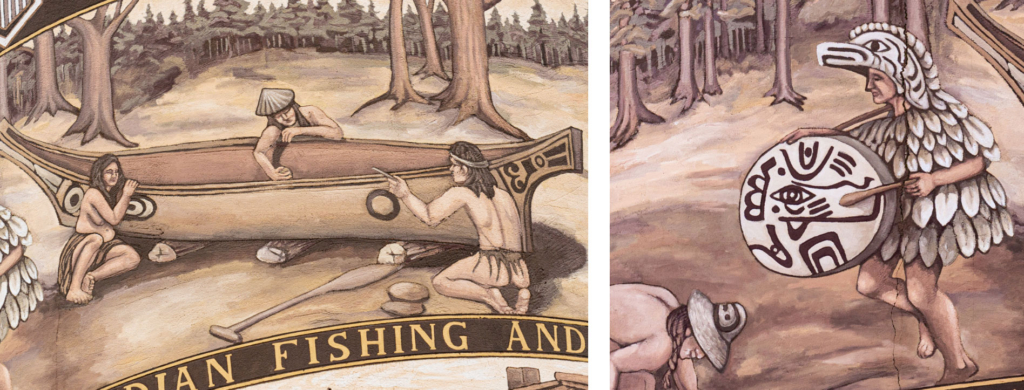
The force of the winds from the southwest and the elements caused damage to the carvings on one side of the column and so, in 1936, Pusterla, during the time he was at work on the New York County Courthouse, returned to Oregon to direct restorative efforts. He re-etched the affected area of the carving and then covered it with a thin coating of cement to provide protection from the weather.[130]
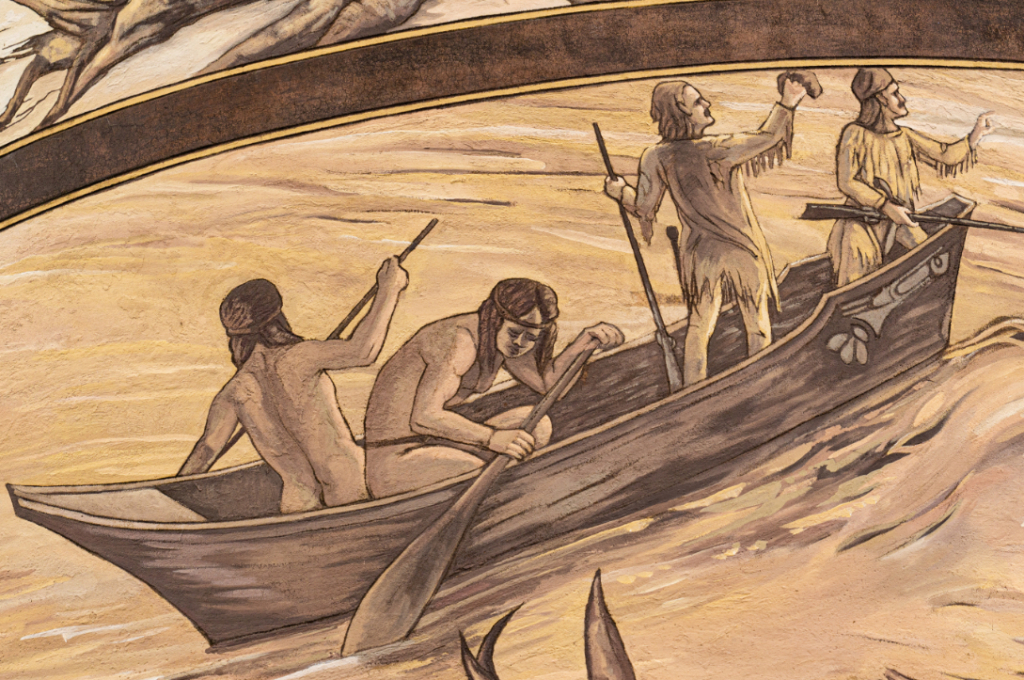
The column is listed on the National Register of Historic Places. It is visited by many each year (as many as 400,000 in each of the years leading up to the bicentennial of the Lewis and Clark Expedition) and is an admired symbol and artistic object to Oregonians.[131]
As noted earlier, Pusterla taught at the Leonard da Vinci Art School in Manhattan.[132] The school was founded in 1923 by Attilio Piccirilli, who was a stone carver who worked with his five brothers, and Onorio Ruotolo, a prominent sculptor.[133] It was a low-tuition and later free art school for the working poor and immigrants, offering instruction without regard to race or religion. It presented classes on painting, sculpture, pottery, and the art of fresco painting, among other subjects. The school, which was supported by the Friends of Italian Art Association, was reorganized and reopened in 1935, at which time Mayor Fiorello LaGuardia presided over the reopening ceremony. The school reopened with an initial enrollment of 300 students.[134] A few years later, Italy’s declaration of war on the United States caused a severe backlash in this country, as a result of which support for the school diminished to the point that it was forced to close.
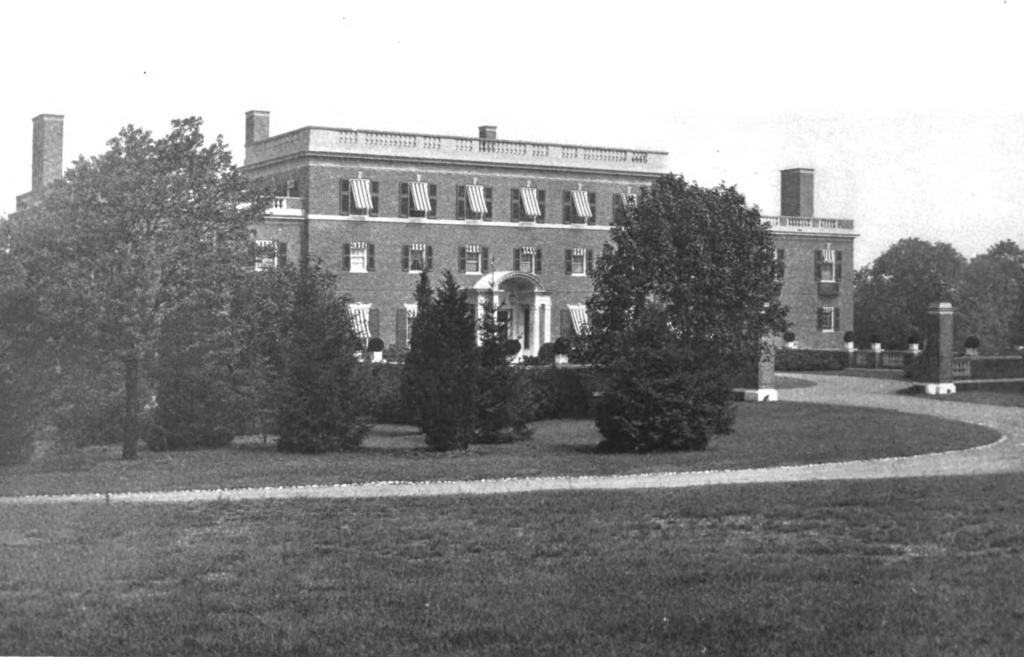
We know how architect Guy Lowell came to be in a position to choose Pusterla for the mural work he planned for the New York County Courthouse. Pusterla became known to Lowell as a result of projects on which they both worked. Lowell designed at least six country houses on Long Island, as well as a golf club there.[135] One of these projects was a grand mansion, built in 1915 and called “Farnsworth,” owned by C.K.G. Billings, a businessman and sportsman, at Matinecock, Locust Valley on Long Island. Pusterla provided murals for it. There were hand-painted murals in the main drawing room that are believed to have been executed by him.[136] There were also murals in the music room that he probably did.[137] This mansion was one of the most luxurious of those on what was then Long Island’s “gold coast.” One sign of just how luxurious things were there at the time is the fact that on one occasion Mr. Billings, who was a devoted horseman, served formal refreshments to his guests while all were seated on horses. Pusterla also did murals for other significant homes around the country.[138]
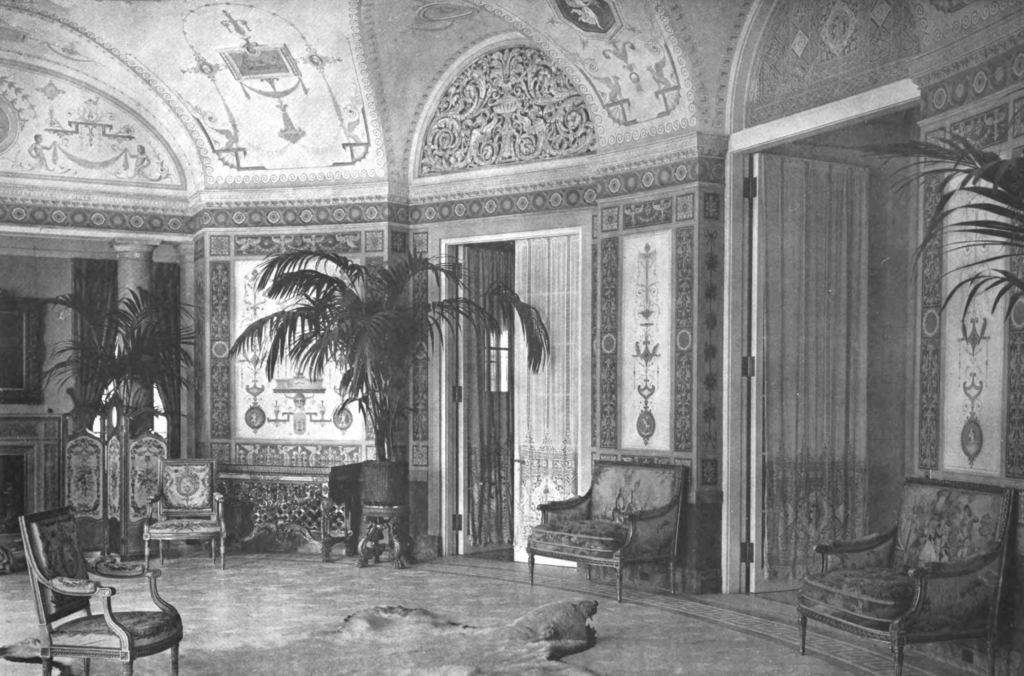
In the history of art there have been artists who have also had serious interest in science. Leonardo da Vinci is, of course, one of the most prominent of these artists, having become well known for his work in anatomy, physiology, engineering, and inventions, such as designs for a flying machine and a fighting vehicle. Attilio Pusterla was an artist of this type.
It is not known what, if anything, he may have done to pursue scientific projects when he was working on his art in Italy. In the United States, however, he devoted time to serious scientific pursuits. He also sought to commercialize some of his ideas. We do not know whether he was inspired or influenced by the open business climate in the country or the American enthusiasm for entrepreneurship or whether he was driven by a pressing need to make money to help sustain his family. Whatever the influences upon him, his interest was undeniable.
Over a period of years, until at least as late as 1922, Pusterla worked on various inventions and obtained nine patents, eight of them in the United States and one in Great Britain.
One was for a flying machine, another an aeroplane, and a third improvements in flying machines capable of vertical and horizontal flight. [139] These inventions were made not long after the Wright brothers flight at Kitty Hawk, at a time when manned flight was in its infancy and was the subject of intense creative work around the world. In 1909, Pusterla obtained a patent for a bath house key. In 1910, he obtained a patent for a transmission mechanism that would gradually transmit the speed of a power shaft to the driven shift so as to overcome the sudden starting and jerking characteristic of many mechanisms of this type.[140]
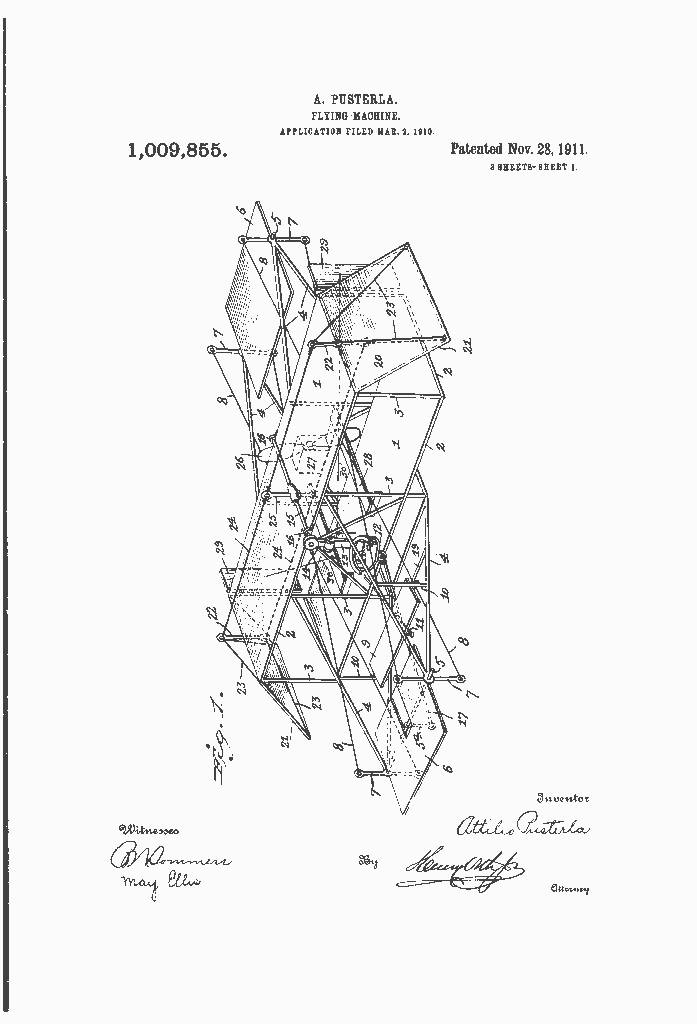
In his early years in the United States, Pusterla interested himself in inventions that could be used at amusement parks. In 1903, he was issued a patent for a “pleasure waterway,” also known as a pleasure canal or pleasure lake, artificial water courses or bodies accompanied by scenery and other attractive displays for amusement. The following year, he obtained two more patents for pleasure waterways. In 1906, he was issued a patent for a water carousel. [141] In 1905, Pusterla incorporated an amusement business in Brooklyn, Island Amusement Construction Company. [142] The purpose of this enterprise was undoubtedly to construct amusement rides of his design.
Beginning about 1880, Coney Island became a popular amusement area. Three large amusement parks were opened thereafter and became very successful attractions for the public: Steeplechase Park (1897), Luna Park (1903) and Dreamland, which operated from 1904-1911. The last of these parks purchased rights to one of Pusterla’s patented water rides, called for commercial purposes the “Descent into the Hell Gate”[143] or simply “Hell Gate,” which was the name on the banner to the ride’s entrance. [144] Pusterla also licensed this same ride to another amusement park, Wonderland, which opened in 1906 in Revere, Massachusetts, near Boston. He served as the artistic director for Wonderland, although it is not certain just what work he did for the park in this capacity. He apparently created another ride, called the “Razzle Dazzle,” which he sought to have built at Wonderland. A public report indicated that the ride would open in 1906, but this never came to pass. This may have been the ride Pusterla patented under the name “Water Carousel.” [145]
Pusterla licensed the Razzle Dazzle ride to the Riverview amusement park in Chicago, a 74-acre park in business from 1904 to 1967, where it was in operation for several decades under the name “Aquarousel.” [146]
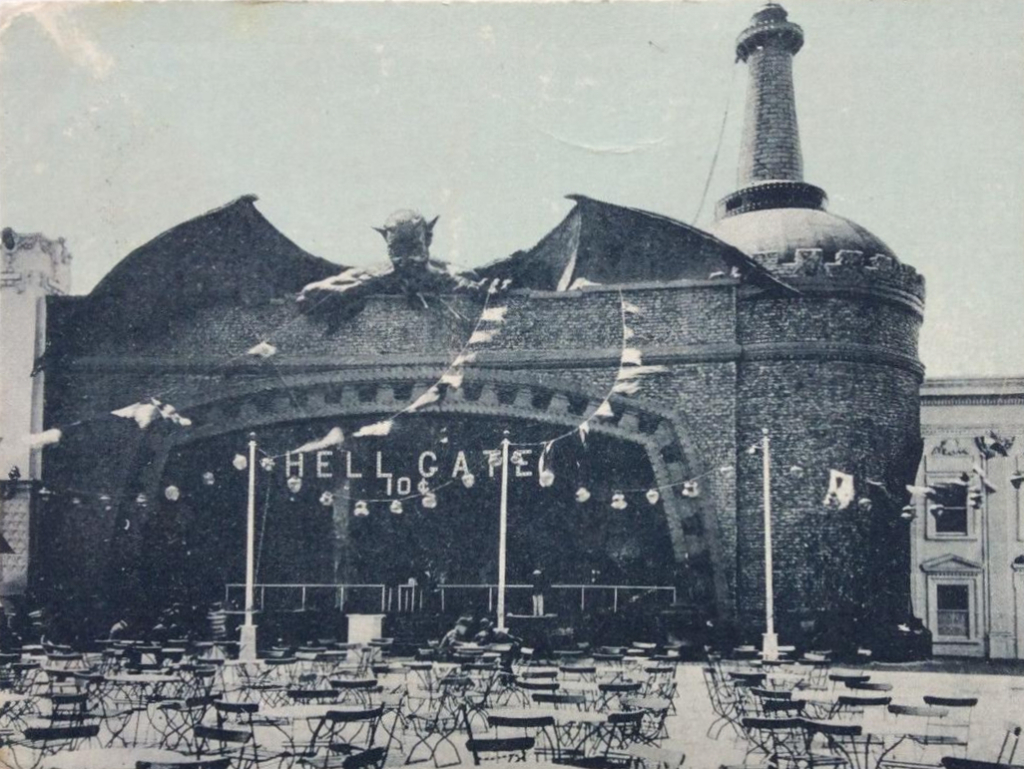
The Dreamland amusement park at Coney Island suffered a sad fate. In 1911, the park burned to the ground and never reopened. Investigators believed that the vast fire occurred when workers doing repairs or maintenance on one of the rides, namely, Pusterla’s Hell Gate, knocked over a bucket of pitch that caught fire, effectively destroying almost the entirety of the park.[147]
After the work at the New York County Courthouse was completed in 1938 or so, Pusterla remained active until his death. He passed away from a heart attack at his home at the age of 79 in May 1941.[148] However, though he left Italy, disillusioned and perhaps in despair, 125 years ago, he is still remembered in his native country. He has been the subject of scholarly writing, as notes to this article show; his Cucine Economiche are quite well-known; paintings of his are held in museums; and he is included in art exhibitions. There is even that great modern indicator of significance, a podcast about him, sponsored by the Italian international banking group Intesa SanPaolo, which was posted in 2023.[149] It is ironic that a podcast about a Socialist painter has been supported by an international bank. History sometimes has a way of laughing.
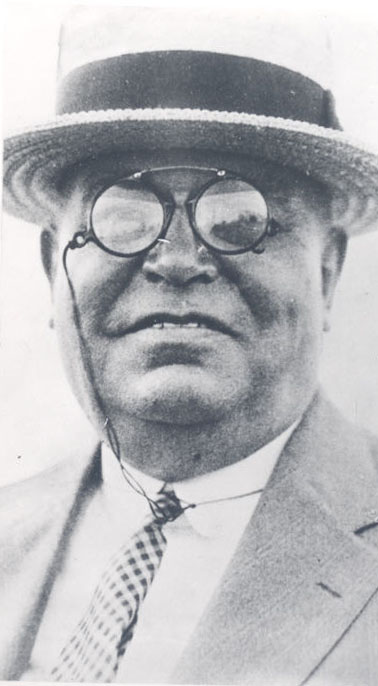
E. Fresco Painting
It was mentioned earlier that the decorations painted on the ceilings and walls of the first and second floors of the New York County Courthouse are frescoes.[150] Typically, frescoes are murals, but not all murals are frescoes, as indeed is clear when one examines all of the work that was done at the courthouse. The name fresco comes from the Italian, meaning “fresh.” The well-known term al fresco describes dining or other activity in the open, fresh air. In art, the term refers to the technique of painting with a mix of water and pigment on lime-based wall plaster.[151]
Fresco painting dates from antiquity and was used throughout the world. It achieved its artistic apex, however, during the Italian High Renaissance, with antecedents in Italy having begun in the second half of the thirteenth century. Among those who painted frescoes were Cimabue, Giotto (as in the Arena Chapel in Padua),[152] Ghirlandaio, Masaccio (e.g., the Brancacci Chapel in Florence),[153] and Mantegna and, on the walls of the Sistine Chapel, Botticelli, Perugino, and Luca Signorelli, among others.[154] The greatest and best-known instances of fresco painting are the work of Michelangelo in the Sistine Chapel and the rooms painted by Raphael in the Vatican.[155]
There are two principal methods of fresco painting.[156] The first is called buon fresco, or “true fresco.” This technique is the oldest and most common form of fresco painting, but it is ferociously difficult. In it, coats of plaster (each of which is called the arriccio) are applied to a wall and are allowed to dry over days. Then, a thin layer of plaster made from lime and sand, the intonaco, is placed on the wall using a trowel. The artist applies the paint to the surface of the intonaco while it is wet (but not too wet). The paint is a mixture of pigment and water at room temperature.[157]

Since the surface will dry within some hours depending upon humidity and since errors cannot be corrected using buon fresco once the wall surface has dried (Michelangelo had to make some corrections to the Sistine ceiling by taking a hammer and chisel to previous work),[158] the artist needs to work skillfully and quickly over an area not larger than that which can be done in one day, which is called the giornata, from the Italian word for “day.” The artist may use sketches of the outline of the design as templates on the surface to assist in achieving the desired painting and to match the area being painted perfectly to the areas already completed. This has often been done through the use of “cartoons” (from cartone, the name of the large sheets of paper on which the designs were sketched), which would be affixed to the wall while the plaster was wet. In one method of doing this (called spolvero, from the word for “dusting,” and also known as “pouncing”), the design on the cartoon would be transferred to the surface of the wall by puncturing the lines of the design with many small holes through which charcoal powder would be sprinkled, thus leaving the outline of the drawing on the plaster, which would be reinforced by paint. This was the process used by Pusterla in laying down the designs on the Astoria Column. In another, simpler, but less precise method, the frescoist would trace over the lines on the cartoon with a stylus and thereby impress on the wet plaster the lines of the drawing.[159]
Michelangelo used both methods on the Sistine ceiling, depending upon the amount of detail required. The longer he worked on the project, the more confident he became, and in the later phase he relied more upon the second method than the first.[160]
Once the area in question has been finished, it is allowed to dry completely. As the surface dries, a chemical process occurs by which the particles of pigment are fixed within the plaster.[161] The result is that the painted wall is strong and the painting has great physical integrity and durability. A buon fresco is the strongest and most durable form of fresco. Frescoes from ancient times have survived down to the present day. The earliest buoni freschi date from the time of the Aegean civilizations. Buon frescoes in the Roman style were found in the ruins of Herculaneum and Pompeii and in the Roman catacombs. In April 2024, archeologists announced new discoveries of frescoes on the walls of a banquet hall in Pompeii.[162] Michelangelo’s Sistine ceiling, which is approximately 133 feet by 46 feet[163] and depicts multiple scenes with over 380 separate figures and on which Michelangelo worked for four years (1508-1512), is a buon fresco.[164] Like Mr. Pusterla, Michelangelo had assistants who provided help on the more mundane aspects of the work, but he did the bulk of the painting himself.[165]
The second technique of fresco painting is called fresco secco, meaning “dry fresco.”[166] I referred to this term earlier when speaking of Reginald Marsh’s murals in the Custom House at the Battery. The name reveals how this painting is done — paint is applied to a dried plaster wall. Whereas in the case of buon fresco the paint is affixed to the wet plaster and the pigment is absorbed into and dries into the plaster, in secco painting a binding agent is needed to attach the paint securely to the dry surface. The pigment is mixed with such a binder, commonly oil, glue, or tempera egg yolk.[167]
Buon fresco painting requires that the surface of the intonaco be smooth, but secco works better on a surface that has been roughened. In the latter case the intonaco is made rough and then, after it has dried completely, is made rougher still by scrubbing it with sand.
The secco method has the very considerable advantages of eliminating the time limit that the buon fresco painter faces and doing away with the constraint upon corrections. The paint can be applied more slowly and with greater precision. If errors are made, they can be corrected without difficulty.
An additional and very important consideration is that the chemical composition of the wet plaster in buon fresco is such that certain colors, such as blue, are difficult to achieve compared to painting on canvas. The “color schemes [of frescoes] are much more severely limited than those of the easel painter.”[168] The palette of the frescoist is somewhat restricted because many bright colors would not survive unchanged after contact with the corrosive, lime-rich intonaco. A blue pigment, called “German blue,” for instance, would turn green over time after having been absorbed into the plaster, which explains why green skies were found in frescoes with notable frequency.[169] The delicate nature of the coloring process in buon fresco accounts for the fact that Michelangelo and other frescoists went to great lengths to obtain the finest quality pigments for their work and to use colors precisely adapted for the project.[170] “Michelangelo made sure to use only those colors that he knew were suitable to fresco ….”[171] Because the obtaining of colors suited to fresco painting was so important, great attention was devoted to the development of and adherence to techniques and recipes for the creation of colors. Recipe books and treatises on techniques for mastering colors go back many centuries (some existed in antiquity) and some of these reflect understanding of the practices of ancient Rome.[172]
Further, the frescoist had to face the fact that there could be a considerable difference between some colors as first applied in buon fresco and as they might appear once the wall surface had dried completely. In the secco method, of course, there could be no such marked contrast.
It was due to these realities of color, along with the ability to make corrections, that some frescoists, including Michelangelo and Raphael, at times employed secco methods. Medieval wall paintings often were created using a combination of techniques.[173] Sometimes painting a secco was done on top of buon fresco, in which event the latter portions would be more durable than the former. Although he primarily used buon fresco, Michelangelo did use a secco on occasion on the Sistine ceiling.[174]
Secco, however, has a very great drawback: as it produces a fresco that has not been, if you will, painted into a wall or ceiling, as in buon fresco, but rather painted upon a wall or ceiling, the fresco is more fragile than a buon fresco and less durable.[175] It is more susceptible to damage from dampness than is a buon fresco. Paint flaked off in some places on the Sistine ceiling where Michelangelo used the secco method.[176] Leonardo da Vinci, dissatisfied with the limitations of buon fresco, chose not to use it when painting The Last Supper in Milan, which famously deteriorated quickly after its completion.[177] I will later come back to this limitation when considering the rotunda ceiling.[178]
Attilio Pusterla employed the secco method in the frescoes of the New York County Courthouse on the first and second floors. We know that this was his intention and how he worked, as was confirmed by expert art restorers who labored on the frescoes in the late 1980’s-early 1990’s. (I discuss the restoration later.) In any event, even an amateur who is only slightly knowledgeable about the color limitations of buon fresco might suspect that this is the fact by studying the colors of the frescoes on the first and second floors and noting their intense vibrancy, as well as the extensive use of a strong, bright blue in the composition on the rotunda ceiling.
Pusterla made the choice of technique he did because he believed that the walls of the building were not suited to the use of buon fresco and that the colors that would be produced by the secco method would be forceful.[179] His expectation about the colors was certainly proven correct. Precisely what it was about or in the composition of the walls that rendered them, in Pusterla’s opinion, unsuitable for hosting buon frescoes is not known.
Perhaps it also entered into Mr. Pusterla’s calculations that painting the murals on the first and second floors, including the immense rotunda ceiling, using the buon fresco method would have been extremely laborious and time-consuming. So, the murals on the first and second floors, including those in the vestibule, the colonnade, and in the rotunda, are all freschi secchi.
F. The Artistic Programs of the Murals
What are the murals on the first two floors about? I turn now to that question.
Murals are, as we noted earlier, to be found in the vestibule and the main corridor on the first floor. These are representational depictions in fresco secco. In addition, there is a large decorative mural over the entrance to Courtroom 130 and there are decorative fresco murals on the ceilings and walls of corridors of both floors and on the ceiling near the elevators on the first and second floors.
The centerpiece and the masterpiece of all the murals in the building is, without question, the fresco secco ceiling of the main hall on the first floor. This is appropriate. This space is by far the largest in the courthouse and it was designed by Guy Lowell as the hub and focal point of the building. To a great extent, the operations of the building flow around this central point. The rotunda is splendidly adorned with marble columns and a Roman-style marble floor in a wonderful design. The space cried out for decoration of some kind on its vast ceiling, indeed, for a painting of a quality commensurate with that of the architectural setting, and the photographs of the space taken around the time the courthouse opened in 1927 show how incomplete and even naked the space looked and felt in the absence of decoration on the ceiling. Mr. Pusterla filled the need with the glorious mural on the rotunda ceiling, as Guy Lowell had intended.
As with many other ceiling murals in history, the rotunda mural is composed of a single, unified fresco expressing a single unifying theme through a group of related elements rather than a series of distinct, unrelated subjects. As was the plan from the time of the application for approval and as probably was the case when Pusterla submitted his designs to Lowell prior to 1927, the mural is entitled “The Law Through the Ages.” The mural depicts a group of important incidents in the development of the law from ancient times through the founding of the United States and its second founding at the time of the Civil War.
Overall, the murals on the first and second floors are not stylistically innovative. They are notably traditional or conservative, although not because Pusterla worked only in that style; as discussed earlier, during his career in Italy, Pusterla employed a bold, more impressionistic, and distinctly socially-conscious style for his paintings, or many of them at least. It appears clear that Lowell, who favored classicism generally and who supervised the preparation of Pusterla’s designs for the mural, wished to have traditional designs used in his neo-classical courthouse, which was a reasonable desire on his part. He would have been uncomfortable with the employment in that setting of murals in a more advanced modernist style, such as some of those created by Regionalists and others elsewhere in the country, such as John Steuart Curry, including some of those in New York City (e.g., those of Thomas Hart Benton for the New School for Social Research and those of Reginald Marsh for the Customs House), and in Mexico in the 1920’s and 1930’s. Holger Cahill described the necessary discipline that operates upon the mural painter and that must have constrained Pusterla:
The mural must have definite relation to its surroundings and be an integral part of an architectural scheme. The color, the scale, and the character of the painting must harmonize with the color, scale and character of the surrounding architecture. [180]
In fact, Major House explained that the Renaissance style that was used as the work began in the vestibule had been chosen by Pusterla precisely in order to achieve a harmonious relationship to the building overall and its particular features,[181] although House was at pains to point out that some modern elements were included within the general scheme as well, referring to figures in the vestibule, an Indian, a Dutchman, a colonial soldier, and a modern laborer in overalls.[182] There are also references to modern realities in the murals, such as a steamship. The murals Pusterla and his colleagues created certainly are in harmony with the rotunda and the rest of Lowell’s courthouse and have other admirable qualities as well, which I touch on here.
Could Pusterla have employed modern designs, representational rather than abstract, on the rotunda while remaining faithful to Lowell’s overall purpose ? One thinks of the 20 panels painted between 1935 and 1941 by Maurice Sterne for the Treasury Section of Fine Arts at the Justice Department Building in Washington on the theme of the “Search for Truth.”[183] These murals are representational, but are painted in an imaginative and modernist style. Although the style is very modern, these murals seem to have a timelessness to them. Could something like this sort of style have succeeded in the rotunda ? Or something executed in the flowing figurative styles of Benton, Marsh, or Curry, the last of whom also provided murals on legal themes for the Justice Department Building. I think so. But it is probable that, had he had any such inclination, Pusterla simply felt duty-bound to remain faithful to the style of the designs that Lowell saw while the courthouse was being built.
Looking at the murals today, the viewer is impressed immediately and forcefully by the sheer scale of the labor and energy the painters were required to expend to achieve their results, especially in regard to the rotunda ceiling and the paintings in the vestibule and the main corridor. But the viewer ought also to keep in mind other realities of the painters’ work in “the discipline of a severe medium,” as explained by Holger Cahill:
The problems of fresco painting are extremely complex. The painter must know exactly what he wants to do with the space, and have a great deal of knowledge of the chemical relationships of various materials, especially of the relationship of mortar mixtures to colors. No matter what the medium … the mural technique has certain possibilities and limitations which the painter must respect…. The composition as a whole must have clarity, largeness, carrying power, and a rhythmic order that leads the eye easily through the whole space….
Many sketches, a great deal of research, and the hardest kind of purely physical labor must precede the actual painting on the wall. During the painting the artists usually work in public spaces where people congregate. Mural painting is not a studio art; by its very nature it is social. In its great periods it has always been associated with the expression of social meanings, the experience, history, ideas, and beliefs of a community.[184]
In the main hall, the colonnade, and the lobby, the task that confronted Pusterla at its most elemental was to carry out a daunting physical undertaking, that of filling up the large spaces with paint by hand while working on scaffolds far up from the floor. The physical labor must have been especially considerable for Pusterla as he was, at the time he worked on the vestibule murals, 72 years of age.
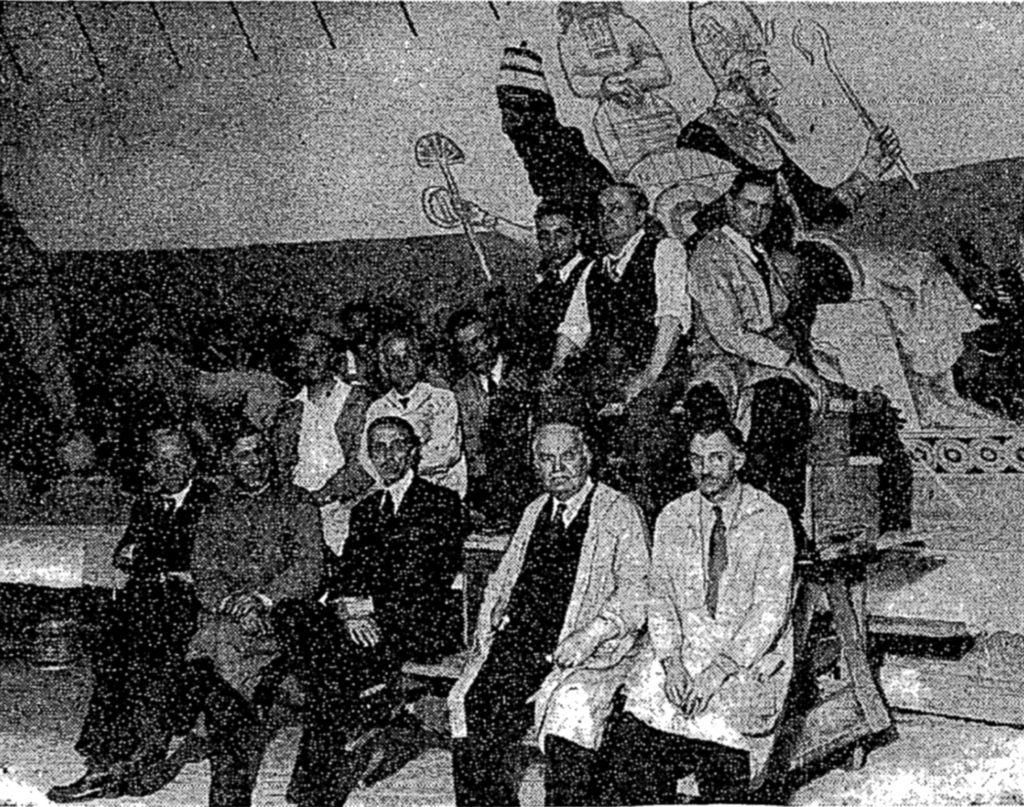
Less physically taxing but very challenging artistically, of course, was the task of creating designs that would have artistic value and power, which demanded inspiration, great technical skill, and care in planning the composition and carrying the ideas into reality. Doing that over the vast expanse of the rotunda ceiling alone was a major challenge, not one as extensive as that which faced Michelangelo in the Sistine Chapel, but very considerable all the same. Pusterla confronted the difficulty that has faced frescoists, from Michelangelo and Tiepolo onward, who have had to paint scenes on lofty ceilings – – that of achieving clarity, largeness, and carrying power so that the viewer looking upward from far below can readily perceive and be affected by the painting and the things it says.
Pusterla also had to confront and conquer the difficulties on the score of perspective caused by the vaulted and domed surfaces of those spaces – in the vestibule, on the ceiling of the colonnade corridor, and on the rotunda ceiling. Those curved surfaces and the fact that they were located high in the air called upon the painter to create optical illusions that would trick the eyes of the viewers below, a foreshortening that was notoriously difficult and for which in one of its forms there was a special name, di sotto in su` (“from below upward”). Mantegna was one of the masters of this technique.[185]
The Murals in the Vestibule
As noted before, the murals in the vestibule were the first ones that were painted in the courthouse, beginning in January 1934, in reliance upon the funding that was available at the time from the PWAP. The ceiling in the lobby is high and imposing. The ceiling consists of three domes, smaller than that of the main hall, that rest on piers of travertine stone. The murals on the ceiling, the inspiration for which was, Pusterla explained, the work of Raphael in Rome,[186] depict the theme of “The Administration of Justice.” The murals are painted in warm tones that certainly recall Raphael and his disciples. Much yellow is used, along with greens, reds, lavender, rust, and blues, and the tonal palette is different from that used in the rotunda.
The central dome provides the foundation for the composition of the vestibule ceiling. At the apex and center of this dome there is a decorative design in various colors and forms. Below it and running around it are four dignified head portraits in green, to which I alluded earlier: they are of a Native American, an inhabitant of New Amsterdam, a soldier from the Revolutionary era, and a contemporary worker in a cap and smoking a pipe. Together these figures are meant to symbolize the history of the City of New York.
Below these are the four principal figures of the dome, the largest in it, which are arrayed around the circle of the dome. Within a circle and an enclosure for each are four allegorical figures, two women and two men. These figures represent Learning, Agriculture, Commerce, and Industry, as is made clear by captions below the figures. The figures are presented in classical poses with flowing robes and carrying or surrounded by objects relevant to their activities. They seem to be gods and goddesses from Greek mythology (or their Roman equivalents). The figure representing Commerce clearly seems to be a portrait of the Greek god Hermes. As he is often depicted, he here is young and athletic, wearing winged sandals and a cap, and carrying a special staff called a caduceus. Behind him are instruments of modern commerce, a train and a steamship. The female figure representing Industry, who may be the Greek goddess Athena, has a protractor in her hand and is surrounded by modern buildings and an industrial plant. The figure representing Learning, who may be Apollo, is shown with objects associated with knowledge, such as books, an hourglass, and an academic building. The figure representing Agriculture, who may be the Greek goddess Demeter, is shown surrounded by agricultural products. These four spheres of human action were chosen because activities within them often lead to the work of justice that the courthouse carries out.[187] The four figures are surrounded by elaborate decorative elements.
Below the painting of the dome proper are pendentives. Within each is a painting of a bronze sculpture standing in a marble niche. The figures stand for Authority, Justice, Clemency, and Judgment, as identified by a caption beneath each. These of course are virtues that a sound system of justice, and a courthouse that is part of it, should exhibit. The figure for Justice is that of the traditional blind woman holding the scales and a sword. That representing Authority is a stern figure holding a large sword in both hands. The figure for Clemency is a woman in a gentle and welcoming pose.
Above each of the figures in the pendentives is a painted form of marble plaque within an oval and with banners above. A word or words are painted inside each plaque. Putting all four plaques together, they set forth the following injunction: “Protect Public Works of Art.” This is a direction that will, I hope, always be carried out at the courthouse.
Decorations in tones of yellowish cream and blue grace the other two domes. There are designs of the stars and stripes, the Mayflower, and Henry Hudson’s ship, the Half Moon.
At each end of the vestibule, to the north and the south, is a passage. Above the passage is a clock with a painted face and actual mechanical parts. Against a green background are figures set on each side of the clock. Over one passage is a young couple from New Amsterdam. The young woman is shown sewing at home. The young man sits outdoors smoking, with a gun in one hand and a turkey at his feet. Between the two figures is the seal of New Amsterdam.
The mural over the other passage is a very similar scene but set in a different social context. We see a Native American man and woman. The woman is shown weaving a basket at home with a rug and clay pots nearby. The man is sitting outside smoking a pipe with a bow in his hand and a dog at his feet. At the top of each of the passageways is a small plaque bearing the letters “WPA,” thus disclosing for the viewer the sponsor (along with its predecessor, the PWAP) of the murals in the building. (Since the WPA did not exist when the vestibule was painted, the plaque must have been added at a later time or perhaps the paintings over the two passageways were subsequent additions.)
This impressive lobby is well lit by large windows on the western wall of the building. Three enormous bronze lanterns are suspended from the ceiling on long chains. These lights were the work of Tiffany studios, which is believed to have done all the light fixtures in the building.[188] The lanterns blend in well with the mural decorations.
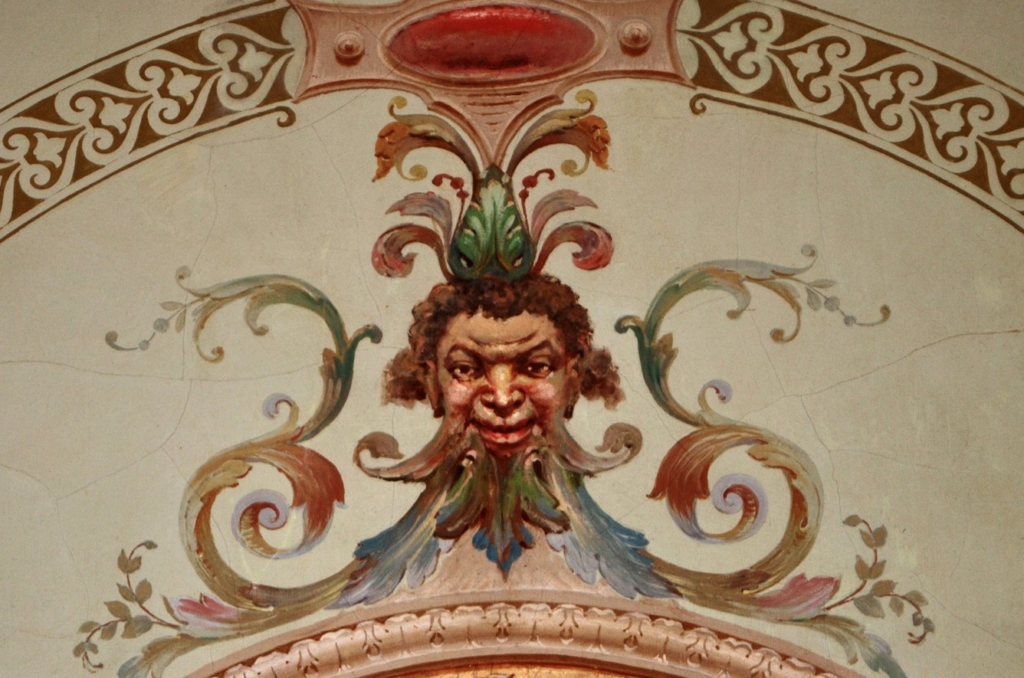 The murals in the vestibule are well-balanced, the figures and decorative elements are rich and very well-painted. In July of 1934, an art critic noted that the then-brand-new mural was a harmonious addition to the building and that the figures in the work were “done expertly and with pleasing freshness of tone.”[189] The colors of the vestibule murals remain bright and warm to this day, 90 years after they were painted. The mural mixes the style of the Renaissance and the modern in seamless and interesting ways. The overall impact of the murals and the vestibule is powerful.
The murals in the vestibule are well-balanced, the figures and decorative elements are rich and very well-painted. In July of 1934, an art critic noted that the then-brand-new mural was a harmonious addition to the building and that the figures in the work were “done expertly and with pleasing freshness of tone.”[189] The colors of the vestibule murals remain bright and warm to this day, 90 years after they were painted. The mural mixes the style of the Renaissance and the modern in seamless and interesting ways. The overall impact of the murals and the vestibule is powerful.
I mentioned earlier that there is also a substantial mural over the entrance to one of the large courtrooms on the first floor, Room 130. As I will discuss later, in 1937 it was intended that the interior of this courtroom was to be a site for murals. At the center of the design over the entrance is a slightly stylized version of the seal of New York City (compared to that which appears in Room 300), dated 1664. Below that we see an urn from which garlands flow and, at either side on the bottom, griffins. At the top is a grotesque from whose head more garlands sprout.
The Mural on the Ceiling of the Colonnade
The colonnade slopes gently down from the entrance lobby to the main hall. The beauty of the colonnade today is horrendously degraded by the presence of magnetometers, which are a most unfortunate necessity in our time that were unknown to Guy Lowell and Mr. Pusterla and the existence of which they would certainly deplore were they around today to see them. (Magnetometers were first installed in the courthouse after an incident in 1981, when Croation separatists, thwarted in their intention to bomb the Federal courthouse next door at 40 Centre Street, set off a pipe bomb in a stairwell between the ground level and the first floor at 60 Centre Street. Fortunately, no one was injured. Between 1927 and the installation of these devices, there had been unfettered access to much of the New York County Courthouse.)
On each side of the colonnade are four beautiful columns of striated marble and piers of travertine. The ceiling is vaulted and has a shallow dome in the center. The ceiling is painted in a rich decorated scheme in a Renaissance-like style in hues of yellow, green, and red. Windows on both sides of the colonnade admit light from the “light courts” (open spaces inside the building) that are a main architectural feature of the building. An enormous and impressive bronze lantern, again a Tiffany work, hangs on a long chain from the center of the space.
The themes of the design on the ceiling of the colonnade are “protection and security,” “army and navy,” and “truth and error.” On each side of the colonnade are head portraits of Presidents Grover Cleveland and Theodore Roosevelt, who were both New Yorkers and Governors of New York.
The barrel-vaulted ceiling contains two panels showing allegorical figures.[190] In one, against a tan background there is a design of four scallop shells colored with a strong blue, white, tan, and brown. At each end of the composition is a painted plaque. Within one is the word “Security” and within the other the word “Protection.” The dominant figure in the composition is a woman seated in a woodland setting who is dressed in a gold helmet and armor and flowing robes and holding a large sword with a shield nearby. This figure, who might be the Greek goddess Aletheia, gives protection and security to a woman and her child, thus fulfilling and embodying the theme of the mural.
The composition on the other barrel vault parallels the one just described, but with a different allegorical subject at its center. Here again there are two plaques at each end of the design, one containing the word “Error” and the other “Truth.” At the center of the composition is an allegorical or mythological female figure, possibly the Greek goddess Soteria, who is dressed in classical robes and wearing a winged headdress. She places a protective hand on the shoulder of a naked woman. This woman holds a mirror in her hand. Over the right shoulder of the main figure is a naked man with his back to the viewer. The goddess seems to sweep this man away with her right hand and he skulks away in shame. The goddess protects truth, in the form of the woman. The mirror is a symbol that has had multiple meanings in art, including duality, but one thing a mirror clearly does is to present the truth, reflecting back to viewer whatever reality is present. The man, on the other hand, is error. The goddess is protecting truth and punishing and discarding error and dishonesty.
Over the entrance way to the rotunda is an elaborate bronze screen or grille.[191]
The Murals on the Ceilings and Walls of the Corridors
Pusterla and his assistants painted very simply the ceilings of the circular corridors that wind around the outside of the rotunda proper and around the balcony on the second floor. They also painted more elaborate decorations, including elements such as the four below, on the walls and ceilings of the five radiating corridors that run from the rotunda to the circumference of the building on each of the two floors. The first two examples here were painted on ceilings and the other two on walls. Other similar designs appear in these locations and there are elaborate painted medallions under large lanterns that hang from the ceilings. The schemes in the various corridors differ from one another.
The Rotunda Ceiling
The rotunda is stunning. Passing from the colonnade, from which of course one can see a partial view of the main hall, one enters into the rotunda proper and its beauty opens before one. The Landmarks Preservation Commission described the main hall very well: “The spectacular rotunda, in essence the recreation of a splendid Roman hall, reflects the classical spirit that so strongly influenced American architecture during the early twentieth century.”[192]
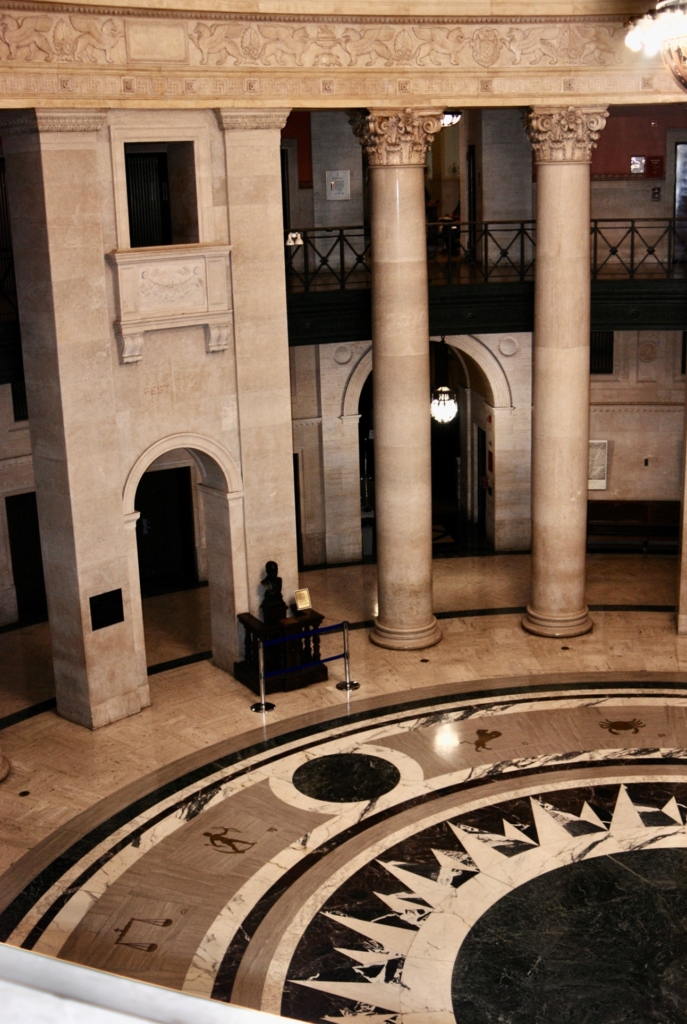 The signs of the zodiac are inset in bronze in low relief in this band. Much marble decorates the walls that run around the outside of the rotunda proper on both floors.
The signs of the zodiac are inset in bronze in low relief in this band. Much marble decorates the walls that run around the outside of the rotunda proper on both floors.
The mural on the rotunda ceiling was composed with great care, as was necessary given the scale of the space, and the challenge of filling in that vast space with images in paint that would be not just coherent, but compelling and beautiful. This enormous painting tells the history of the law over the course of many centuries. Its title, “The Law Through the Ages,” is recorded in the application to the Art Commission, but is not evident on the mural itself.
At the apex of the mural there is a band of blue, with decorative designs in tan set inside, that runs around the circumference of the ceiling. Just below this band is another band of colored designs in gold, red, and blue. Connected to this band are six painted designs in the form of faux pendentives. These pendentives serve the function of creating partitions of the main part of the mural into six sections, as discussed further in a moment. On the blue band, over the center of each pendentive, there appears a plaque that seems to be affixed to the wall and within each plaque is the name of a figure in the history of the law. Below each plaque and inside a pendentive is a painted illusion of a piece of marble and on it is a painted marble head of the figure named. The figures depicted in this portion of the mural are six of the great legal figures in history: the lawgivers Hammurabi, Moses, Solon, and Justinian; Sir William Blackstone, an English jurist and scholar known for the immensely important treatise Commentaries on the Laws of England;[193] and John Marshall, Chief Justice of the United States and the single greatest interpreter of the fundamental law of the United States, the Constitution.
In the center between each two pendentives a circle or shield hangs down. There are six of these. This element of the design is placed over the middle of the main sections described shortly. Within this element appears something that relates to the section that is below it. I describe these elements when discussing each section below.
Flowing down from each area between the pendentives are gold stars and rays pointing downwards against an intensely blue sky.
The main sections of the mural are in the bottom portion, below the artistic features just described. In order that each of the six principal sections of the mural may have its own identity, each section is partitioned from the others by bands of color flowing down from the pendentives, each of which creates a kind of arch. Yet the sections are also well linked together in harmony by a continuous band across the whole of the painting, a sort of painted frieze, in dark blue tones. This frieze appears just above the action of the main sections. It consists of a continuous grouping of persons, sometimes with horses, wagons, and the like, densely packed together. These persons are smaller than the figures that appear in the main sections.
The ceiling of the main hall is immense, 200 feet in circumference and 75 feet tall and the dome is 30 feet high. Six pairs of marble columns in Corinthian style and six travertine piers circle the space. The massive columns and piers are two stories tall. The piers have substantial arches on the ground level and above them window-like openings on the second level. A bronze railing runs around the outside of the columns and piers on the second floor. The floor of the hall is very elegant. It is composed of marble in white, tan, and darker tones. A central design, which resembles a sun, is surrounded by several bands with circles in the largest of the bands.
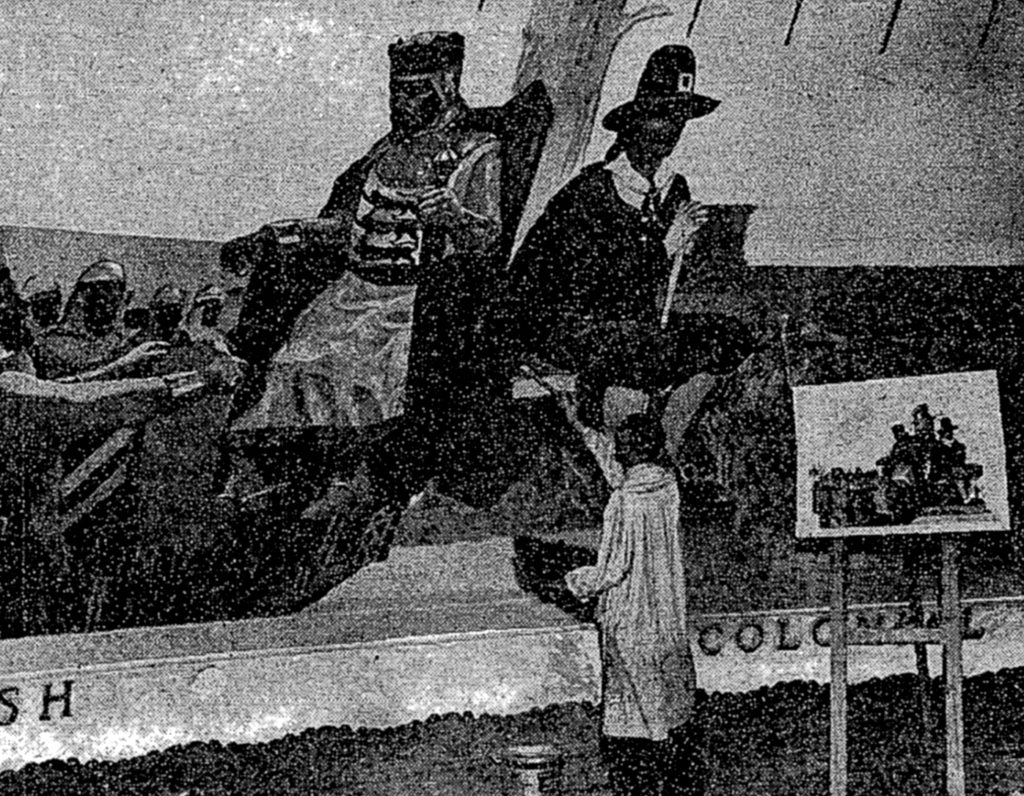
The figures in the frieze are images of the people who lived during the periods addressed in the various sections. In the section devoted to the United States in the revolutionary and Civil War eras, for instance, we see on one side what appear to be figures from the revolutionary era, members of the Continental army, tightly packed together and seemingly on the march. This line seamlessly evolves into a line of settlers moving west in the 19th century.
Mr. Pusterla pointed out that the figures in the mural, of which he noted there were some 300, are painted in two different ways: those in front in the main sections are “painted in strong colors, while those further back [are] painted less boldly, thus giving a fine sense of perspective.”[194] Those in the frieze are all painted in dark blue. He described his aim in creating the frieze:
Over the main mural, in a hazy, cloudlike effect, will be seen humanity on the march, in scenes suggestive of each historical period – – the Exodus, over the Hebraic group; Caesar’s legions, over the Roman group; the Continental armies and the settlement of the West, over the United States panel. The entire effect will be that of a panorama, where the whole host of humanity marches around in a circle, with the blue sky overhead drawing the great masses of bright colors in a unified entity.[195]
The figures in the frieze are very numerous and close together, and are created through the use of only three tones of blue. The overall impression the figures present is, as a result, hazy, as Pusterla intended them to be. Even so, however, it is remarkable how well he carved out the individuals who make up the marching mass of humanity. One can easily discern men and women, who are soldiers and who are ordinary persons, the animals in the march, and the characteristics of the persons that reveal the historical epoch in which they lived.
Below the sky in each section are the protagonists of the design, the historical figures who advanced the cause of the law. These figures are much larger than all the others in the mural, thus conveying, along with their positions in the composition, their centrality to the scheme of the painting. In each section, two such figures (with one exception) are seated back-to-back at the center of the section, so that the mural presents its theme through 12 historical episodes. Below the frieze previously described and ranged below, at the feet of, the principal historical figures are groups of other figures, larger, more colorfully painted and more defined than those in the frieze. These figures surround the even larger historical protagonists and were associated with them in or affected by aspects of their work. For instance, George Washington is surrounded by individuals who participated with him in the founding of the country.
Below the mural proper runs a band of marble within which are affixed words in gold capital letters that identify the period of the action depicted within each of the sections, i.e., “Assyrian,” “Egyptian,” “Hebraic,” “Persian,” “Greek,” “Roman,” “Byzantine,” “Frankish,” “English,” “Colonial,” and “United States of America.” There are ten names applicable to 10 episodes, plus the “United States of America,” which covers two of the 12 episodes. These names are illuminated.
The episodes depicted in the mural, which were explained in the Application to the Art Commission of October 1935, are highly stylized and idealized presentations of imagined historical scenes, which represent actual historical events or processes, except for some that are episodes derived from the Bible, that drove or contributed to the growth of the law over the centuries.
The ceiling is topped by a large clerestory composed of eight stained glass windows separated by Ionic columns and capped by other windows. From here is suspended a magnificent bronze chandelier.
I turn to a description of the 12 depictions set out in the rotunda painting and an explanation of the events and processes shown in them, their importance to the development of law in the world through the centuries, and hence the reason why they are commemorated in the ceiling mural.
The Rotunda Ceiling – The Events Depicted[196]
The First Section
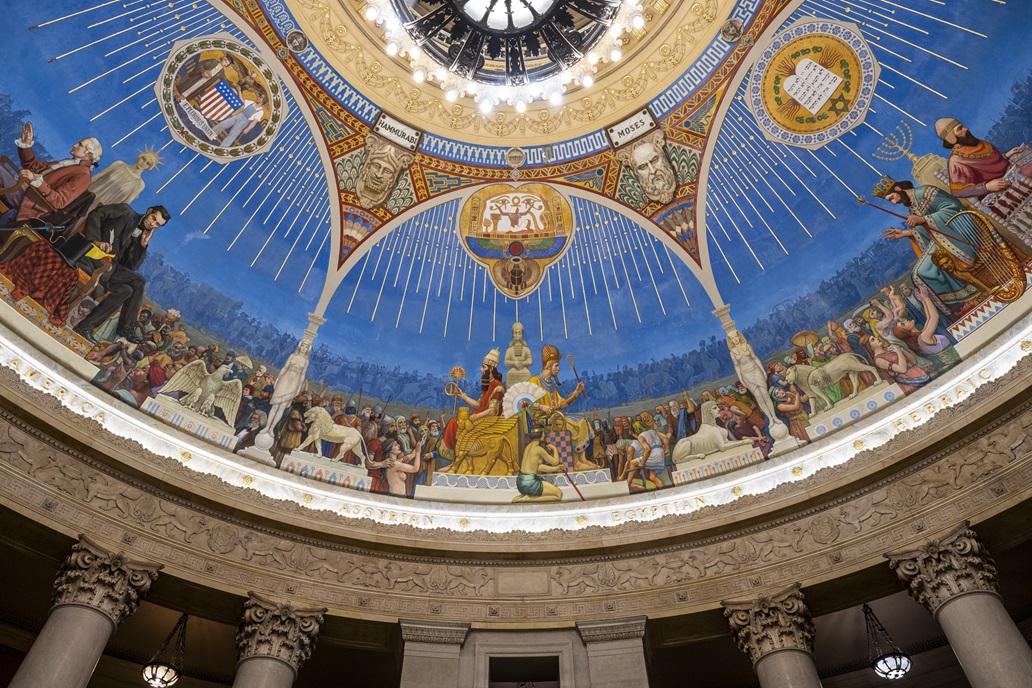
The first historical episode in the first section, though denominated the “Assyrian,” shows Hammurabi (1792-1750 B.C.), a king of the old Babylonian empire in Mesopotamia. In this scene, it appears that a woman has been caught in some alleged offense and has been brought before the king by a soldier while a crowd observes. The king sits in a chair carved into a design of a lamassu, a winged lion with a bearded human head that was a divine guardian in Assyrian culture.
Hammurabi is best known to history for having promulgated the Code of Hammurabi, one of the first written codes of law. The Code, which consisted of 282 laws, created penalties for offenses, many of them quite severe, even barbaric by the standards of today, and it employed what was thereafter called the lex talionis, the notion of “an eye for an eye.” But the Code also limited what the victim was allowed to do by way of retribution and set forth one of the earliest instances of the idea that the accused is presumed innocent. Harsh though the Code certainly seems to us today, Hammurabi was intent on achieving justice through the Code and sought as part of this goal to prevent the oppression of the weak by the strong. Perhaps in the scene we see in this part of the mural the king seeks to protect the weak woman from oppression through the application of his code. He wrote (in the Epilogue to the Code):
That the strong might not injure the weak, in order to protect the widows and orphans, I have in Babylon … in order to bespeak justice in the land, to settle all disputes, and heal all injuries, set up these my precious words, written upon my memorial stone, before the image of me, as king of righteousness.[197]
The Code was important and influential because it was a very early attempt to regulate the affairs of society and interactions between individuals through a fixed body of law so as to advance and maintain peace and justice. It established a single set of rules for all, the powerful and the powerless, and aimed to promote fairness and impartiality. The Code was written in Akkadian, the daily language of Babylon, on a stone pillar (the stele). The stele was placed on public view, and thus was accessible to any literate person. This act of promulgation conveyed to the whole community what the laws were and the expectation that all persons were to adhere to those laws. This is clear from some of the text itself, which is directed to a person viewing the stele.[198]
In the lower left corner of this section of the mural, we see a lion, which was the symbol of Babylon. As we will see, one of the motifs of the mural is the placement of symbols in the corners of each part of each section. Near the lion, at the bottom of the line that creates the arch that separates this section from an adjacent one, there is a painted sculpture of a woman. A figure of this sort appears at the bottom of each of the arches in the mural.
The second seated figure in this section is the Pharaoh of Egypt. Nearby his chair is a chess board. This appears in the mural since it has been thought by some over the years that chess originated in ancient Egypt (the board game senet was definitely played there). In this second episode, two soldiers at the Pharaoh’s feet are beating someone, while farther back in the crowd two other soldiers are controlling a prisoner who is fettered and blindfolded. No doubt the two victims are Jews who are intended to represent the Jewish community generally, which was at the mercy of the Egyptians. We also see Moses requesting that the Jewish people be freed (“let my people go,” said the Lord, according to Exodus). Ultimately, the Jews were liberated after hundreds of years of slavery, but only, the Bible tells us, after a series of plagues had descended upon Egypt, including one that killed the first-born sons of the Egyptians. Pharaoh freed the Jews, but repented of having done so and sent his soldiers after them. The Jews escaped when the Red Sea parted and the Egyptian soldiers were drowned.
This portion of the mural is intended to celebrate liberation from slavery. A sculpture of a sphinx, a symbol of Egypt, is shown in the lower right corner. At the bottom of the arch nearby is a painted sculpture of a woman wearing an Egyptian headdress. Between the two seated figures is a painted sculpture of a pharaoh. This motif of a figure so located is repeated throughout the composition.
The Second Section
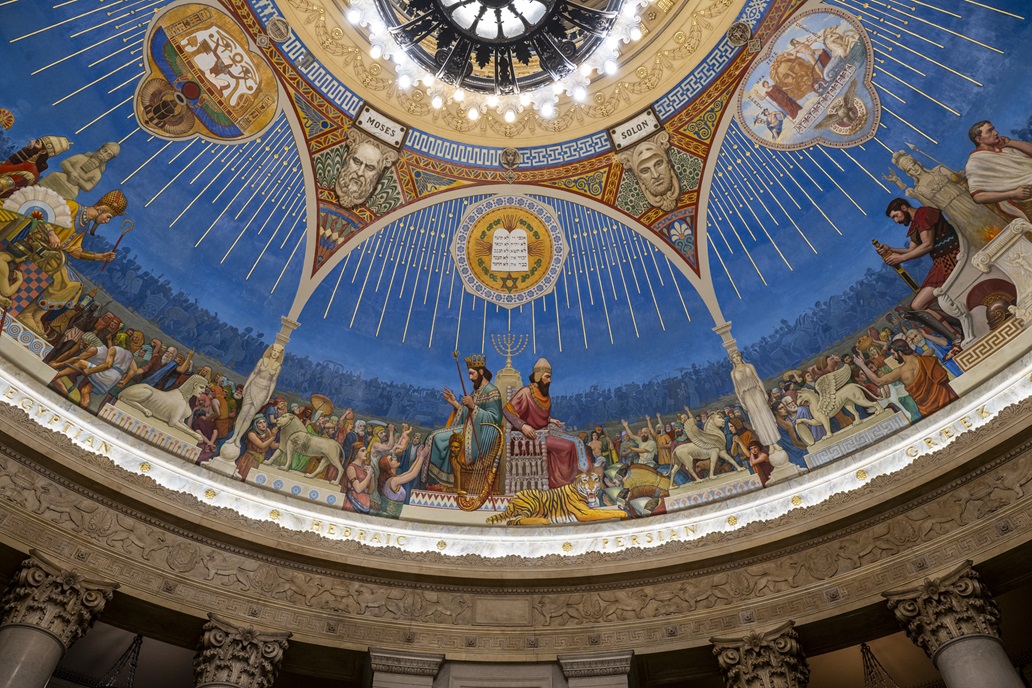
The images on the left of the second section, in the “Hebraic” episode, depict another biblical story, this one very familiar. King Solomon is shown here deciding which of two women, both of whom claim to be the mother of a child, should have custody of the child. We see the child being held by an officer or servant who brandishes a sword and is about to slay the child in accordance with the King’s initial direction. We also see the two women at the ruler’s feet, one of them imploring him more earnestly than the other. The purpose of the story is to demonstrate that the administration of justice should be founded not upon the exercise of raw power, but upon the application of wisdom and judgment. The King is wise because he knows that the true mother of the child will above all else wish to preserve the child’s life and that he would not be required to carry out his apparent threat.
The lion, a traditional symbol of Israel, is shown in the lower left. In the rear of this scene, as with all the other scenes, we see a dense crowd of humanity, painted in dark blue tones and differentiated softly, as it marches forward through time.
The other portion of this section presents the fourth historical episode, which is centered on Cyrus the Great (ca. 590-ca. 529 B.C.), the first Emperor of Persia (Achaemenid Empire). Cyrus, whose life and impact are described by the Greek historians Herodotus and Xenophon, was a great conqueror who built a formidable empire. But he also achieved a reputation for being, by the standards of his day, an enlightened and magnanimous ruler. One scholar says that “[f]ew great rulers have left so good an impression with posterity as Cyrus.”[199] He respected the customs and religious beliefs of the lands he conquered and was open to learning about and applying administrative and other practices of other peoples.[200] After his capture of Babylon, for instance, he did not overhaul the administration and replace all officials with his own selections. Rather, he left the bureaucratic system as it was and allowed officials of the bureaucracy, bankers, and so forth to retain their positions, as a result of which Babylon was able to continue to carry on its economic activity and its civil and religious functions as it had done before the conquest.[201] He did not insist that administrative officials and army commanders be Persians, but was willing to appoint persons from other groups to positions of responsibility if he deemed them able.[202] After his conquest of Babylon, Cyrus decreed that the Jews, who had been deported to Babylon by a prior ruler, were thenceforth free to return to Jerusalem and some 40,000 of them did so in a “Second Exodus.” But he went further, declaring that the temple in Jerusalem would be rebuilt at his expense and that plundered treasure would be returned. For his generosity he was praised in the Old Testament.[203] The understanding of Cyrus’s administrative actions that has come down to us illustrates the application of legal power in a compassionate and generous way that respects the beliefs of others. The value of magnanimity in the application of power and law is what the mural celebrates in this part of this section.
In this scene, three soldiers bow deeply before the king, while members of the crowd appear to be saluting him.
In the lower right a winged griffin is shown, a symbol of Persia. Immediately next to the king is a large lion baring his teeth menacingly, brightly colored and strongly painted. At the foot of the nearby arch is a painted sculpture of a woman. Between and behind the two seated figures is a menorah.
The Third Section
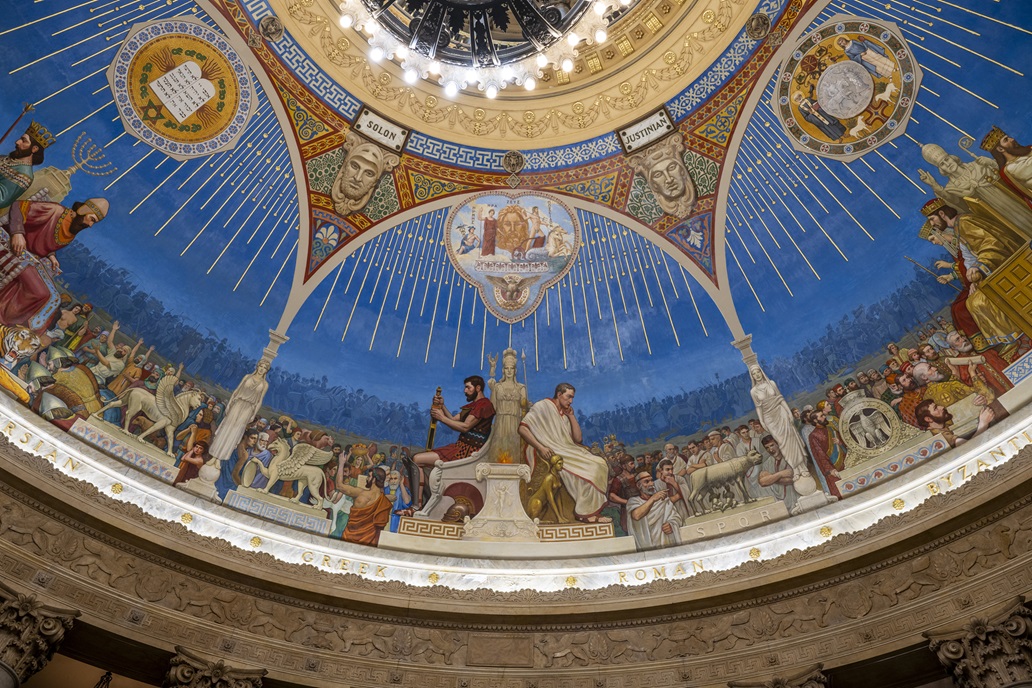
Seated on the left-hand side of this section, that denominated “Greek,” is Solon, an Athenian statesman of the sixth century B.C. (ca. 630-ca. 560 B.C.). Prior to Solon’s day, around 620 B.C., Draco had formulated a body of laws. These laws had been severe, frequently providing, it was said, for punishment by death, even for minor offenses. The laws had mandated enslavement for debt, which became a major grievance of the poor. A later orator quipped that Draco, from whose name the word “draconian” derives, had written his laws, not in ink, but in blood.[204] Solon, about whom Herodotus and Plutarch wrote, served as chief archon of Athens. Perhaps in 594, during a time of social unrest, Solon was empowered to draw up laws. He pursued sweeping constitutional, economic, and moral reforms. He repealed most of the laws that had been issued by Draco. He reformed and rendered less rigorous the rules governing debt, including that which had provided for slavery for debt both for the male debtor and his family, and he forbade all borrowing based upon the person as security. The rate of interest to be paid by tenants was capped at manageable levels. He freed those who had become slaves due to debt and brought back to Athens as free persons those who had been sold as slaves outside of Athens. He issued an amnesty for past criminal offenses. He revised weights and measures, which facilitated trade.
Solon insisted that all citizens earn their own living, in contrast with the ethos of Sparta, where men were encouraged to work only as soldiers. He attracted craftsmen from outside Athens to come work there by offering them citizenship.
Further, Solon enacted reforms that created a sliding scale of privilege, which improved the status of the poor without destroying altogether that of the rich. In addition to facing problems of the poor, Athenian society was weakened by tension between the middle class and the aristocracy. Solon responded to this difficulty by providing for a constitution that divided all male citizens into four census categories, in accordance with their property. All groups would have some degree of political input and men could ascend in rank as their income improved. Male citizens from all classes could serve as prospective jurors, who would try certain legal cases and hear appeals. Anyone who believed that a magistrate had issued an unjust ruling against him had the right to appeal his case. Solon is thought to have created a council of 400 men; members of this body were chosen by lot, so that the elite could not control it. Solon’s constitutional approach gave something to all sectors of society, thereby ensuring that the laws would not be rejected and that society would be stable, while promoting economic growth. By setting up a system in which wealth rather than birth was the important factor, Solon created the concept of an impersonal state, as opposed to arbitrary leadership by an aristocracy, and allowed people to ascend in rank without regard to the circumstances of their birth. This was of great importance for the future of political life.[205]
Solon provided that any male citizen, not just the victim or victim’s relatives, could bring an indictment. By virtue of this reform, justice became a matter of concern for the community of male citizens as a whole, not just the elite.[206] Solon forbade the family of a victim to take revenge upon the killer; instead, it had to commence legal proceedings. This represented an important step toward strengthening the role of the state and the idea of law in a culture in which family and clan had historically had central roles.[207]
Solon was also a poet and some of his verses survive today. He frequently criticized the rich for their avarice and the poor for their leveling revolutionary attitudes. He often identified the desire for wealth as a troubling force in social life. Despite his many efforts to achieve balance in the laws and practices of society (one scholar writes of him that he “seems to have been by conviction one of the great moderates of history”),[208] Solon wrote that “[i]n large things, it is hard to please everybody.”[209]
Solon’s laws were inscribed on wooden tablets that were placed in the agora for all to see and perhaps hear, Greek society having been one in which the spoken word had great importance.
Solon was not a democrat. There was, however, some merit to the assertions made in the Athens of subsequent centuries that Solon was the father of democracy since he had helped to create a free peasantry that formed the basis of the democracy, had given roles to all groups in public life, and had promoted the Athenian approach to citizenship. His reforms also helped to create a political and social system that was dynamic, open to and benefitting from individual initiative and change.[210] At the end of his life, Solon took pride in the fact that he had refused to accept the dictatorship of Athens. “He wanted the people to be contented, but did not want to order them, or to tell them how to achieve this condition; they must find out for themselves.”[211]
Solon’s work can be seen as an early effort in the direction of a democratic form of government and in the humanization of law through reduction in its severity.
We see in the foreground an official reading from a paper setting forth or discussing Solon’s reforms while the crowd of citizens listens. A symbol associated with Greek culture and myth, also a griffin, is shown in this panel.
On the right in this section, in the sixth episode, that denominated “Roman,” is Marcus Tullius Cicero (106-43 B.C.), lawyer, statesman, scholar, and orator of the period of the late Roman Republic, as well as a master of Latin prose. Cicero was born in a town 60 miles from Rome and was not a member of the aristocracy. He traveled to Greece as part of his education and became a lawyer and a formidable and famous orator, undoubtedly the greatest of his day. He became a quaestor, a junior magistrate, serving in Sicily in 75 B.C. This position also gave him a seat as a senator for life. Back in Rome he prosecuted a case against Verres, a corrupt governor, and his arguments became well known. Cicero became a praetor in 66 B.C. and thereby exercised judicial duties in Rome. In 64 B.C., he was elected consul, the highest office in the Republic, the first time in years that a non-aristocrat (a novus homo (“new man”)) had ascended to that elevated position. He defeated Catiline for the post and in the campaign criticized him vigorously and to great effect. Cataline sought the consulship for a second time in 63 B.C., again without success. He then engaged in a complicated plot to stage a revolt and overthrow the Republic. The plot failed. Cicero gave a famous group of orations denouncing Cataline, defending the Republic, and urging him to leave Rome. He was supported by the Senate. Cataline was forced to flee and the conspiracy was defeated.[212]
Later, Cicero advocated on behalf of the Republic and republican values as Rome slid into dictatorship. Caesar invited Cicero to join his alliance with Pompey and Crassus later called the “First Triumvirate,” but Cicero declined out of concern that the arrangement would undermine the Republic. He subsequently gave a series of notable orations, the Phillipics, against Marc Antony in the Senate. In doing this, Cicero took a considerable personal risk; Antony held a grudge that ultimately cost Cicero his life.
Cicero was a dedicated writer and thinker. He wrote extensively on matters of politics and philosophy,[213] as, for example, in De re publica and De legibus.[214] In his writings, orations, and political career, Cicero was above all a forceful proponent and defender of the Republic and an enemy of the dictatorship that was to come to pass under Caesar. Cicero and other writers of the golden age of Roman literature “set forth republican ideals and political and social values that have had a powerful and lasting effect on Western culture.”[215] Cicero’s influence was felt during the Renaissance and the Enlightenment; he was a means by which Roman and republican ideas and values were given a rebirth in Europe. In the decades prior to the revolution in the United States, republicanism as represented by Cicero became of profound importance, both as a cultural influence and as a political and legal one. Republican ideals were immensely influential with the founding generation, as a spur to the revolution and as an inspiration in the development of the political and legal structures of the new country.[216] As a writer and as a political actor, Cicero has long been a symbol of the importance of republicanism and adherence to law and that is why he is the protagonist in this part of the mural.[217]
In this portion of the section, we see Cicero presiding in the Senate as Cataline is accused of betrayal of the Republic. Before him is a crowd of citizens, Roman soldiers, and senators. In the lower right there appears a painted statue bearing the letters “S.P.Q.R.” (abbreviation for the words for “the Senate and the People of Rome” in Latin) and showing Romulus, Remus and the wolf, the symbols of the founding of Rome. Here, as throughout, there are painted sculptures between the two main figures in this section and at the end of the nearby arch.
The Fourth Section
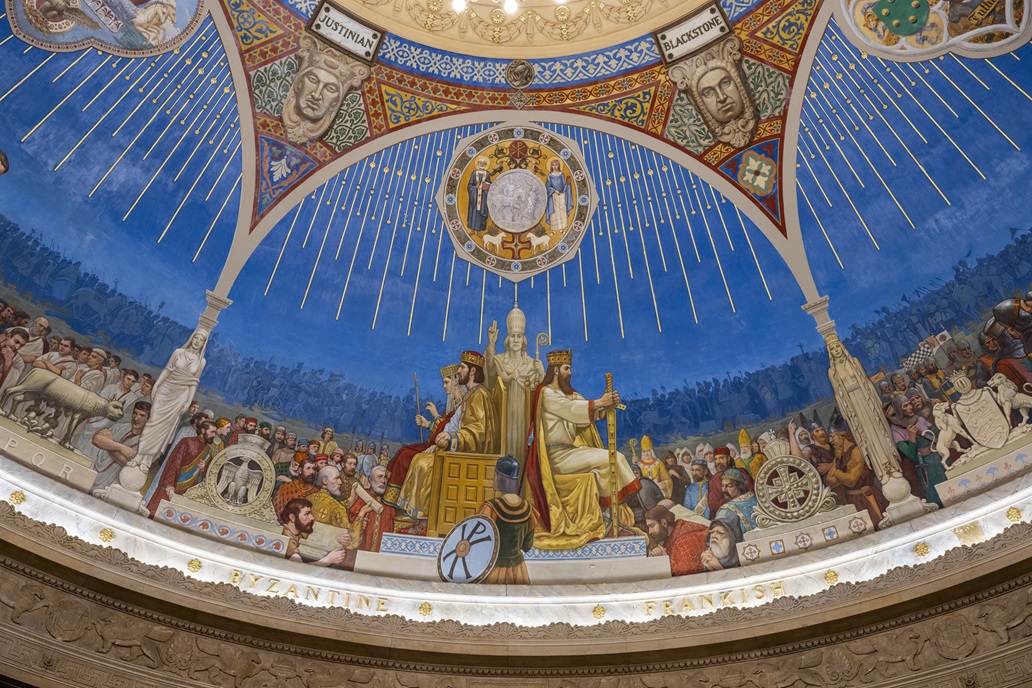
In the left-hand side of the fourth section, denominated the “Byzantine,” two figures are seated, the only duo that appear together in any portion of the sections of the mural. The two are the Byzantine Emperor Justinian and his wife Theodora. In the sixth century A.D., Justinian directed that a study be made of the constitutions and laws of the previous Roman emperors and compiled a code of laws, which came to be known as the corpus juris civilis, together with a collection and summary of the writings on law and justice of the jurists of the classical era.”[218] Justinian’s aim in undertaking this work was to foster unity in a complex and fractious empire.[219] The Code of Justinian proved to be a milestone in the development of law in the western world over succeeding centuries. The heritage of Roman law was forgotten for a time after the fall of the Western Roman Empire, but it was recalled in the Middle Ages. Surviving manuscripts of the Code of Justinian were rediscovered, copied, and studied in a systematic way, and the Code became the basic source of Roman law in the culture of the West. All subsequent systems of law in the West borrowed from it, including the English common law, which in turn, of course, became the principal source of law in the United States.[220] It is this greatly productive development in the history of law that is commemorated in this part of the mural.
In the crowd below the two protagonists we see richly-dressed men presenting scrolls that contain the laws of the Code. Standing prominently near the Emperor is a soldier holding a shield that bears the chi-rho, a symbol of Christ, arranged as a monogram, composed of the first two letters, X and P, of the name of Christ in Greek superimposed one on the other. This monogram developed under the reign of Emperor Constantine I and was used as a symbol of Christianity in its early centuries. Justinian’s seal is in the lower left-hand corner of this part of the mural.
Charlemagne, or Charles the Great, King of the Franks and Holy Roman Emperor (800 A.D.), is seated on the other side of this section, that denominated “Frankish.” In the crowd we see monks and nuns and other religious figures, as well as soldiers and some well-dressed men. One of the religious figures might be Pope Leo III, who famously crowned Charlemagne as Holy Roman Emperor in the old St. Peter’s Basilica in Rome. Some in the crowd bow before Charlemagne.
Charlemagne united most of western Europe under one authority for the first time since the classical era of the Roman Empire. This gave western Europe an existence and identity as the “second Rome,” separate from the Byzantine empire and greater than the positions of the individual peoples who made up the parts of the new entity, and from this much was to grow over succeeding centuries. On his seal Charlemagne had inscribed the words “the renewal of the Roman empire.” The Holy Roman Empire lasted for a thousand years and under it, the western way of life, culture, and institutions flourished. Beyond this, what set Charlemagne apart from his predecessors was his deep interest during his 46-year reign in pursuing and promoting intellectual pursuits. His reign in many respects became a period of cultural and intellectual growth and artistic development, which is commonly referred to as the Carolingian Renaissance, a renaissance of literature and art.[221] One scholar writes that “at the least it can be said that after several centuries of almost complete stagnation in all forms of culture the Carolingian period saw the awakening of intellectual activity, particularly in the monasteries ….”[222] Charlemagne promoted schools, books, learning, and libraries and he increased support for monastic schools and centers for book-copying to preserve and make available hand-written manuscripts. Many monasteries became centers of the culture of the time. In the scriptoria of the monasteries, the most famous of which was St. Martin of Tours, many manuscripts were copied and preserved for future ages. The scriptoria “might almost be called factories for copying manuscripts.”[223] Among the items that were copied there were official documents, such as collections of property titles, but the most important work of these centers was the copying of the Bible, works of the early Christian period, and the works of antiquity, including much of the classical writing that had survived to that time. The scriptoria generated a new and beautiful form of script, the Carolingian miniscule, that, apart from its beauty, improved upon its predecessor, the Merovingian script, by making writing clearer and much more legible, the Merovingian having been almost impossible to read. The miniscule became a unifying force in the empire and the new standard of writing for centuries in the West, and it had an immense impact on the scripts of later times. The Carolingian was so sensible and clear that the first book publishers of the 15th century used it for their type.[224]
Thus, Charlemagne played a major role in spurring a renewal of interest in classical antiquity, the preservation of the classical heritage, and its transmission in later years; a large part of the classical writing that is known today was preserved in the monastic writing centers. He promoted writing not only of a religious nature, but of a secular one as well in many fields of endeavor. He encouraged the creation and maintenance of private libraries, which flourished. The single most spectacular manifestation of the intellectual rebirth he sponsored was the academy of the palace, which he established. He was personally interested in cultural pursuits, frequently having books read to him. He took pains to learn foreign languages, acquiring such proficiency in Latin that he recited his prayers in that language as well as his own. It is poignant to note, however, that, despite his critical role in preserving and extending the influence of the written word, he was unsuccessful in learning to write, notwithstanding strenuous effort and despite keeping his tablets and writing book under his pillow.[225]
The Carolingian world “was marked by the beginnings of the application of intelligence to the problems of society, and … this development was of the greatest importance in medieval civilization, for it marked the starting point for the political and intellectual growth of later centuries.”[226] An example of this, in addition to the Carolingian script, was the establishment of a new and reliable currency based on simple fundamentals. This currency was very successful. A similar element of rationalization had to do with Germanic methods of proof in the law. These methods were problematic and so the Carolingian courts created the inquest, whereby a panel of men from the area sworn to an oath would state their opinion in disputes about land ownership. The inquest was continued later in Normandy and was carried from there by William the Conqueror to England, where it developed in the course of time into the English common law jury. Further in the area of law, Charlemagne issued decrees (capitularies) that applied throughout the kingdom, thus bringing a royal centralizing influence to local areas otherwise inclined to go their own way.[227] In the field of government administration, the Carolingian court appointed royal officials to administer the localities and also sent emissaries on periodic visits of inspection in the localities to maintain control over the royal officials.[228]
All of these advances under Charlemagne helped to build an indispensable foundation for the development of reason and law in western Europe in succeeding centuries. Charlemagne’s impact was recognized in his own lifetime, as he was called by some the “Father of Europe,”[229] and that name continues to be used to this day.[230]
In the lower right-hand corner of this portion of the mural we see an insignia intended to be associated with Charlemagne.
In the customary position between and behind the two principal figures in this section of the mural is a painted sculpture of the pope.
The Fifth Section
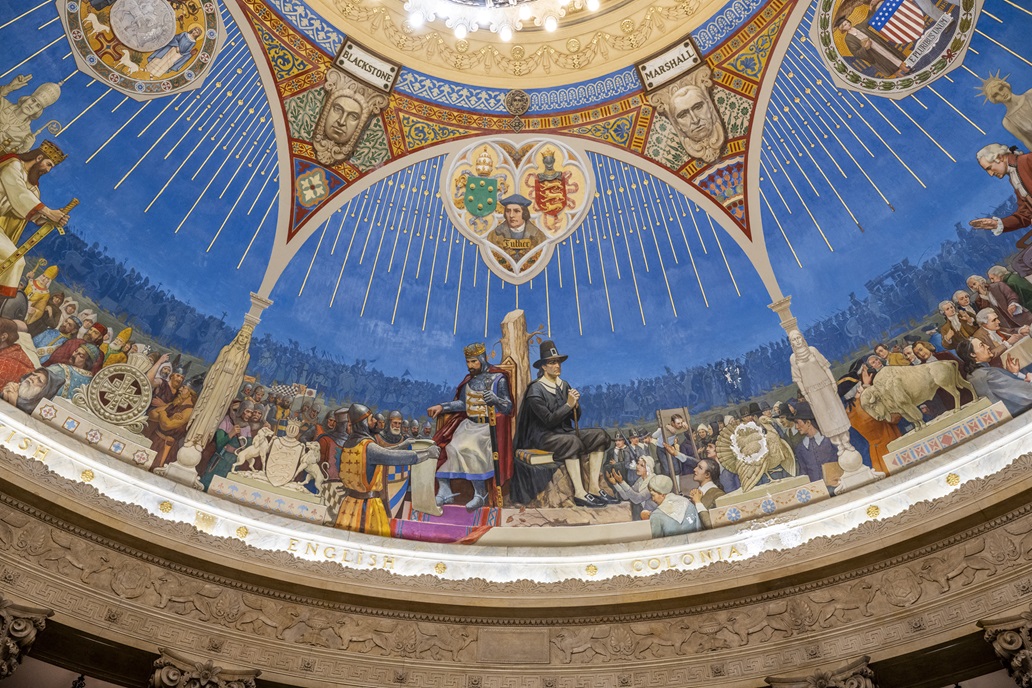
On the left portion of this section, in the episode denominated “English,” appears the seated figure of King John of England, who receives the Magna Carta (1215 A.D.). This document, formally called “Magna Carta Libertatum” (Latin (the language of the document) for “Great Charter of Freedoms”), issued by the King and his barons, set out restrictions on the powers of the king, reflecting the principle that the king and his government were subject to, not above, the law. Once, kings had been viewed as holding office by divine right and were considered, or considered themselves, the ultimate and absolute political authority. With Magna Carta, the law assumed eminence in Great Britain and the concept of formal legal rights that could not be denied by the political realm was established.
The Magna Carta was first issued at Runnymede in Surrey. It was the product of significant unrest on the part of leading barons and thus was forced upon the King. The barons presented the “Articles of the Barons,” which became the basis of negotiations for a final document, which was drafted under the influence of the Archbishop of Canterbury. The final document contained 63 clauses in which King John dealt with grievances about his rule, including regarding ownership of land and taxation. Among these provisions were some articulating fundamental values that restrained the power of the king and that proved to be very useful in the centuries that followed. The charter provided that taxes could not be exacted without the “general consent of the realm,” that is, the leading barons and churchmen. It established that fines could not be imposed except as calibrated in accordance with the severity of the offense. The most important of these provisions for the advancement of individual rights was the 39th clause, which gave to all free men the right to justice and due process of law,[231] as follows:
No free man shall be seized or imprisoned, or stripped of his rights or possessions, or outlawed or exiled, or deprived of his standing in any other way, nor will we proceed with force against him, or send others to do so, except by the lawful judgement of his equals or by the law of the land. To no one will we sell, to no one deny or delay right or justice. [232]
The King and the barons did not adhere to all of their obligations under Magna Carta, the charter was annulled by the Pope, and a war followed. But the charter was reissued several times thereafter in different versions and in 1297 Edward I confirmed it as a part of England’s statutory law.
Despite the travails in years after 1215, Magna Carta was recognized in Great Britain as a foundational document of liberty and of the constitution, and its influence down the centuries was immense. Magna Carta and the idea of the formal expression of protection for individual rights and due process of law were highly influential in the American colonies and in the formation of the Constitution of the United States, and in many other countries. Due process of law is one of the most basic elements of our constitutional and legal systems, as is the case in many other countries around the world. The mural celebrates Magna Carta as a symbol and manifestation of the ideals of the rule of law and the rights of the individual.
In the mural, we see the knights assembled at Runnymede as they present the document to King John. In a reflection of historical fact, the King does not appear to be happy at the event. Following the pattern of the other sections of the mural, the coat of arms of the King is in the lower left-hand corner.
On the right-hand portion of this section of the mural, labeled “Colonial,” is a portrait of a seated Puritan leader, someone such as, perhaps, William Bradford or John Winthrop. Bradford was an Englishman who came to the New World after years spent in Holland, was one of the original settlers of the Plymouth Colony in 1620, and was elected by the colonists governor of the colony, in which capacity he served on and off for over 30 years. Winthrop was a lawyer who led a large expedition to America in 1630 to establish what he called “a Citty upon a Hill,” what became the Massachusetts Bay Colony, founding Boston and some surrounding villages. Winthrop was elected governor of his settlement four times.
The separation of church and state did not exist in this period in Massachusetts. By the standards of today, the culture and politics of the period did not fully respect the rights of individuals and toleration of dissenting religious views was not practiced as it came to be later in American history. The colonies adhered to the traditional rights of Englishmen, but they were interpreted through the prism of the religious orthodoxy practiced in the particular colonies. The Puritans insisted on adherence to the religious beliefs of the colony, the colony being identified with the prevailing religion. We can point to many examples of this. For instance, there often were disputes within the colonies and these frequently were resolved by the dissenters, facing intolerance of their beliefs, leaving the colony and setting up their own community elsewhere. Roger Williams and Anne Hutchison were banished from Massachusetts and went to what became Rhode Island because of their dissenting religious views. There were the Salem witch trials. Sometimes harsh punishments were visited on disfavored individuals or offenders and on those who departed from the prevailing religious practices or beliefs. We see something of this in the mural, where in the crowd a man is being held up to public punishment in the stocks. In 1630, Governor Winthrop burned down the house of one Thomas Morgan for erecting a maypole and engaging in revels and clapped him in the stocks as well. The following year, Philip Radcliffe was whipped and had his ears cut off because he issued invective against the church and government. Nevertheless, the Puritans were examples, advocates, and practitioners of religious freedom. The colonists at Plymouth who came to the New World were Separatists from East Anglia who first went to Holland and then crossed the ocean to escape religious persecution under King James I. They sought to establish a colony in which they could put into practice their religious beliefs without interference. John Winthrop and his followers, dissatisfied with the Church of England as it was in the home country, sought to establish in the New World an ideal spiritual and secular community that would live the true Anglican religion as they understood it. The colonies were to be and were self-governing and largely independent of Britain. The Plymouth colonists decided on their voyage that the colony would be an institution in which issues would be decided by voting, and they committed themselves to do so in the “Mayflower Compact,” one of the foundational documents in American history. The royal charter of the Massachusetts Bay Company was transferred to the colony along with the government and members of the company, which ensured independence from royal government in Britain. The colony was governed through the votes of church members and officials elected by them. Though imperfectly, then, the Puritans are symbols of religious freedom and of freedom more generally and of the principle of democratic government.[233] They also stand for courageous idealism in action, which Americans admire. These are the values that the mural commemorates in this section.
In the lower right-hand corner of the section is a turkey, a bird indigenous to North America that is, of course, linked in the public mind to the colonists of New England. At the bottom of the arch is a painted sculpture of a Native American woman.
The Sixth Section
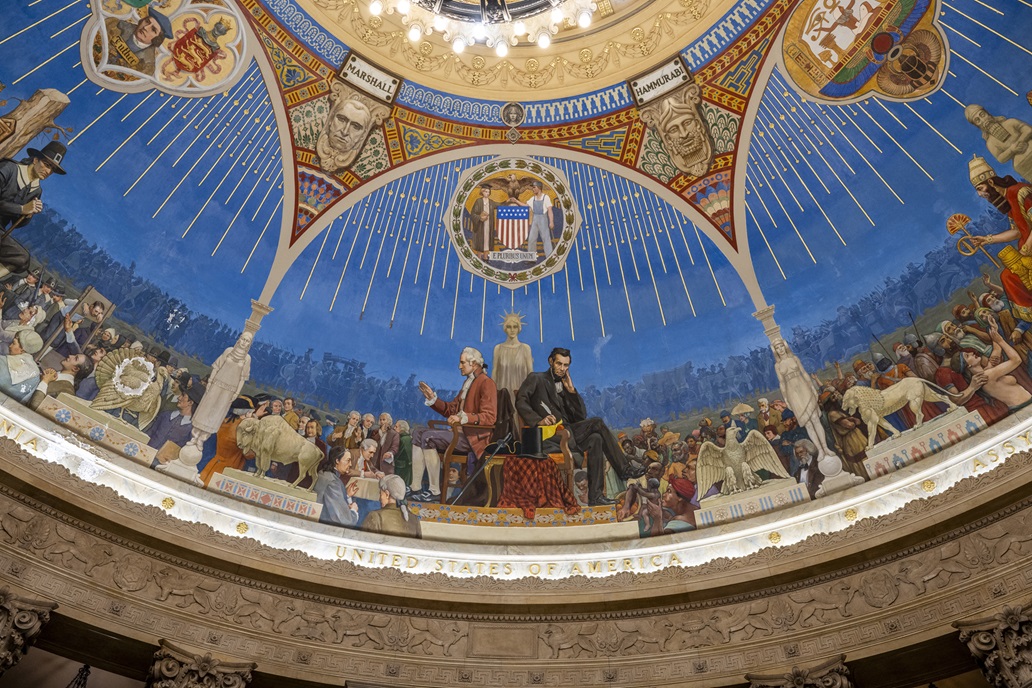
This last section of the mural is denominated “United States of America.”
On the left-hand side of the section is a skillful portrait of President George Washington. Dressed in civilian attire, having surrendered his military commission at the conclusion of the war, he presides over the Constitutional Convention, which gathered at the Pennsylvania State House in Philadelphia in 1787, where the Constitution was drafted before it was transmitted to the colonies for consideration and ratification. We see members of the Convention or founders generally arrayed before Washington and engaged in discussion and debate. Among the figures assembled are Benjamin Franklin and Alexander Hamilton, who is seated at a desk writing, and perhaps James Madison and John Adams. Hamilton and Madison were two of the three authors (the other being the New Yorker John Jay) of The Federalist Papers, which work argued effectively for ratification of the Constitution and has since served as a fundamental source for understanding the intentions of the Framers.
In the lower left-hand corner is a bison, which is identified with American history. The American bison is the more numerous of the two extant species and is native to North America.
In this part of the section, the muralist honors the ideals of the constitutional framework and system of the United States, a system of ordered liberty, in which the rights of the citizens are protected by the fundamental law and the laws and policies of the country are debated and decided upon, not by a monarch like King John, but by the people themselves through their chosen representatives. It is also a system in which the leader of the country serves but a limited time in office, a precedent established by Washington, whose willingness to surrender power had earned from King George III, his political and military adversary, the encomium that he was “the greatest man in the world.” Imperfect though the Constitution was, and much as the working out of the principles of the Constitution at the time of the founding and since was and has been flawed, the Constitution and its enshrining of democratic government, the rights of the individual, the principle of equality of all men, and the principle that a more perfect union that would establish justice and promote the general welfare would be the task of and decided upon by “We the People” were profound innovations of worldwide importance, both for the cause of decent government in the world and for the progress of the rule of law. In the words of a great historian, “[i]t was the Revolution, more than any other single event, that made America into the most liberal, democratic, and modern nation in the world.”[234]
On the right-hand portion of this section the mural addresses the great failure of American law, justice, and the American democratic system. Here we see President Abraham Lincoln in his typical attire, with his famous hat and shawl on a nearby table. He is writing the Emancipation Proclamation, which he issued on January 1, 1863. In a preliminary Emancipation Proclamation of September 22, 1862, he had announced that, on the following January 1st, all persons held as slaves in the rebellious states “shall be then, thenceforward, and forever free ….” This action freed millions of enslaved persons. It also opened the way so that, once the war was won, slavery could be abolished by the 13th Amendment to the Constitution and the 14th and 15th amendments could be added to the founding document.
In the usual position below the figure of Lincoln we see 17 enslaved persons representing the enslaved population generally, who wait anxiously for the completion of the Proclamation, although, as we know from the Juneteenth national holiday, many were unaware of its issuance for a long time. Also present are some Union soldiers, other figures and, in the lower right-hand corner, Frederick Douglass, a towering advocate for the abolition of slavery and freedom for all. In the customary position, we see a bald eagle, a symbol of America.
The Proclamation was a central element in the second American founding that occurred in those years and concerning which the Civil War was fought. It represented a great advance for the rule of law and the cause of justice in the democracy of the United States. The mural is a depiction of that moment. But, as we know, that founding could not remedy the “bondman’s two hundred and fifty years of unrequited toil,” in the words of Lincoln’s Second Inaugural. Nor was the “new birth of freedom,” as he put it at Gettysburg, to be fully achieved, despite the Civil War amendments. Instead, in defiance of those amendments and Reconstruction, for many decades, until the civil rights movement and the Civil Rights Acts of the 1960’s, the future was to a substantial extent to be Plessy v. Ferguson, Jim Crow, lynchings, and the Ku Klux Klan, especially, of course, in the South. So, as the mural commemorates the events of achievement in the advance of the law through history, it also calls upon the Supreme Court of New York State, all the courts, and the legal system as a whole to do what they can to achieve a more nearly perfect Union and a system of law that truly attains its aims for the benefit of every person.
Between and behind the two main figures is a painted sculpture of a female symbol of liberty, perhaps based on or recalling the Statue of Liberty.
Finally, we describe the shields or circles in the upper portion of the mural that sit over the center of each of the six sections.
In the center over the “Assyrian” and “Egyptian” sections is a shield. Within it is a figure of an ancient Egyptian, snakes, and two wedjat eyes (“Eye of Horus”), symbols from ancient Egyptian religion that represented well-being, healing and protection.
In the center over the “Hebraic” and “Persian” episodes is a circle containing tablets with the Ten Commandments written thereon in Hebrew and the Star of David.
In the center over the “Greek” and “Roman” episodes is a shield. Within it are pictures and the names in Greek of Hermes (with his symbols), Hera, Zeus, and Poseidon (with a chariot).
In the center over the “Byzantine” and “Frankish” episodes there is a circle. In the center is what may be an image of a coin from the time of Justinian. On either side of this are a male and a female saint. At the top of the design in the center is the chi-rho symbol.
In the center over the “English” and “Colonial” episodes is a shield. Inside it at the bottom is a portrait of Martin Luther (1483-1546) with his name underneath. Above his shoulders on either side are coats of arms of Pope Pius IV (1559-1565), derived from the Medici, of whom this pope was one, and the King of England. All three are linked to the Protestant Reformation. Luther, of course, was a seminal figure in the Reformation. Pope Pius IV concluded the Council of Trent, which was important to the Counter-Reformation. The King of England became the leader of the Church of England.
The presence of Luther in this mural generated a controversy. A Supreme Court Justice from the Bronx and some others objected to his inclusion. The objection was made known to various authorities and a meeting was held at which Mr. Pusterla and the objectors were present. The complainants asserted that Luther should not be in a mural depicting the progress of law and lawgivers. Mr. Pusterla rejected the criticism, believing that the Protestant Reformation, which had, among other things, attacked corruption in the culture of the time, had had a significant influence on the growth of the law and asserting that Luther’s role in the Reformation entitled him to be considered a great lawgiver. It was reported that the dispute was settled by the Borough President, Samuel Levy, who decided that, in order to avoid complaints of discrimination, Luther’s name would be painted out.[235] Of course, either President Levy changed his mind or his directive was, for some reason, ignored since the figure and name of Luther were present in the mural when it was completed. It might also be possible, however, that Pusterla had originally put Luther in the group of six great lawgivers along with Solon, Marshall, Blackstone, etc., in place of one of the six we see today, and that the resolution of the dispute involved his removing Luther from that grouping and placing him where he is now. The newspaper accounts of the time do not shed any light on this hypothesis.
In the last of these designs, over the “United States of America,” the circle is painted with a mosaic as a background. Inside the mosaic at its apex is an eagle. Below that is a shield of the stars and stripes. On either side of this shield are a contemporary man and woman. They hold hands as though each is helping the other. The man is a workman dressed in overalls and a workman’s cap and the woman is dressed in an academic cap and robe and holds a book in her hand. They may symbolize labor and learning or be illustrations of the social progress and achievements that are possible for men and women under a system of law and democratic government. Beneath them is a plaque bearing the words “E Pluribus Unum,” “Out of Many, One,” the traditional motto of the United States, which appears on the country’s Great Seal, and an aspiration which the founders of the country sought to make into a reality through the Constitution.
The Rotunda Ceiling as a Composition
The rotunda ceiling is spectacular. Setting aside the complex matter of the medium to be employed, the muralist who plans to execute an artistic scheme and to bring a theme to life convincingly through the use of multiple panels, as in the cases of Maurice Sterne and Boardman Robinson at the Justice Department Building for the Treasury Section or Reginald Marsh at the Custom House for the TRAP, confronts problems that are different in some regards from the ones with which Mr. Pusterla had to grapple when he faced the vast expanse of curved plaster “canvas” high off the ground at the County Courthouse. The design Pusterla came up with is well-organized and balanced, while being beautiful and effective. As our description above elucidates, Pusterla’s composition is very rich and detailed, and is carried out through many elements. These details are laid out in a careful, coherent manner. There are zones within the painting that seek to advance the theme in different ways, but without impinging on or interfering with one another. The frieze in dark blue showing the march of humanity was carefully placed where it was and was painted as it was to achieve specific purposes in the overall composition, including serving as a linking device, and it does that very effectively. The main action of the painting is accorded the prominence that it deserves in the general scheme and each episode is defined distinctly. The quality of the painting is excellent. The mural was delicately and finely painted,[236] and the colors used were many and varied; in the words of one observer, the mural is a “resplendent work, which glows with gorgeous color.”[237] Today, almost 90 years after the work was completed, it is amazing how bright and vibrant the colors remain.
We can appreciate further the extent of the achievement that the ceiling represents if we reflect on the standards of mural painting explained earlier by Holger Cahill. Pusterla was successful in meeting these standards. The composition adds greatly to the harmony of the space. The theme of the work is elaborated in a design on a large scale, one suited to the vastness of the ceiling surface. This mural is among the largest works of its kind among all of the best murals in the city of New York and, as was noted earlier, is certainly one of the largest of the murals undertaken by the Federal art programs. It has the largeness of spirit a mural should strive for and it certainly has carrying power. And its artistic scheme presents a rhythmic order that encourages the eyesight of the viewer to move smoothly over the surface and to appreciate all the elements of the mural across the whole space of the ceiling. It is not too much to say that the ceiling is a triumph of the muralist’s art.
It is enlightening to compare Pusterla’s work to the beautiful mural on basically the same theme by H. Siddons Mowbray (who also did, among other things, the murals in the University Club and the Morgan Library, with assistance from one of the other 60 Centre muralists, Andrew T. Schwartz) in the lobby of the Appellate Division, First Department.[238] The courthouse opened in 1900 and the murals in the building, which the architect, James Brown Lord, oversaw in an effort to create, with the building itself and its sculpture, a unified artistic whole, quickly achieved renown. These murals, done by Edwin Blashfield, Kenyon Cox, and other leading artists, “represented the zenith of American mural painting.”[239] Mowbray’s mural thus must have been known to Pusterla.
Mowbray’s painting is exceptionally beautiful and impressive. It is entitled “Transmission of the Law.”[240] It presents the evolution of law through the centuries starting with Moses and the Ten Commandments and followed by a seated Pharoah and attendant, a Greek lawgiver and orator, a Roman emperor enthroned, a Byzantine emperor, a Norman king, a British king in the common law period, and finally two American judges with a capitol and a courthouse in the background. There is also a central allegorical panel of “The Law.” To both link and separate the various episodes of the scheme, Mowbray uses very beautiful, large, winged female figures, who are dressed in flowing robes of a timeless character and varying colors. Mowbray’s mural is said to exhibit “Renaissance formality,”[241] and he was known to have looked to contemporary French muralists.[242] He was also heavily influenced by the work of Pinturicchio in the Borgia Apartments in the Vatican for his project at the University Club.[243] But the female figures and others, such as the Pharaoh and the Greeks, also all exhibit a modernity and solidity to their aspect that are notable, and must have been particularly so in 1900. These figures are quite unlike, say, the angels one might see in a rococo painting of the 18th century. Mowbray sought to paint in a style linked to the Renaissance, but transmuted in a modern key. Even today, almost 125 years after the mural was created, these figures seem to the viewer to be modern persons in various forms of antique garb rather than historical figures naturally rendered or rendered in a traditional Renaissance or rococo style, and this distinction gives them an emotional connection to the viewer and a universality that figures in a purely historical style would not achieve. One scholar observes of Mowbray’s work at the University Club, but in words that are applicable to the “Transmission of the Law,” that “Mowbray’s murals were existing in two realms: in modern time, but not of it, and in the Renaissance, but not of it.” [244]
Each episode is identified by a plaque below containing a descriptive word, such as “Egyptian” and “Norman.”
One can readily imagine that this mural influenced Pusterla as he drafted the scheme of his composition. The theme is the essentially the same, although, to be sure, the growth and improvement of the law over time is a natural, almost inevitable, theme for a courthouse. Mowbray presents the advance of the law through historical epochs that are depicted generally. For the most part, Pusterla covers the same historical ground that Mowbray depicts, but does so by concentrating, not on generalized images, but on specific events or episodes. Whereas Mowbray addresses the transmission of law in America through a single image, Pusterla concentrates much more attention on the story of justice in America, giving us two scenes of American history, while also recounting that history in the frieze of marching figures. Pusterla finds a device, repeated throughout, to give each episode its own identity. In place of the exuberant female figures that Mowbray uses very creatively, he employs the archways that flow out of the top of the ceiling. But the frieze that runs across all the separate sections of Pusterla’a composition also serves as a linking and unifying element. He uses the same method to identify the episodes that Mowbray uses. And, as Pusterla himself explained in the quotation given earlier, he deliberately placed and painted the frieze in such a fashion as to achieve a thematic goal, but to do so in a manner that advanced a technical objective, the achievement of a sense of depth in the composition.
The separating device that Pusterla employs does not have comparable beauty to Mowbray’s splendid winged figures, nor does it have the same impact in the painting. Mowbray’s winged figures are as large as the principal figures in the painting and their movement and colors further call attention to them, and yet Mowbray manages to paint them in such a way that they do not interfere with or distract from the presentation of the various epochs.
There are some things about the challenge that faced Pusterla that distinguish the rotunda ceiling from Mowbray’s work. The latter is a frieze 62-feet long, but it is only 44 inches high.[245] Pusterla had to express his theme over a vastly greater space, which means more freedom and opportunity, but also, of course, a much greater challenge. The architecture of the room in which Mowbray worked naturally helped to create the rhythmic flow of his work, although it has to be said that the space was also an awkward setting, as he had to work with and around a staircase and an elevator. The top and the bottom of the painting are the ceiling and the top of the marble walls of the lobby. At the County Courthouse, the shape and vast extent of the ceiling required Pusterla to create rhythmic flow in his composition entirely on his own. In addition, Mowbray did not have to paint his work two floors above the level of the viewer and contend with the difficulty for the viewer that such distance creates. And Pusterla was further challenged by the need to take into account the distorting effect of a curved surface whereas Mowbray’s “Transmission” is painted on a flat wall.
II. The Murals of the Upper Floors
Murals were painted on the upper floors around the time of the completion of the work on the rotunda ceiling, or as that work was coming to an end. Most of the murals were painted by four muralists, although Mr. Pusterla also contributed some important painting as well. Who were these other muralists?
A. The Other Muralists
The muralists who worked on the murals at 60 Centre under Pusterla were some painters who achieved success in their work elsewhere, namely, Andrew T. Schwartz, Winthrop D. Turney, Robert K. Ryland, and John Edwin Jackson.[246] Given the large scale of the mural work that was ultimately done over the years on the first and second floors, Pusterla also had, as I noted earlier, a number of assistants working under his immediate direction. He may have had assistants who worked with him on murals he did on the upper floors. Who these assistants were is lost to us in the fog of time.
I have said that Mr. Pusterla provided overall supervision and consultation for the murals done throughout the courthouse. I base this statement upon the fact that he alone was identified as the painter for the murals in all of the applications for approval that were submitted to the New York City Art Commission and his name appears elsewhere in the Commission’s files, such as on renderings done for two large murals for Courtroom 408 signed by him on the reverse. The mural work at the courthouse would also have been subject to general supervision by the mural department of the Federal Art Project, headed by Burgoyne Diller, to which designs would normally have been submitted for approval in stages as the design work progressed. Now I turn to the main muralists other than Mr. Pusterla whose work we see today in the courthouse.
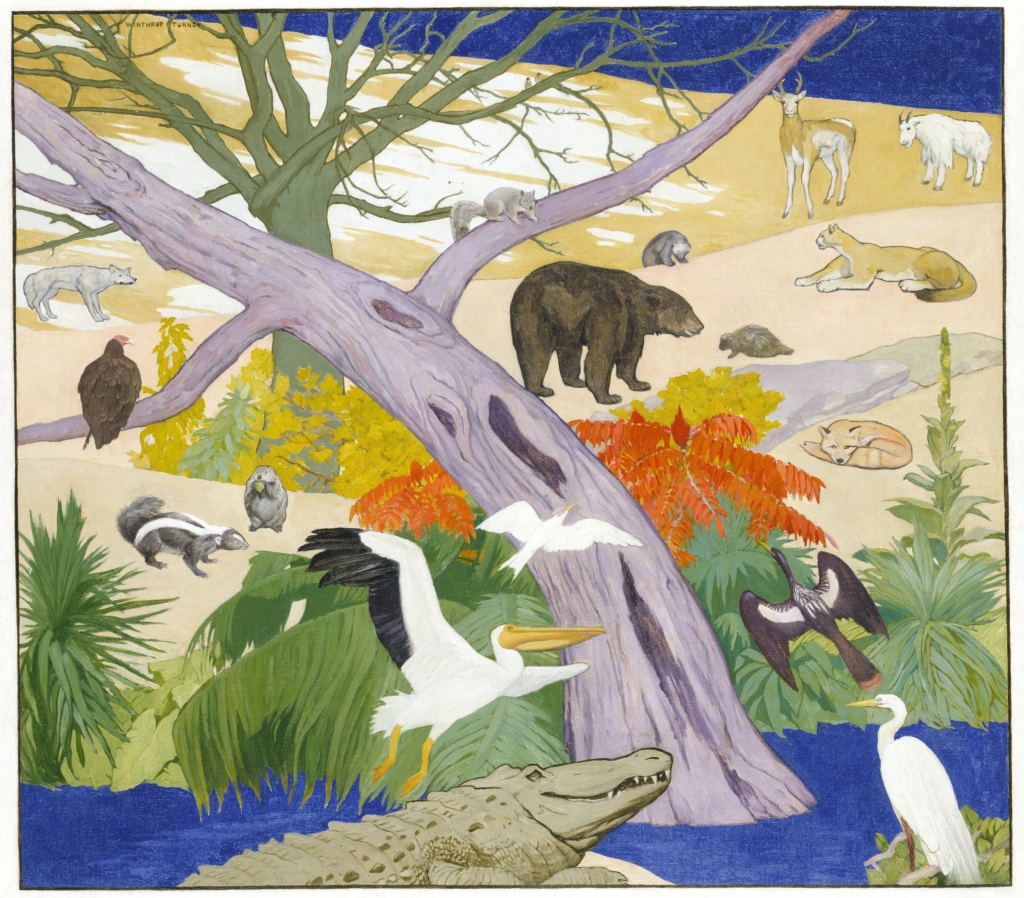
Winthrop D. Turney was a New York artist, born in Brooklyn in 1884, the only New Yorker among the four muralists. He studied at the Art Students League under John Henry Twachtman, George De Forest Brush, Frank DuMond, and Louis Loeb. He was a member of the Brooklyn Society of Artists, the Fifteen Gallery Group, the Artists Fellowship, the Brooklyn Society of Modern Artists, Brooklyn Painters and Sculptors, and the Allied Artists of America, which gave him an award in 1944. He took part in many exhibitions, such as at the Whitney Museum, the Museum of Modern Art, the Brooklyn Museum, the Newark Museum, the Allied Artists, the Milwaukee Art Institute, the Pennsylvania Academy of Fine Arts, the National Academy of Design, the American Watercolor Society, and the Fifteen Gallery. Turney painted murals and, in the 1930’s and 1940’s, did watercolors. He was a friend of George Luks, a member of the Ashcan School (“the Eight”) who was also a teacher at the Art Students League.[247] Though not an adherent of the group, Turney did take some inspiration from Luks. Turney was known for scenes of urban life, such as images of Brooklyn (the waterfront, the Gowanus Canal, street scenes), as well as pastoral scenes of Gloucester, Massachusetts and Mountainville, New York and still lifes, which he often executed in Mountainville. He was essentially a realist painter, although the modernism of the early 20th century did influence him, which was manifested in “his expressive use of paint and vibrant color contrasts.”[248] In many of his paintings, he used a “bright, poster-like palette,”[249] such as in his colorful Selection from Birds and Animals of the United States (1934) in the Smithsonian Museum of American Art, which he had intended would become a large mural for a school.[250] He was married to the painter Agnes Millen Richmond (1870-1964), who had also studied at the Art Students League and who taught there in 1910-14. He and his wife often painted during summers they spent in Gloucester and Mountainville. Turney died in Brooklyn in 1965, the year after the passing of his wife.[251]
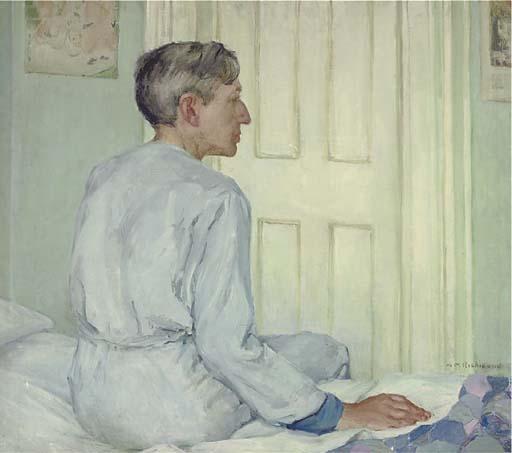
Andrew T. Schwartz was born in Louisville, Kentucky in 1867 and was educated there. In 1890, he studied at the Cincinnati Art Academy under Frank Duveneck. Later, he went to New York, where he attended classes at the Art Students League. While there, he studied for two years with H. Siddons Mowbray and, in 1899, was awarded the Lazarus Scholarship for the Study of Mural Painting, which had been endowed at the Metropolitan Museum of Art, which led to three years of study in Italy, at the American Academy in Rome, and in France, Germany, and England (1899-1902).[252] His work from this trip was the subject of a show at the Pratt Institute in Brooklyn.
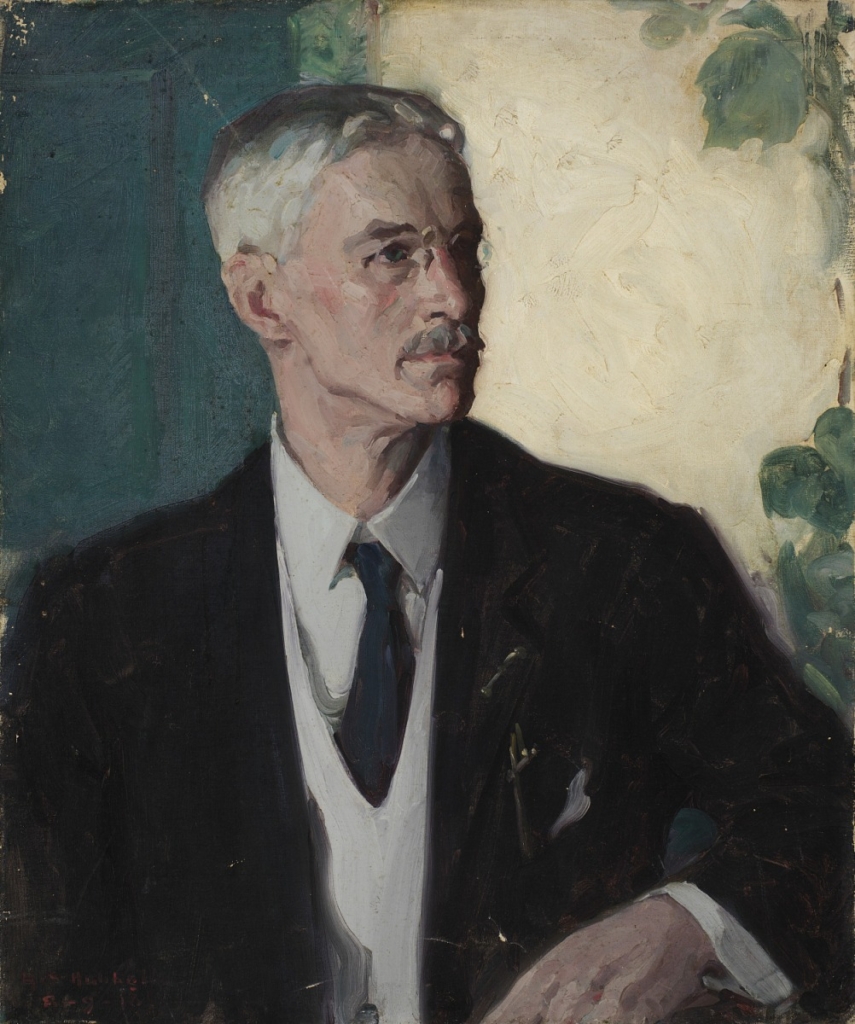
Back in New York, Schwartz assisted Mowbray in decorating the very large and remarkable library of the University Club, designed by Charles McKim of McKim, Mead & White,[253] leading architects of the American Renaissance, as well as the justly renowned library of J.P. Morgan, designed by the same architects and built in 1902-06. The murals produced in these projects are exceptionally impressive, indeed extraordinary,[254] surely among the best of their kind in New York City. At the Morgan, Mowbray and Schwartz, working under the influence of Raphael (e.g., the Stanza della Segnatura in the Vatican) and Pinturicchio,[255] decorated the apse, the ceiling, and the lunettes of the rotunda, a vaulted entrance foyer. In the library of the building, the largest room with walls 30 feet high, they painted the lunettes with portraits of muses and their attributes in the style of Pinturicchio, as well as images of Michelangelo, Botticelli, Dante, Galileo and other leading figures in cultural history. In spandrels they painted the signs of the zodiac and their associated deities.[256]
Later, Schwartz worked on his own and further developed his reputation as a mural painter. That reputation grew as a result of his mural Christ, the Good Shepherd in the Baptist Church in South Londonderry, Vermont, which was executed early in the century and was considered at the time a leading and influential example of mural art. Tragically, the church, which had been built in 1834, burned to the ground in the dead of night in 2010, fortunately claiming no lives but taking the irreplaceable mural with it, a story that reminds us of the fragility of all works of art.[257]
Schwartz also painted murals for the New York YMCA and the Atkins Museum of Fine Art in Kansas City, Missouri, and five murals by him grace the lobby of the Kansas City Life Insurance Building.[258] He painted murals in private homes as well.[259]
Schwartz did not confine himself to mural painting. He painted figures and landscapes, many of the latter being scenes of New England. He participated in many exhibitions, including at the Art Institute of Chicago, the Brooklyn Museum, the Pennsylvania Academy of Fine Arts in Philadelphia, the Syracuse Museum of Fine Arts, the Memorial Art Gallery in Rochester, the Carnegie Institute in Pittsburgh, the National Academy of Design, and elsewhere. He also did work for the Cincinnati Art Museum and the Public Library of Utica, New York.
One commentator writes that Schwartz painted in a regional impressionist style, but that late in his career, he gravitated toward the realism of the American scene movement. [260]
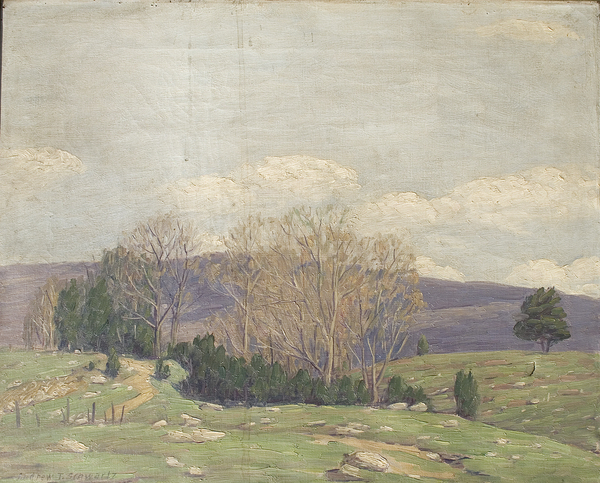
Schwartz was a member of the National Society of Mural Painters, the Salmagundi Club, Allied Artists of America, American Watercolor Society, the Architectural League of New York, the Circolo Artistico of Rome, and the Union International Des Beaux Arts et Des Lettres of Paris. He served on the committee at the Metropolitan Museum that administered the Lazarus Prize.
Schwartz died in 1942 while on a visit to his sister in his hometown. A memorial show of his work was held at the Lotus Club in New York City in 1944.[261]
In 2004, one of his paintings, Under the Bridge from about 1935, was included in a show, Coming Home: American Paintings, 1930-1950, which traveled to six museums around the country.[262] In this work, Schwartz captures the Brooklyn Bridge, but in an unusual way. The painting shows warehouses, trucks, cars, and people working underneath the Brooklyn Bridge, a segment of commercial life in New York City not always noticed by the busy denizens of the city. The great bridge towers over the scene that we see, demonstrating as it does so the power and strength of American progress. But the painting is not about the grandeur or the beauty of the bridge or of New York City. Rather, “the everyday work of New York supports the bridge, as a symbol of American strength, yet remains underappreciated.” [263] This was an important reality for the viewer to keep in mind in 1935, during the Great Depression. As we will see, Schwartz also made the Brooklyn Bridge the subject of one of his murals at the New York County Courthouse.
Robert K. Ryland was born in Grenada, Mississippi in 1873. He studied at Bethel College in Kentucky, the Art Students League, the National Academy of Design in New York, and the American Academy in Rome (1903-05). He lived in Kentucky and in Brooklyn Heights. Ryland worked as a muralist, painter, and illustrator. He exhibited at the Salon des Independents (1917), the National Academy of Design, the Corcoran Gallery, the City Art Museum of St. Louis, the Brooklyn Museum, the Pennsylvania Academy of Fine Art, the 25th Annual International Exhibition of Paintings at the Carnegie Museum in Pittsburgh in 1926, the Art Institute of Chicago, the Brooklyn Society of Artists, and the Syracuse Museum of Fine Arts. He did work as an artist at the New York World’s Fair (1939-40). Ryland painted murals for the lobbies of buildings[264] and at the Washington Irving High School in New York. As an illustrator, he did covers for Good Housekeeping, McCall’s, and other publications.[265] He taught at the Women’s Art School of Cooper Union.[266]
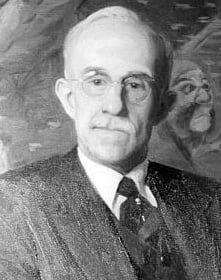
Ryland was a Resident Artist Member of the Salmagundi Club from 1912-1951, an Associate National Academician of the National Academy of Design, and a member of the National Society of Mural Painters and the Artists Guild of the Authors League of America. Among his awards were, in 1902, the Lazarus Scholarship for the Study of Mural Painting (the same award won by Schwartz),[267] the Altman Prize of the National Academy of Design,[268] and an Honorable Mention from the Art Institute of Chicago in 1928.[269]
Recently, in 2013-2014, one of his paintings was included in the show Industrial Sublime: Modernism and the Transformation of New York’s Rivers, 1900-1940 at the Hudson River Museum.[270] The painting, The Bridge Pier, is an interesting one. Here, a man sits on the Brooklyn shore looking across the East River towards Manhattan. A boat steams by, belching smoke. Behind it loom, perhaps menacingly, a pier of the Brooklyn Bridge and, in the rear, the hulking outlines of the Municipal Building. The scene is one very familiar to all New Yorkers, but Ryland, through his use of dark colors, indistinct lines and heavy impasto, imbues it with a melancholy atmosphere. The painting was created in 1931, in the heart of the Great Depression, and it seems to convey what must have been, or often felt like, the essence of that time. “Who is this man, so dwarfed by these surroundings,” writes one scholar, “that we, like he does, sense both the magnificence and the oppressiveness of the modern urban landscape?”[271] Here we see ”the concrete results of the nation’s labor, a metropolis rising from the landscape – grand but somehow sobering.” And it is even more sobering when we consider the harsh economic reality of the time, not explicitly depicted, but yet present in the atmosphere conveyed in this work. “The infinite possibilities of development,“ Ryland seems to ask, “have been hewed into reality over the course of a century, but at what cost ?”[272]
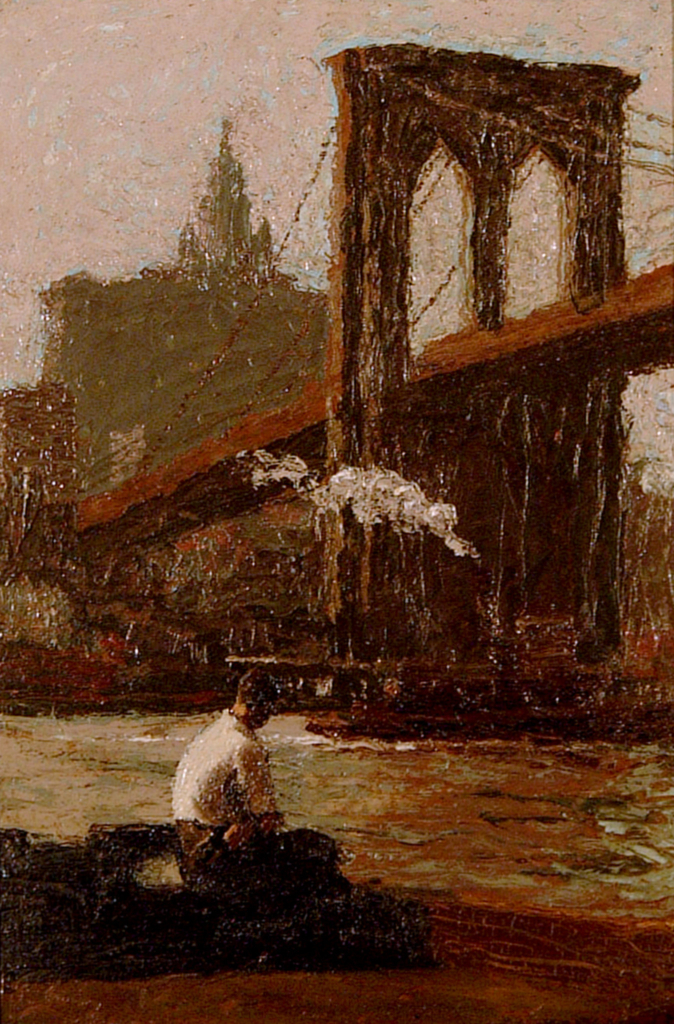
The painting is interesting also because of the free and highly impressionistic style in which it is painted, so very markedly different from the style Ryland was to use, only a few years later and only a block or so from the Municipal Building, in his murals for the New York County Courthouse. The impressionistic style is also evident in a portrait of his from 1941 (Lady in Fur Coat) that is in the collection of the Salmagundi Club and that was part of an exhibition, Haunting Portraits, at the club in 2022.[273]
Ryland died in 1951.[274]
The last of the associate muralists was John Edwin Jackson. Like Ryland and Schwartz, he was a son of the south. He was born in Nashville, Tennessee in 1875. He came to New York to pursue his career, studying at the National Academy of Design and the Art Students League. By 1914, he had achieved sufficient prominence as to be connected professionally to New York and to have his photograph included in a compendium of notable New Yorkers.[275]
Jackson worked as a painter, a muralist, a lithographer, and an illustrator. In this last capacity, he illustrated covers for Scribner’s, Harper’s and the like.[276] In 1930 and 1931 alone, he did color illustrations for the cover of at least seven monthly issues of Needlecraft: The Magazine of Home Arts.[277] Jackson illustrated many books for publishers such as The Century Company and Doubleday.[278] He created an illustration of a scene of family life that was used as the subject of a wooden jigsaw puzzle made and sold in America in 1905 by the Grignard Morgan Company.[279] He also painted New York street scenes. In addition to his mural work at the County Courthouse, he did such work at the New York Public Library, the New York State College for Teachers in Albany, New York,[280] and the National City Bank, New York. His work was shown at the Nashville Art Club, where he won a prize in 1920.[281] Jackson died in 1950.
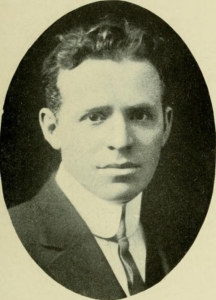
An exhibition of the work of living artists was presented by the Brooklyn Museum from November 1930 to January 1931. Among those whose works were on view in this show were three of the associated artists, Turney, Schwartz, and Ryland, as well as Agnes Richmond Turney.[282] In 1943, the Museum presented an annual exhibition of the Brooklyn Society of Artists, at which paintings of Turney and Ryland were on view, as well as work by Agnes Richmond Turney.[283]
B. The Murals on the Upper Floors
The Ceremonial Courtroom
In January 1937, with only a few months of work left on the rotunda ceiling, Borough President Levy submitted to the Art Commission multiple applications seeking preliminary approval for additional murals to be created at the courthouse. One such application was for murals in Room 300, the Ceremonial Courtroom. Mr. Pusterla was designated as the painter for these murals, as indeed was the case, as noted earlier, with all of the applications presented for murals at the courthouse, a reflection of his supervisory role at the courthouse; none of the four other muralists who created the murals on the upper floors was so identified. Supporting this application was a decorated model in full color. The Commission again acted quickly, granting preliminary approval six days after it received the application. [284] As before, the Commission required that the painter consult with the Painter Member of the Commission, Mr. Peixotto, as the designs progressed, that large-scale or full-size drawings were to be submitted for approval by the Commission before the final work began, and that final approval be obtained before the installation of the works. [285]

The murals in the Ceremonial Courtroom (Room 300) are located on the wall behind the judge’s bench and on the opposite, rear wall. There is a great deal of blank wall space on the side walls. Most of that space was covered at some point with acoustic tiles that were painted over, thereby undermining their acoustical properties, although they are still present.
There are three principal representational murals in Room 300, along with three related paintings. The three main murals in the room consist of a very large painting behind the judge’s bench and, on the rear wall, two smaller, but still substantial murals that are painted on each side of a painted trompe l’oeil clock with mechanical parts. All three of the main murals are oils on canvas that have been attached to the walls. The largest one is approximately 21 feet wide and 11 feet high. The other two are approximately 10 feet wide and 11 feet high. These paintings show scenes of colonial history in New York State that have importance for the administration of justice. They were the work of Andrew T. Schwartz, assisted in two instances, those adjacent to the clock, by two others, Nino Polimeni and Jules Ruppert, and, in the case of the largest of the three murals, by Winthrop Turney.[286] All of the murals are signed by the painter in the lower right-hand corner.
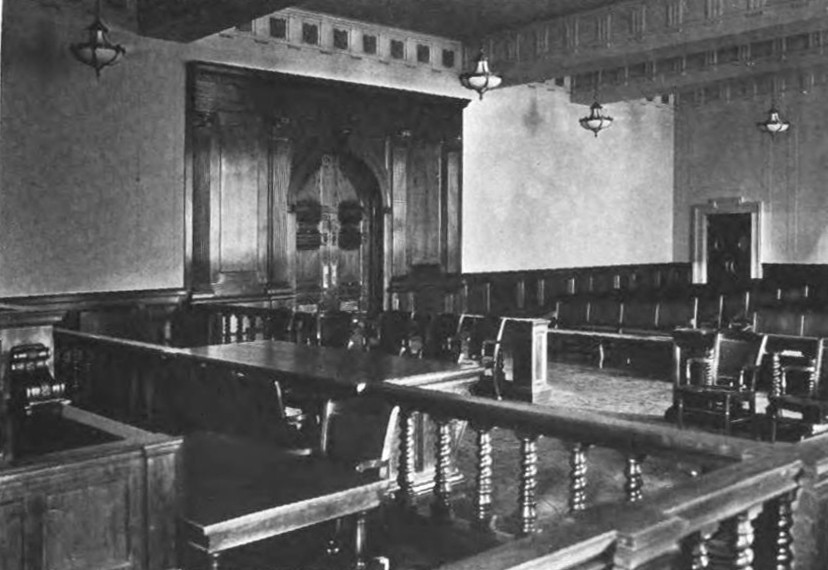
The largest mural takes up much of the wall behind the bench, but not all of it. On the left of the painting is a painted box. There are also four narrow decorative canvas panels in brown on this wall. These depict fish and other animals, urns, floral arrangements, garlands, lions’ heads, and other elements. These panels also appear on all of the other walls in the room, for a total of 18 such panels. To the right of the main painting, over an entrance door for the judge and staff, is one of the subsidiary murals, which is of a seal in a painted box.
The rear wall, opposite to the main painting, is the wall with the clock and two murals on either side of it. There are the brown decorative panels on this wall and to the far right as one faces this wall is a window. At the other end of this wall, there is another staff door and over it another box containing a subsidiary mural of a painted seal. This entire wall, then, comprises the seal, the decorative panels, the clock, the window, and the two murals, which are the dominant features on the wall.

The two seals are significant as they present part of the theme of the entire courtroom, which is the story of justice in New York State in its early history. I will explain these seals shortly.
The clock on the rear wall of the room consists of brass elements for the hours and minutes and brass arms (one is currently missing) within a large painted design that constitutes the third of the three subsidiary murals in the courtroom. It appears that the painted design surrounding the clock is a fresco. Further, it appears that the other two subsidiary murals, those of the two seals, are frescoes as well. All three may have been the work of Attilio Pusterla.
The courtroom is richly decorated with wood. There is an elaborate wooden entrance door and wooden wainscoting throughout.
The proposal for the work in Room 300 that was approved by the Commission contemplated that the side walls would be adorned with ornamental panels showing symbols of law. This aspect of the original plan was apparently abandoned. The narrow decorative panels in brown are on both side walls. Decorative stencils were also to be painted on the ceiling, which never came to pass (or else the decorations were painted over at some point). Renderings of the panels were submitted as part of the application to the Art Commission.[287] Attilio Pusterla’s name appears on the rear of one of these designated as the mural painter so it is possible that it was intended that he paint these elements of the program for Room 300.
The three principal murals were painted by Mr. Schwartz on canvas using warm tones of cream, red, and green. The colors are notably more muted than those on the first floor, although all of these paintings are probably in need of a cleaning, which apparently has not occurred since 1937. These murals are realistic in style and devoid of allegory.
Understanding the murals and the seals requires a brief foray into the early history of the colony that eventually became New York State. New Netherland was the name given by the Dutch to its colony, the first Dutch colony in North America. It covered an immense territory between the English centers of New England and Virginia, extending from Cape Cod to Albany, New York to Delaware, land that today is part of the states of New York, New Jersey, Pennsylvania, Maryland, Connecticut, and Delaware. The claim of the Dutch to this territory derived from the travels of Henry Hudson. In 1609, seeking a passage to India, he sailed from Delaware in the Half Moon up the river that is named after him. Various exploratory and trading activities occurred in the years that followed. In 1624, the territory of New Netherland became a province of the Dutch Republic. That same year, a ship, the New Netherland, chartered by the Dutch West India Company and carrying Flemish and Walloon families, arrived in the harbor of Manhattan and soon established settlements at Fort Orange (Albany) and on today’s Governor’s Island and later lower Manhattan. Famously, the land of Manhattan was purchased in 1626 by Peter Minuit, one of the Walloon immigrants, then Director of New Netherland, from a group of Native Americans. Fort Amsterdam was established at the tip of Manhattan. Thus was founded the principal settlement of the territory of New Netherland, which was called New Amsterdam, which became the first chartered city in the 13 colonies. New Amsterdam, which was the center of the fur trade, eventually became the City of New York. The province within which New Amsterdam was situated was variously called at the time Manhattoes or Mannados or the like, from an Indian name.[288]
One of the murals adjacent to the clock in Room 300 depicts a meeting of the first law court of New Netherland in the City Hall of New Amsterdam. (The mural bears the title “Meeting of the first popular Law court of New Netherland in the City Hall of New Amsterdam.”). This is, in other words, an image of one of the earliest instances of the administration of justice through courts of law in the history of New York. It is a scene that illustrates our tradition of law in operation in its early years, a depiction of our ideals in action in history, and thus of foundational importance to law and justice in New York.
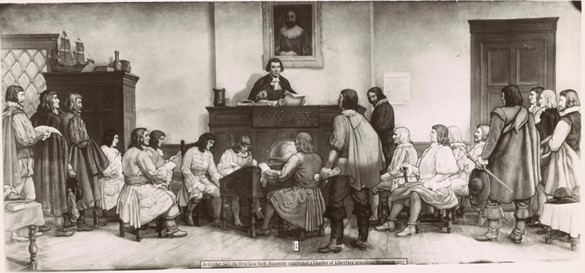
The other mural adjacent to the clock shows a milestone that had a profound and enduring impact upon the later history of New York State and the entire United States: the transfer of the territory of New Netherland from the Dutch to the English in 1664. (The painting bears the title “In 1664 the province of New Netherland passed from the Dutch to the English.”). Had the Dutch been able to retain and expand New Netherland, the entire history of the United States might have been different, but the territory was not always well-governed by its Directors. One, for instance, blundered into a war with local Indians in 1644, which did not help the colony in its economic and social development. Had the Dutch government been more successful, it might have been the case, for example, that the legal foundation of the country would have been built on Dutch law, not upon English common law and the recognized rights and freedoms of Englishmen, which have been so important to the kind of society early America aspired to be and eventually became. The Dutch, however, it must be said, were known for a tradition of tolerance, including in matters of religion, rights of citizenship and civil liberties, and the colony of New Netherland was a multicultural place. The Dutch also exhibited notable energy in commercial affairs and orderly commercial and social life. The influence of all these things during the decades of Dutch control contributed positively to the political and social culture and the economic life of the colony that would become New York. The Dutch interest in commercial activity was passed on to subsequent inhabitants and is a characteristic of New Yorkers, as well as Americans generally. Reminders of Dutch domination of New Netherland and New Amsterdam and Dutch political, social, and cultural influences are all around us today in many place names that came from the Dutch (the Bowery, for instance, derives from a Dutch word, bouweries, for farms and Harlem (Haarlem), Brooklyn (Breuckelen) and Long Island (Lange Eylandt) were originally named by the Dutch) and in the names of successful Dutch families that are well-known to us, such as the Van Burens, the Van Rensselaers, and the Roosevelts, two of whom gave us three Presidents of the United States. Even the pattern of the streets in lower Manhattan remains largely intact from that of New Amsterdam.
English governments had protested against the existence of New Netherland as an intrusion in English America. There were tensions between the Dutch and the English in the Old World as well. Between 1652 and 1674, the Dutch and the English fought three wars. The surrender of New Netherland took place because of these conflicts. In 1664, the last Dutch Director General of New Netherland (1647-64), Peter Stuyvesant, a name well known to New Yorkers (though not because of the actions taken by him), surrendered the colony to the English without any armed clashes after a small English fleet had appeared in the harbor of New Amsterdam, although conflict between the two countries continued for some years thereafter. The population of New Amsterdam was about 1,500 at that time. Articles of Capitulation set out the terms of the transfer and, significantly for the rights of the people of the future, were generous and broad-minded, protecting the property rights of the inhabitants and providing for civil rights and freedom of worship in the colony. In this mural, we see Stuyvesant handing the Articles to a representative of the English. We recognize Stuyvesant from his wooden leg as he is known to have lost his leg in battle before he arrived in New Netherland.[289] He is also identified in the application to the Art Commission.
The last and the largest of the murals in the courtroom, that located behind the judge’s bench, presents a subject described in the application to the Art Commission. It depicts a meeting of the first General Assembly of New York in October 1683, convened by the Governor, Thomas Dongan, which approved a Charter of Liberties and Privileges for the colony. (The title of the mural is “In October 1683 the first New York Assembly established a Charter of Liberties providing for trial by jury.”). The Charter, a kind of Magna Carta for New York (though one actuated by the will of the Governor rather than by constraint upon him), was a great watershed in the constitutional history of New York State and an influential document in the history of the United States. It established a right of suffrage and a system of government for New York in which popular representatives participated as members of the Assembly. Taking inspiration from the Magna Carta, it provided protection for the rights and freedoms of the people, including due process, taxation only upon the approval of the assembly, and trial by jury. A facsimile of the Charter and a transcript and summary of the provisions of this influential enactment have been made publicly available by the Historical Society of the New York Courts.[290]
The seal on the rear wall reads in Latin “Sigillum Amstello Damensis in Nova Belgio,” which means “Seal of Amsterdam in New Netherland.” This seal was based upon the design for the seal of Old Amsterdam in the Netherlands. The seal also includes a beaver and, at the top, the initials of the West India Company. This seal dates from 1654, when it was presented to Director General Stuyvesant. [291] The territory was also referred to as “New Belgium.” Belgium was then a part of the Netherlands and the use of the name recalled the role of Belgians in the first forays into this part of America.
The seal on the main wall bears the date of 1686, 24 years after New Netherland became an English colony, which was the year in which this seal was first used. It depicts a sailor and a Native American of Manhattan, the sails of a windmill, flower casks, and beavers. The human figures serve to indicate the existence of good relations between the settlers and the Native Americans. The citation of the casks and the animals reflects the fact that trade in flour and furs was the major economic activity in the earliest years of the colonial period in what would become New York State. The seal reads in Latin “Sigillum Civitatis Novi Eboraci,” which means “Seal of the City of New York,” the successor of New Amsterdam.[292]
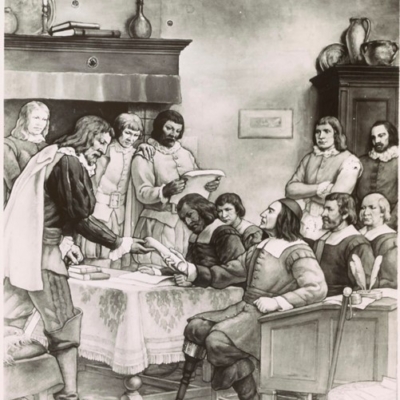
The Jury Assembly Room
Numerous murals, 20 in all, all of them oils on canvas affixed to the walls, are to be found in the Norman Goodman Jury Assembly Room (Room 452) on the fourth floor. More precisely, jurors wait to be called in two rooms that are connected to each other, Room 452 and Room 448, and murals were created for both rooms.
In January 1937, at the same time that approval was sought for the mural work in Room 300, Borough President Levy submitted an application for preliminary approval of murals to be created for Room 448, again with Mr. Pusterla identified as the painter for the project. A decorated model was noted as the basis for the designs and renderings were submitted in support. The Commission promptly granted preliminary approval. [293]
On the same day as applications were submitted to the Art Commission for preliminary approval of the murals for Rooms 300 and 448, an application in the same format was presented by Borough President Levy for such approval for murals to be installed in Room 452. Again, a decorated model was submitted in support of the application.[294] This time the Commission did not act rapidly and its decision was different. The application was disapproved, without prejudice to resubmission. [295] The resolution of the Commission did not specify the defects found in the submission. The proposed mural program for Room 452 was to consist of a series of panels on the theme of present-day New York. This theme did not trouble the Commission since the murals that later were installed carried out precisely this theme. The application identified the subjects of seven proposed panels. Some of these were the subjects executed in the final murals, but some others were not, so that one must conclude that the Commission found fault with the designs for or subjects of these latter panels, which were paintings of the elevated train, the view from South Ferry looking north, and City Hall Plaza. [296]
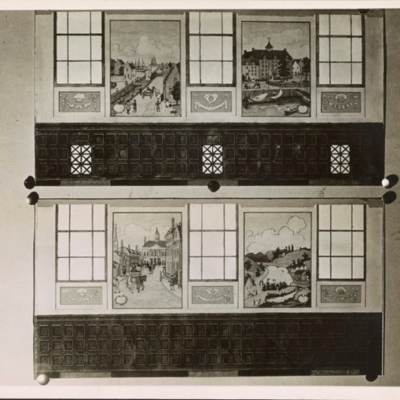
The works on the walls of Room 452, one scholar writes, are “a gorgeous collection of paintings celebrating New York in the 1930s.”[298] All of the paintings in this room, of which there are nine, show what New York was like during the Depression.
The principal mural is a large panorama of downtown New York and the harbor by Attilio Pusterla, who signed his name in the lower right. The skyline of a crowded and busy lower Manhattan is set against a blue sky filled with beautiful billowing clouds, with the Staten Island ferry, ships at work, cruise ships underway, the Statue of Liberty, and, in the foreground, a tugboat. These characteristic images are very skillfully painted, as are those of birds in flight in the foreground, which seem almost to be real. The individual images that make up this painting exude great energy. The colors are bright. This harbor scene, which depicts the importance of the waterways of New York to the city’s life and its character, reflects the vibrancy of the city and the rapid pace of daily life. It is “[o]ne of the most charming visions of New York of that time to be seen anywhere.”[299] It was for this reason that Mayor David Dinkins used this image on his Christmas card in 1991.[300]

On the opposite wall is another charming scene, this one painted by John Edwin Jackson, of midtown Manhattan seen from the shoreline in Brooklyn. The colors are bright and cheerful. There is a lovely blue sky replete with clouds. We see the Chrysler Building and the Empire State Building and other edifices of that crowded part of the city. Smoke billows from smokestacks and there are boats by the Brooklyn shoreline and moving along in the East River. We see a city that seems at once busy and calm. All of this is under the eye of a worker who sits peacefully on a low wall on the Brooklyn side resting for a moment and gazing across the river.

On that same wall is a cheerful painting of the Hudson and Riverside Drive entitled “General Grant’s Tomb and Riverside Drive.” [301] This painting was created by Winthrop D. Turney in 1938. We can see the tomb of the President and Riverside Church. This part of the city too is very active. We see cars and a motorcycle rushing by on the highway, vessels on the river, the crowded George Washington Bridge, which opened in 1931, and, in the upper left, a group of airplanes in flight, the presence of which, as it is 1938, must be benign.
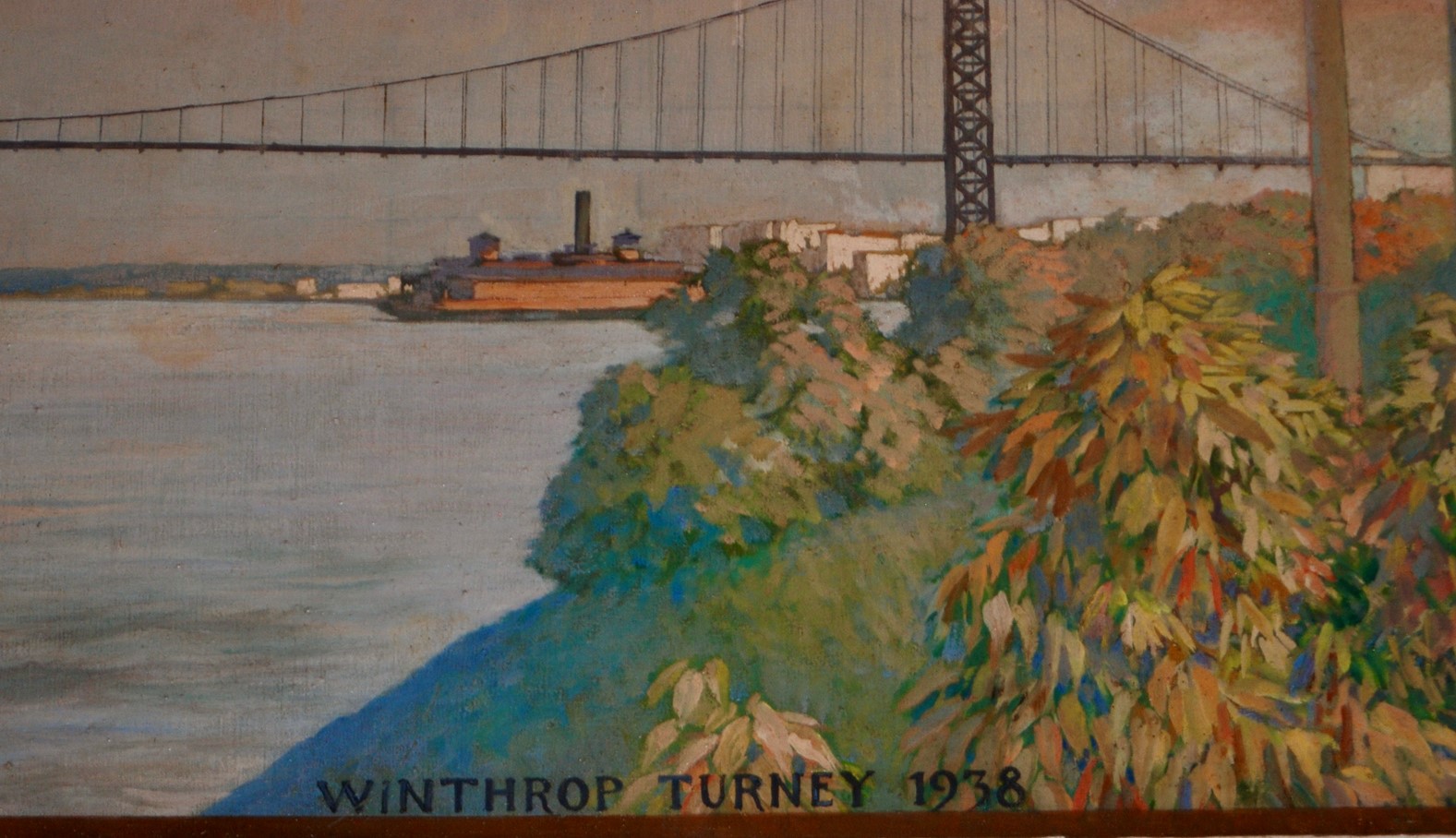
In the same room are six sepia-toned paintings of New York by Andrew T. Schwartz. These images, exhibiting a “dark and shadowy delicacy,”[302] show a city that has in recent times been transformed by growth and rapid modernization. They are of Wall Street (more precisely, Federal Hall, Wall Street, and Trinity Church) (40 Wall Street was erected in 1929-1930 as the headquarters of the Manhattan Company and for a time competed with the Chrysler Building for the title of the world’s tallest building); Low Library of Columbia University, which moved from midtown to Morningside Heights in 1897 and the symbol of which, the library, was designed by Charles McKim of McKim, Mead and White and built between 1895 and 1897; the New York Public Library Building on Fifth Avenue, which had opened not all that long before, in 1911, and New Yorkers out for a stroll or on their way to work; the Woolworth Building, 233 Broadway, designed by Cass Gilbert, which had opened only a little over 20 years earlier, in 1913, and was the tallest building in the world from 1913-1929 (and remains one of the 100 tallest in the United States today), as seen from the Municipal Building, with City Hall in the foreground; the statue of Atlas at Rockefeller Center, the first building of which was completed in 1932; and the Brooklyn Bridge from its Manhattan end. The Chrysler Building and the Empire State Building were also recent additions, 1930 and 1931, respectively, to what today we call the skyline of New York. Each of these six paintings bears a painted plaque that describes the subject matter of the work. These paintings of the evolving metropolis “provide the perfect counterpoint and a subtle complement to the storybook colors of the three larger panels.”[303]
The wall nearest the center of the room contains the large Jackson and Turney murals and a clock, and these take up all of the wall space. The clock consists of brass elements, but there is no painted design surrounding it. It is possible that there once was a painted face for this clock, perhaps a fresco, but, if so, it has been painted over. The opposite, rear wall is covered by the Pusterla painting, the largest in the room, flanked by two of the Schwartz paintings. On each side wall, between windows, are two Schwartz paintings, which are wider than those on the rear wall.
Four of these murals were signed by the artists who executed them: Jackson, Turney, Pusterla, and, on one of his six works, Schwartz. All of the paintings were created in 1937, the year in which the Art Commission gave preliminary approval for their creation, save for that by Turney.
The murals in Room 452 strongly reflect the power and success of New York City and the United States over the then-recent past. At the same time, these paintings were created during a dark and grim present. Their illustration of that power and success presents a poignant irony at a historical moment when serious hardship was widespread and fear and uncertainty about the future were, quite reasonably, rampant, the stuff of daily life. At that moment, no one could deny that things were very bad indeed, and no one could be sure how they would turn out, whether or not New York City and its people would be able at some point to resume their upward march and, if so, when that might be.
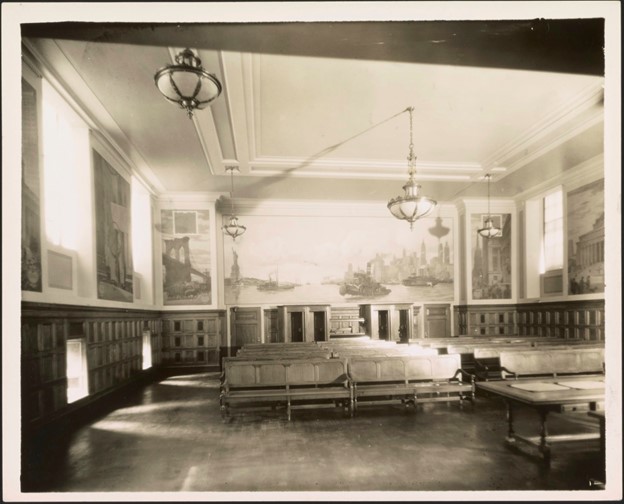
Nevertheless, it is very striking how positive and even optimistic the paintings in this room are. The painters appear to have striven to set aside all fear, to present the deep essence of the city and to avoid shadings that might give rise in the mind of the viewer to doubt about the ultimate triumph of the city and its people. At their heart, these paintings seem to reassure any viewer who might worry that even greater power and success lay ahead for the people of New York City, once the current trouble was past.
In Room 448 are a group of murals, eleven in number, about 10 or 12 feet high, by Robert K. Ryland. Whereas the murals in Room 452 are all contemporary scenes, of images and life in New York City in the 1930’s, these paintings are adaptations of well-known views of Manhattan in the early years of the city’s history to the colonial period and, in one instance, in the late nineteenth century. Specifically, they cover the period from around 1600 to 1873.[304] There are scenes of life of local Native Americans and of daily life in colonial and later New York. These paintings give the viewer a sense of what New York City looked like in those years and remind us of the great length and richness of the city’s history.
The application to the Art Commission specified the subject matter of each of the eleven murals. In large part, the paintings were executed as proposed, with modest changes. [305]
On the wall closest to the center of the assembly room are two large paintings, which flank a clock. As elsewhere in the building, the clock is composed of brass elements and a painted design. This design may be a fresco, perhaps done by Mr. Pusterla. The paintings and the clock cover the whole of this wall. On the opposite, rear wall, there is a large painting of the Duke of York map, the largest of the paintings in this room, which is flanked by two smaller murals on each side. All of these paintings cover the entirety of the wall. There are two murals on each of the side walls, which, together with windows, cover the whole of those walls. Below the windows are decorative panels in brown on canvas. According to the original proposal, decorative stencils were to be painted on the ceiling, but either this never happened, or these designs were painted over at some point.
The eleven murals are oils on canvas from 1937-1938.[306] Five were painted in 1937, five were painted in 1938, and one is undated. They are signed or initialed by the painter. A painted label appears on each work identifying its subject matter and often noting that the work is based upon a print or map. The paintings depict the following subjects:
- Henry Hudson’s ship, the Half Moon, approaching Manhattan Island in 1609.
- An early Indian settlement.
- What is identified as the “Earliest View of New York, 1626-28.” The painting indicates that it is based on “the Hartgers View,” a depiction of New Amsterdam in 1626-28 that was included as an engraving in a Dutch book published in 1651 by Joost Hartgers.
- “New Amsterdam 1651,” after a print.
- Broad Street in New Amsterdam, around 1660. Originally, the street was called Broad Canal because a canal ran down the center with paths and houses on each side. The water came from the East River. The canal was called the “Gracht” in Dutch. That word means a canal within a city, a reality with which the citizens of old Amsterdam were very familiar. The canal was filled in in 1676, when the city was controlled by the British.
- The Duke of York Map showing New Amsterdam as it existed just before it became New York after the English assumed control. This is the largest of the murals in Room 448. The subject is identified as “The Town of Mannados or New Amsterdam, 1664,” based upon “the Duke’s Plan.” The plan is the name given to a map that was apparently presented to the Duke of York, the proprietor of the colony from whose name the name of the city derived. This painting contains also impressive portraits of a Dutch soldier and an Indian, as well as the seal of New Amsterdam.
- The first city hall of New York City, 1679-80. The building served as the Stadt Huys (city hall) in New Amsterdam under the Dutch and later under the English, until a new city hall was built at a different location at the beginning of the eighteenth century. This painting is from a drawing or print known as the “Labadist View.”
- “Fort George and the City of New York, 1731-36.” Fort George was a fort that occupied the site of the former Fort Amsterdam of New Amsterdam. It was controlled by the English until after the end of the American Revolution, when it was surrendered to the Americans. The fort was located on the site now occupied by the Alexander Hamilton Custom House. This painting, one of the largest in Room 448, is based upon the “Carwitham View,” an engraving of the fort and the city seen from the southwest that was issued in about 1736.
- Broad Street and Federal Hall, 1797.
- Collect Pond, 1798. The pond was located at today’s Leonard Street between Lafayette and Centre Street, very near to the site of the New York County Courthouse. It provided water for the city in the colonial period. Early in the nineteenth century, the pond was filled in because it had been befouled by various commercial activities. Because the ground in the area remains aqueous, there are to this day large water pumps in the basement of the County Courthouse. The name of the pond was a corruption of the Dutch word “kolch,” for “small body of water.”
- “New York from the East Pier of the Brooklyn Bridge,” about 1873.
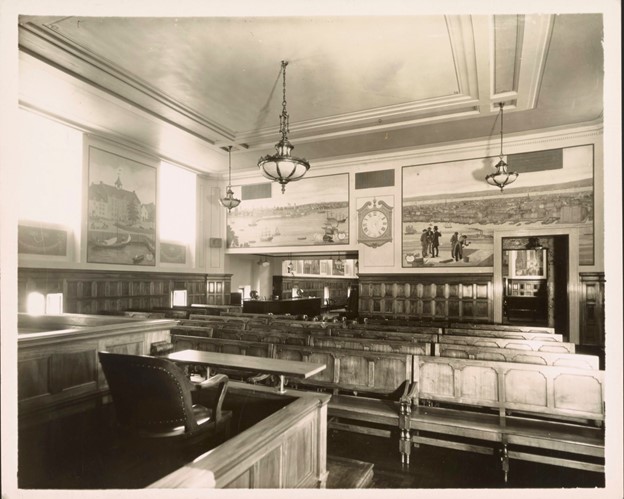
These murals are all painted in a restrained, realistic style that differs markedly from that Ryland used in some of his paintings elsewhere, as I mentioned earlier. Again, the artist’s conservative approach to the task of decorating the space was no doubt driven in part by the fact that the paintings were based upon well-known views of the city. He could have created paintings inspired by the views, but interpreted in a modern key, but he preferred to be more literal. Yet he was undoubtedly influenced also by a desire to create compositions for the walls of this room that would fit in harmoniously with the design of the courthouse and the rest of the art in the building.
The Seventh Floor Conference Room
Finally, there are murals on the walls of the conference room on the Seventh Floor. Despite the name informally used for it, the Seventh Floor is actually a kind of aerie rather than a full floor. Guy Lowell designed a substantial-sized room in this space as a dining room for the Justices, with a fireplace at one end. At the opposite end, he created a lounge for the Justices. The space on this floor continued to serve these roles for decades, until after World War II. At a certain point, the dining room was converted into space for the administration of the court and the lounge was converted into a conference room, which it remains today. [307]
For many years, the wall of the lounge facing north was covered by plasterboard. Perhaps ten years ago, this wall was taken down, revealing a beautiful set of four original oak columns with ionic capitals.
On May 10, 1937, an application in the usual form was submitted by the Borough President seeking preliminary approval for the installation of murals in the lounge. The design scheme was to be a decorative one as shown in a model[308] and a rendering.[309] The next day, the Commission disapproved the application, without giving a rationale or stating that the decision was without prejudice.[310]
Some months later, another application was submitted. The proposal this time was to create murals that would mimic Gobelin tapestries using heavy, specially-prepared canvas that would be hung from the walls like tapestries rather than permanently affixed to them.[311] The murals were to present classical, allegorical personifications of music, art, literature, science, education, and poetry in six separate panels.[312] The Commission gave preliminary approval to the application.[313]
The murals in the lounge were painted by Attilio Pusterla, who did not sign them. As intended, they are oils on canvas. The canvases were not affixed to the walls by glue, but rather were secured by nails on the borders. This leaves some flexibility to the canvases, presumably to further the goal of having the murals resemble tapestries.
The murals were indeed painted to look like tapestries. The illusion was achieved through the subject matter of the murals, the style used in the paintings, and the colors employed. The viewer of the room at first glance at least thinks that the walls are covered by tapestries.
As intended, there are six separate murals in the lounge. They are about 10-12 feet high, running from the top of wooden wainscoting to the ceiling. Pusterla, however, departed from the original plan for the space by creating four rather than six allegorical paintings, replacing two with decorative subjects, and by retaining two of the original allegorical subjects and replacing the other four. The two decorative paintings are located on the wall on the north side of the room, flanking the oak columns. These two paintings are the smallest in the room. The paintings on the opposite wall, which is the main wall of the room just inside a door leading from the administrative office and former dining room, are the largest of the group. They cover almost all of the wall. There are two other murals on the two side walls. The mural on the main wall to the left of the door is a depiction of “Literature.” The mural on the main wall to the right of the door is a representation of “Music.” The paintings on the side walls depict “Painting” and “Sculpture.”
Pusterla used various tones of brown, tan, green, blue, and acquamarine in these murals, such as one sees in many an antique tapestry. The main subjects are surrounded by decorative borders consisting of fruits and vines in multiple colors. There are also portraits of grotesque heads.
Over the entrance door on the main wall is a clock. The clock has brass elements for the hours and minutes and the hands. There is a decorative shield around the clock that today exists in outline only, but that might once have consisted of a design. This design might have been a fresco.
At the top center of each of the four allegorical paintings is a painted medallion containing the letters “WPA.” These recall similar markings over two paintings in the vestibule on the first floor.
As the Seventh Floor and the conference room are active areas of courthouse operations, these murals are not open to public view. Many meetings, however, have been held over the years in this room at which attorneys and others not on the staff of the court have been present so these murals are not unknown outside the courthouse.
III. The Missing Murals
I come now to the mystery of the missing murals. Some of the murals that were planned for the County Courthouse were never created. Why that was the case is not known. It is possible that the leaders of the Federal Art Project or perhaps the bureaucrats at WPA headquarters created difficulties, possibly influenced by budgetary considerations. In view of the nature and styles of the murals that were executed in the courthouse and the subject matter and planned designs of the murals that were proposed in these cases, it is inconceivable that WPA leaders could have detected subversive thinking or artistic radicalism in the subjects and styles of the proposed murals. It is possible, though, that the Painter Member of the Art Commission, the Commission itself, or the artistic leadership of the mural division of the Federal Art Project created obstacles that, in the end, proved to be insurmountable. This seems unlikely, though, since, as was noted earlier, the Commission, Mr. Peixotto, and the mural division at the Federal Art Project were all generally supportive and reasonable in the application of their requirements.
In January 1937, simultaneously with applications submitted for work in Rooms 300 and 448, Borough President Levy presented to the Art Commission an application for preliminary approval for murals to be installed in Room 408, the Appellate Term courtroom, then as now. Courtroom 408, the only appellate courtroom in the courthouse, had a unique judge’s bench, one that accommodated three judges. The appellate role of this courtroom made it a natural choice for mural decoration. A decorated model was submitted in support of the application. The Commission quickly approved the application, on the same day as it approved those for murals in Rooms 300 and 448.[314]
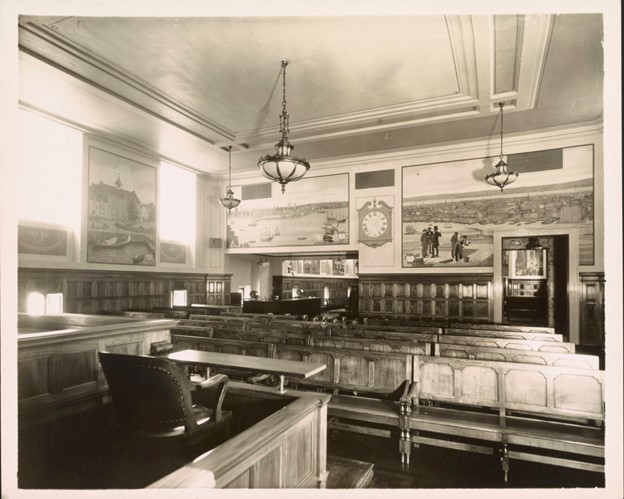
The artistic program that was intended for Courtroom 408 consisted of several murals. The main one was to be a mural over the judges’ bench depicting the reading in 1790 of the letters appointing New Yorker John Jay the first Chief Justice of the United States. The scene unfolded in the Royal Exchange Building on Broad Street, which had been built around 1675, where the Supreme Court sat in 1790. A mural on the rear wall would have represented the tribal law of the Manhattan Indians in operation about 1600. This painting would have shown the chiefs and elders of the tribe as they settled via mediation a dispute between hunters over the killing of a deer. Symbols of the law and decorative elements were to be painted on the side walls and decorative stencils on the ceiling. [315] Renderings for these designs were submitted and photos of them, taken by the Photographic Division of the Federal Art Project, are in the files of the Art Commission. [316] Because Mr. Pusterla signed the renderings, I believe that he created them and intended to paint the murals in this room. No murals, however, were ever created in Room 408.
Together with the other applications submitted on January 6, 1937, an application was submitted by the Borough President seeking preliminary approval for murals intended to be created in Courtroom 148 off the rotunda on the first floor, then the location of Special Term, Part II.[317] The application described two alternate designs for these murals. In the first, murals were to be painted behind the judge’s bench, on the rear wall, and on the side wall over the entrance. All three murals were to be allegorical, with decorative stencils on the ceiling. The alternate proposed designs consisted of an allegorical depiction of “Justice” for one wall and images of early American conceptions of justice (the whipping post and a witch trial) for another. The application recited that it was accompanied by a decorated model, but handwritten notations thereon suggest that that may not have been the case. The intention may have been to submit the model thereafter, but that may not have occurred because the Commission disapproved the application on Feb. 9, 1937 without prejudice to a resubmission.[318] A handwritten notation reveals that a new application was to follow.
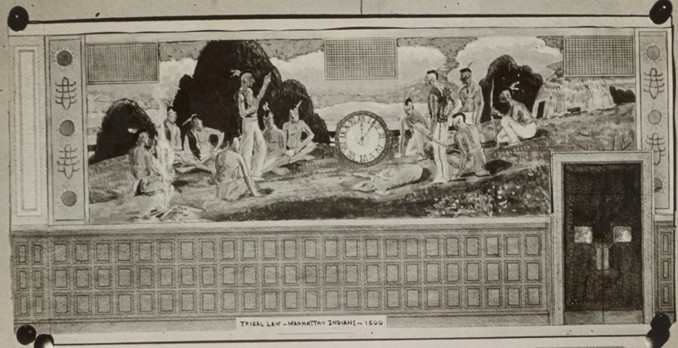
No indication in the records of the Commission exists as to why this application was disapproved. I suspect that the proposed designs of allegories may have been considered too elusive or insufficiently evocative, or, in the case of the examples cited of early American legal history, the subjects may have been deemed excessively dark for the setting, a whipping post and a witch trial hardly being likely subjects for inspiring images of justice at work. Despite the evident plan for a resubmission, there is no indication in the Commission’s files that any new application for approval of murals in Courtroom 148 was ever filed. Why no further action was taken is unknown.
Similarly, an application was submitted on Jan. 6, 1937 of the same sort and form seeking approval for murals to be painted in Courtroom 130, then the location of Special Term, Part III.[319] The application cites to a decorated model and describes the proposed murals. There were to be murals on the main wall behind the judge’s bench and on the rear wall. These murals were to be heavily allegorical. For the main mural, there was intended to be a representation of the coming of justice, with the poor ranged on one side and the rich on the other. There were to be ornamental panels on the side walls and stencils on the ceiling.
Again, the Commission, on Feb. 9, 1937, disapproved this application without prejudice. No reason was given for this decision.[320] Again, I suspect, however, that the Commission was dissatisfied with the allegorical character of the designs.
A new application in the customary form, dated July 6, 1937, was submitted to the Commission seeking approval of revised designs for Courtroom 130. The designs and sketches were the work of Mr. Pusterla.[321] An allegorical approach was abandoned. Instead, the application proposed that there be a mural behind the judge’s bench that would depict the landing of the first Dutch colonists in what was to be New Amsterdam in 1624. There would also be murals on the rear wall on each side of a clock. A mural on one side of the wall would show Peter Stuyvesant building a protective timber wall between Broadway and the East River in 1647; a path along this wall in time developed into Wall Street. On the other side, a painting would show Peter Minuit’s purchase of Manhattan from the Indians in 1626. In addition, there were to be decorations on the other walls and “three-tone effects” on the ceiling.[322]
The Commission again disapproved the proposals. For once it gave a reason: “the character of the designs submitted does not give promise of adequately meeting the requirements of this important location.”[323] Because Room 130 was a Special Term Courtroom, it would be heavily crowded on a regular basis with attorneys making applications in multiple cases, unlike the average trial courtroom. Knowing this, Guy Lowell had designed the Courtroom to be large. The size of the Courtroom and its purpose, as well as its location on the main floor of the courthouse, made
this room particularly “important.” The same could be said of Courtroom 148 for the same reasons. I interpret the Commission’s bureaucratic phraseology to mean that the Commission felt that, given the significance of the location, the murals ought to be more inspired and inspiring than the designs proposed, and, perhaps as well, ought to be related to a legal theme of significance, which none of the three proposals was.
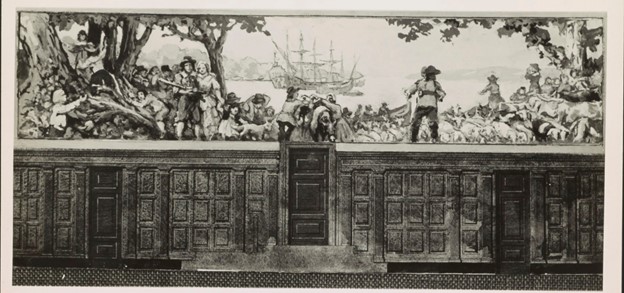
Undaunted, Mr. Pusterla tried again to produce designs for Courtroom 130. On December 7, 1937, a new application was submitted. This time, it was proposed that designs presenting modified versions of the subjects previously designated (with the exclusion of the one relating to Wall Street) would be placed on the rear wall. On the main wall, a new mural was proposed that would depict famous New Yorkers, such as William H. Seward, Martin Van Buren, Walt Whitman and William Cullen Bryant, presenting their contributions to New York and America to Father Knickerbocker, a figure, derived from a book by Washington Irving, who represented New York City in the nineteenth century and later.[324] There were to be decorative ornamentation on the walls and renderings of the figures of Peter Stuyvesant and DeWitt Clinton at the entrance doors.[325]
As before, the Commission disapproved the application. It did not specify the reason for its action, but did state that the disapproval was without prejudice to a re-submission after a conference with the Painter Member.[326] No re-submission occurred. I do not know why.
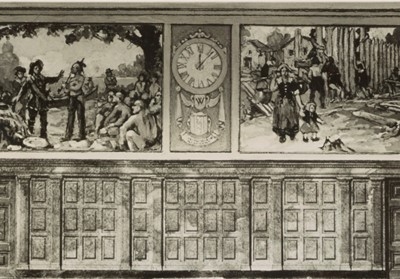
Thus, no murals were ever painted in Courtrooms 148 and 130, despite the fact that everyone recognized their prominence. As noted earlier in our discussion of the murals on the first floor, a substantial decorative mural was, however, painted over the entrance to Courtroom 130.
On May 10, 1937, after the disapprovals for Courtrooms 148 and 130 (the initial application), an application in the usual form and naming Pusterla was submitted by the Borough President for preliminary approval of murals for the Judges’ Dining Room on the Seventh Floor. It seems to us odd that Mr. Pusterla would have sought to decorate this space rather than produce successful designs for Courtroom 148, which was a vastly more prominent location than the Judges’ Dining Room and thus one far more suited to mural decoration. In any event, in this instance the plan was to provide decorative rather than full-scale representational murals. A decorated model was submitted in support of this application.[327] A rendering of the designs for the space was submitted. It shows that decorations were to be placed on one wall, where the entrances to the room and a mantle over the fireplace were located. On one side wall and on the rear wall where a clock was located, the decorations were to include head portraits of leading legal figures, such as John Jay and James Wilson, a legal scholar of the founding era, signer of the Declaration of Independence and the Constitution, and Associate Justice of the United States Supreme Court appointed by President Washington.[328] The next day, the Commission voted to disapprove the application, without articulating a reason for its action or stating that the decision was without prejudice.[329]
The Commission’s decision seems to have ended any thought of decorating the Judges’ Dining Room and no murals were ever created there. Years later, as I mentioned earlier, the dining room was closed and the space was converted to administrative offices of the court.[330]
In sum, then, applications were presented for murals intended to be created in Courtrooms 408, 148, and 130, which, in view of their roles in courthouse operations and the importance of their work to the legal process, were natural venues for mural decoration, and in the Judges’ Dining Room. The proposed designs for the first of these locations was approved and the others were all disapproved, but expressly without prejudice in the cases of Courtrooms 148 and 130. Notwithstanding the approval and the non-prejudicial disapprovals, the planned murals for all four of these locations never came into being. The walls of these rooms today remain blank, as they were in 1927 and in 1937.
IV. New Murals for the Courthouse
The fact that murals are absent from some sites in the courthouse in which they were intended to be installed suggests something to us. Respectfully, it seems to us that it would be a good idea for the court to consider commissioning new murals to be installed in these empty spaces or, rather, in most of them. Doing so would fulfill the early aspirations of the creators of the courthouse and the artists of the New Deal period. New murals could interpret and express the ideals of justice as they have evolved down to the present day and be paintings that can speak to, not just the present, but the future.
Today, it is not uncommon for critics, under the influence of what historians call “presentism,” to complain about murals, paintings, and sculpture created decades or centuries in the past for failure to comply with the standards of today, failure to reflect accurately the breadth of the society of the past, to be inclusive of all segments of that society, and to present developments in the past with accuracy, for both bad and good, all as we understand these things today. Such art, it is said, can be inspirational and celebratory in tone and purpose and so be suited to a public building and yet be truthful and not unreasonably sentimentalized.
While there may be an inclination to “revise” the art of the past to make it “better,” more reflective of the standards of today, I think that that inclination should be resisted if it were to involve the destruction or bowdlerization of art of the past. The murals of the New Deal era must be preserved as they are, and safeguarded from threats, as I will elaborate upon in a moment. But we can broaden the discussion that these murals encourage and their impact by adding additional canvas. Creating new art for the spaces from which art is missing would allow us to do that, if we have the skill and the commitment.
I think that any new murals for the courthouse must be compatible with the building as it is. It should be possible, however, for new murals to keep faith with the artistic inspiration of Guy Lowell, Attilio Pusterla, Andrew T. Schwartz, Winthrop Turney, John Edwin Jackson, and Robert Ryland, their work and its setting while also remembering and reflecting the history of law and the ideals of justice in new ways, with new eyes. It is certainly possible for artists of today to create new murals, whether abstract or representational, that will be in harmony with the courthouse and its existing art while still giving voice to a modern artistic sensibility.
Of course, there are practical considerations. Financing is in short supply. It always is; it was during the New Deal. But today it may be possible for private contributions to support new art for the courthouse. Competitions can be conducted, as the Treasury Section of Fine Arts did, to find the best designs for murals, while ensuring that political influence or the like has no place in the decisions made.
I suggest that consideration be given to creating murals for Courtroom 408 and Courtroom 130. Courtroom 148 ought to be thought about as well, if current operations there permit. All of these are, as I have explained, spaces for which murals were intended and, in the case of Courtroom 408, for which designs had been preliminarily approved. Room 300, the Ceremonial Courtroom, seems to us a natural location for additional art as well.
We should build upon the work of the New Deal artists and ready the courthouse for its second century and beyond by bringing new murals to the spaces for which the artists intended them.
V. Conservation of the Murals
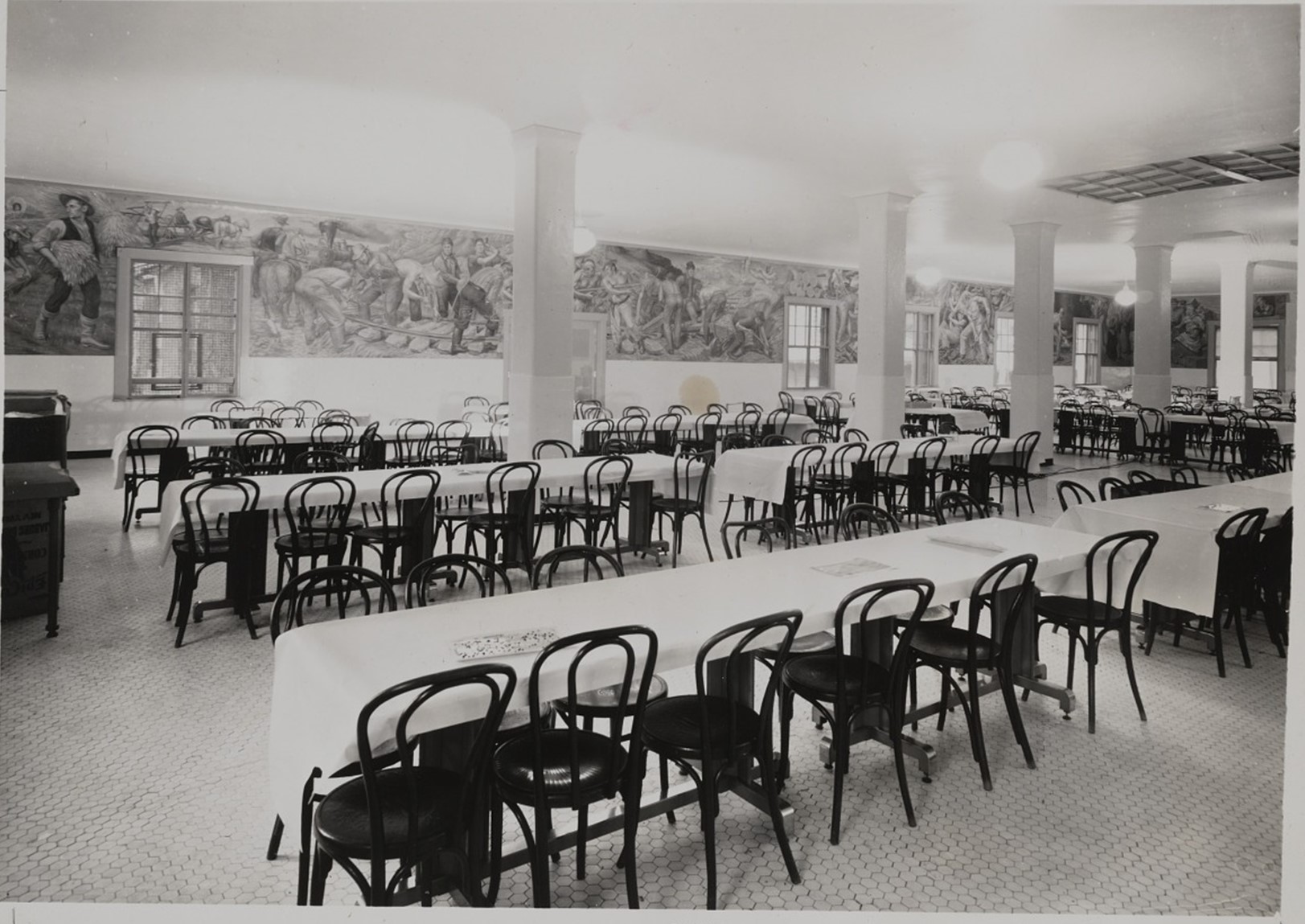
The federal art projects had many undoubted achievements across the country, so much so that one can fairly say that the 1930’s to early 1940’s was a time in which, despite the difficulties of the period, the visual arts made a great advance in the culture of the country, an advance that continues to have an impact to this day. Not all of the works produced under the sponsorship of the art projects, however, have survived well. The forces of neglect, ignorance, and mishandling never tire and never rest. Across the country, numbers of mural paintings have been destroyed or allowed to suffer serious damage through inadequate maintenance and care. Of the murals produced in New York, many have been damaged or destroyed. [331] Illustrative of the effects of indifference, ignorance, and neglect are these: Edward Laning’s impressive mural for Ellis Island was not sufficiently protected when the immigration center there was closed notwithstanding that it was the all-powerful Federal government that was the custodian and that the site in question was one of the most famous in America. As a result, the mural was seriously damaged by vandalism and in a storm in the 1950’s. Fortunately, years later, before the harm had affected all of the work and before the damage had become irreparable (only (only !) some 20 % of the mural was damaged beyond repair), restoration efforts were undertaken and the surviving portion of the mural is now in the Ceremonial Courtroom of the Federal Courthouse for the Eastern District of New York in Brooklyn, where many new immigrants take their oaths of citizenship;[332] thus, many of the audience who were intended to see this work continue to do so, although unaware that they are seeing it in its diminished state. Even less fortunate were Arshile Gorky’s murals at Newark Airport, which, with the exception of two panels now in the collection of the Newark Museum, were destroyed or lost while the facility was under military jurisdiction during World War II.[333] It is almost impossible to believe this when one looks at James Brooks’s extraordinary mural at the Marine Air Terminal, yet it is the fact that it was painted over in 1955 by order of visigoths employed by the Port Authority of New York and New Jersey, for no sound reason, possibly due to some kind of inexplicable misgivings about the common people taking advantage of the potentials of flight. Happily, some 30 years later, the original mural was restored.[334] Marion Greenwood’s fresco at the Red Hook Houses was largely destroyed. Apparently, all of the Federal Art Project murals at the World’s Fair were destroyed.[335]
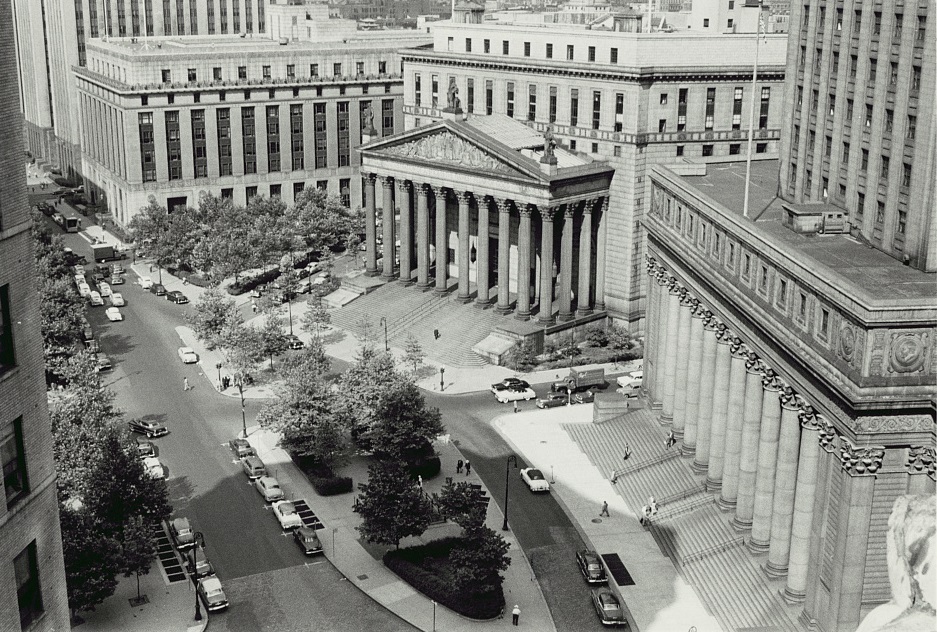
If a building needs to be remodeled or redeveloped, sold for another purpose, or demolished, the preservation of murals therein that were painted in fresco undoubtedly will be challenging. The comparative ease of movement and preservation of murals painted in oil on canvas does not, however, assure safety even to them, as we know from the cases of the murals of Laning and Gorky.
Thus, the history of the federal art programs is not just one of governmental responsiveness to and creativity in the face of public problems, creation, innovation, and artistic and financial struggles, but also one of despoliation and destruction over time. The art of that period “is constantly being eroded by time and human neglect ….” [336] Everyone who cares about the artistic heritage of this period needs to be aware of these failures and to remain alert to the condition of the surviving artwork, to physical problems afflicting the work, and to proposals or threats that would undermine the well-being or even imperil the further existence of this art.
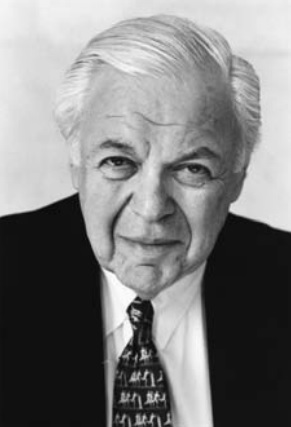
By the 1980’s, concern had developed about the condition of the murals on the first and second floors of the New York County Courthouse, especially the rotunda mural. Flaking of paint due to what was thought to be water damage became apparent and it was decided to undertake conservation of the murals. This effort was led by the leadership of the Supreme Court, Civil Branch, New York County, Hon. Xavier Riccobono, Administrative Judge, the long-serving County Clerk of New York County, Hon. Norman Goodman, and the City’s Department of Citywide Administrative Services (“DCAS”).
The effort was a part of a larger renovation project in the building conducted between the late 1980’s and the early 1990’s. Mr. Goodman, who was throughout his long tenure deeply concerned for the well-being of the courthouse and who in many ways was a steward of the building, raised private funds to support the plan to conserve the murals through the Historical Records of the New York County Clerk, Inc., a non-profit organization led by him.
At the initiative of Mr. Goodman and Judge Riccobono, with the support of DCAS, an expert in art restoration, Constance Silver, was brought in to survey the murals, determine precisely their status, and make suggestions about remedying issues discovered. Ms. Silver concluded that water damage to the murals on the first and second floors was indeed taking place and submitted a report with recommendations for addressing the problems. Repairs were made to the roof over the rotunda ceiling and humidity controls were installed. The copper roof over the dome of the rotunda (which is visible from the circular corridor on the third floor) was replaced and drainage pipes were installed to prevent water from accumulating, infiltrating into the rotunda, and damaging the ceiling. Under the direction of Ms. Silver, areas of damage to paint in the murals on the ceiling of the main hall and in the corridors on the first and second floors was repaired. Portions of the painting in some radiating corridors on the second floor had been painted over (the visigoths again !; they are always active) and the restorers had to recreate the original work. The conservation project proved to be highly beneficial.
As of this writing, however, and indeed for some time past, damage to the murals in the courthouse has accumulated. Damage to the mural on the rotunda ceiling, again probably due to infiltration of water, has become noticeable. In the section of the mural denominated “Colonial,” for instance, there are white marks characteristic of the flaking of paint in a number of places, including very noticeably in the blue tableau in the back of the scene, on two female figures, and in the image of the turkey in the lower right. There is also some damage in the area of marble at the bottom of the painting.
There are more problems that need prompt attention. Paint is peeling on the ceiling of the main corridor and there is some paint loss in the vestibule. There is peeling paint and what seems to be water damage on murals in some of the corridors on the second floor. In the Ceremonial Courtroom, there is some cracking and paint loss evident on some of the paintings. Some wall paint was accidentally painted onto the edges of some of the narrow decorative panels. On the mural on the rear wall dealing with the surrender of New Netherland to the English there is some chipping paint and a substantial tear in the canvas. There appears to be some paint loss in some places on murals in Jury Assembly Room 452. In Room 448, one of the murals has suffered extensive water damage: the mural is marred from top to bottom on the left side, apparently due to a water leak that originated on the floor above. The painting is coming loose from the wall at the bottom due to the damage. In the conference room on the Seventh Floor, there are some stains, loss of paint, and tears, and unraveling at the edges where there are cutouts in the mural that accommodate electric outlets. In addition, some wall paint that was being applied to the top of the walls or the ceilings dripped onto the surface of the mural. There appears to be some fading on the murals.
Beyond these forms of damage, at least the paintings in Rooms 300 and 452 and the conference room appear to be in need of cleaning. When were the murals last cleaned ? Have they ever been cleaned ?
Thirty years after the completion of the conservation project, it appears that a study urgently needs to be made of the condition of all of the murals, particularly that on the rotunda ceiling, and of the causes of the degradation that appears to be underway. Steps need to be taken to remedy all the problems that will be discovered. It is the hope of the author that the troubles that endanger the priceless murals will not be allowed to fester and grow more serious with the passage of time, that irreparable harm of the sort that has befallen other murals will not be permitted to occur, that we will not be forced to add the paintings of the New York County Courthouse to the list on which appear Laning’s murals at Ellis Island, Gorky’s murals in Newark, James Brooks’s murals at LaGuardia, Marion Greenwood’s murals in Red Hook, and so many others, far too many. If we pay careful attention and take timely action in the spirit of Mr. Goodman and Judge Riccobono, we can hope that the murals of the New York County Courthouse will survive and endure long into the future.
Conclusion
As we look at and think about the murals of 60 Centre Street, we viewers would do well to remember this salient fact about every one of them – – that they were executed during the darkest depths of the Great Depression, a time of national economic catastrophe without parallel in the history of this country, when the artists who made them were being sustained, at the princely rate of something like $ 34 per week, by art programs of the government (the Public Works of Art Project and the Federal Art Project), as were many of their fellow citizens through other government efforts. The artists — Attilio Pusterla, Andrew T. Schwartz, Winthrop D. Turney, John Edwin Jackson, and Robert K. Ryland, and Mr. Schwartz’s assistants, Nino Polimeni and Jacob Ruppert, as well as assistants whose names are now unknown to us, some of whom were likely immigrants to the United States, as was Pusterla — were able to rise far above the limitations placed on them by the gravity of the situation that faced all of New York City and the country during those troubled years. They were able to concentrate their attention and energies, overcome any pessimism, gloom, or fear that might have afflicted them, and do their work. In doing so they “gifted New York City with a beauty that continues to outlast any economic turmoil or social crisis,”[337] a beauty that conveys a sense of confidence, against all odds, about the resilience of humanity in the face of hard times and difficult challenges. The work of these artists emphasizes the profound and permanent value of our ideals of law and justice, ideals that underlie the daily labor of the New York County Courthouse and of every courthouse in this country. The efforts of these artists also urge the viewer to continue to strive, whatever the challenges, to do his or her part to make those ideals always more nearly a reality for every one of our fellow citizens.
Appendix: The Murals of the New York County Courthouse
Principal Murals (38 Murals)
First and Second Floors (Frescoes)
- Three domed-mural on the vestibule ceiling
- One wall mural each over two passages at the ends of the vestibule
- Mural on the barrel-vaulted and domed ceiling of the main corridor
- Mural on the ceiling of the rotunda – – “The Growth of the Law”
- Wall mural over the entrance door to Room 130
Walls of the Ceremonial Courtroom (Room 300) — Murals on the History of New York
- Three mural paintings on law in early New York
- Face of a clock (fresco)
- Seal of New Amsterdam (fresco)
- Seal of the City of New York, 1686 (fresco)
Walls of the Jury Assembly Room (Room 452) — Murals on New York City in the 1930’s
- Mural depicting New York Harbor
- Mural showing mid-town viewed from Brooklyn
- Mural showing Grant’s Tomb and Riverside Church
- Six paintings showing scenes of prominent places in New York
Walls of the Jury Assembly Room (Room 448) — Murals on historical New York City
- Eleven murals of scenes showing the history of New York City from the early seventeenth century to 1873
Walls of the Conference Room, 7th Floor — Murals int he style of tapestries
- Four murals showing allegorical depictions of Painting, Music, Literature and Sculpture
- Two accompanying decorative wall murals
Decorative Murals
- Paintings on the ceilings and walls in fresco, corridors of the first and second floors
- Ceiling painting in fresco, circumference of the rotunda, first and second floors
- Eighteen narrow panels, Room 300
- Panels beneath windows, Room 448
Note: Paintings are oils on canvas unless indicated otherwise.
Endnotes
[*] Robert C. Meade, Jr. is an attorney. Among other things, he served as First Deputy Chief Clerk of the Supreme Court, Civil Branch, New York County.
The author is very grateful to John F. Werner, Esq. for his support and assistance and information provided, all of which have been indispensable, during the preparation of this article. Mr. Werner served as the Chief Clerk and Executive Officer of the Supreme Court, Civil Branch, New York County for three decades, ending in 2019. During his tenure, he was noted, among many other things, for his devotion to the courthouse and his tireless efforts to protect it and advocate for effective maintenance of it.
The author also expresses his deep gratitude for assistance cheerfully given to him by Juliana Monjeau of the Public Design Commission of the City of New York; Allison M. Morey, the indefatigable Executive Director of the Historical Society of the New York Courts; and the always-helpful Michelle Gonsieski and Naomi Ruiz of the staff of the New York County Courthouse.
Appreciation is also due to Professors Greta Berman, Helen Harrison, and Jonathan Ritter for a highly-informative program about the murals and their historical context presented in June 2024 in the rotunda of the courthouse. This program was in honor of Norman Goodman and was sponsored by the Historical Society of the New York Courts.
[1] Landmarks Preservation Commission, Designation Report, Designation List 141, LP-1124, March 24, 1981(hereinafter cited as “Landmarks Report”). The “Report” section of this document was written by Rachael Carley of the Commission’s Research Department.
[2] Glenn Palmer-Smith, Murals of New York – The Best of New York’s Public Paintings From Bemelmans to Parrish, (Rizzoli 2013)(hereinafter cited as “Murals”).
[3] Graydon Carter, “Introduction,” in Murals at p. 5.
[4] Murals at p. 109.
[5] “60 Centre Street, A Look Back, With Some Ruminations about the Future” (June 2023), accessible at https://history.nycourts.gov/60-centre-street-lookback/.
[6] Id.; “Fresco Painting at the Courthouse Wins Approval,” N.Y. Herald Tribune, Jan. 3, 1934, p. 13.
[7] For more on the history of the courthouse, see “60 Centre Street, A Look Back, supra note 5.
[8] Writer Glenn Palmer-Smith attributes the delay to the Great Depression. Murals at p. 109.
[9] “Court House Gets First CWA Murals,” New York Times, Jan. 3, 1934, p. 21; “Fresco Painting at the Courthouse Wins Approval,” N.Y. Herald Tribune, Jan. 3, 1934, p. 13; “New Court House Gets First Murals Under CWA Plan,” The Art News, Jan. 6, 1934, p. 17.
[10] Francis V. O’Connor, “New Deal Murals in New York,” Art Forum Vol. 7, No. 3 (Nov. 1968), accessible at https://www.artforum.com/features/new-deal-murals-in-new-york-210982/. The quotation in the text is from the on-line version of this article (at p. 4), as are other citations elsewhere in the notes.
[11] The landscape is complicated even further than is described in the text: the Federal Emergency Relief Administration helped artists indirectly between the end of PWAP in June 1934 and the start of the Federal Art Project in 1935. The Relief Administration ran parallel with New York State’s Temporary Emergency Relief Administration. This last funded an innovative work relief program for artists operated by the College Art Association in New York City from about 1932. Thus, New York City, the national center for art, had an influential role in the generation of the New Deal art programs. Francis V. O’Connor, “Introduction,” in Francis V. O’Connor (ed.), The New Deal Art Projects: An Anthology of Memoirs p. 3 (Smithsonian Press Washington 1972). For a summary of the work of the College Art Association, see Audrey McMahon, “A General View of the WPA Federal Art Project in New York City and State,” in Francis V. O’Connor (ed.), The New Deal Art Projects, at pp. 52-54.
[12] Francis V. O’Connor, “Introduction,” supra note 11, at pp. 3-4. A copy of Biddle’s letter of May 9, 1933 is at Antonio Vasaio, “The Fiftieth Anniversary of the U.S. Department of Justice Building, 1934-1984” pp. 68-69 (1984).
[13] Olin Dows, “The New Deal’s Treasury Art Program: A Memoir,” in Francis V. O’Connor (ed.), supra note 11, at pp. 11, 14-16. The PWAP was in operation from December 1933 to June 1934. The Civil Works Administration was also short-lived, running from November 1933 to March 1934. It was an emergency effort that sought to provide temporary employment for unemployed workers, usually jobs in construction and other forms of manual labor, during the difficult winter of 1933-34.
[14] Richard D. McKinzie, The New Deal for Artists 93 (Princeton Univ. Press 1973).
[15] Forbes Watson, “The Public Works of Art Project,” American Magazine of Art Vol. 27, No. 1, p. 6 (Jan. 1934).
[16] Francis V. O’Connor, “The New Deal Art Projects in New York,” 1 American Art Journal No. 2, pp. 58, 67-68 (Autumn 1969), accessible at https://www.jstor.org/stable/1593876.
[17] Id. at p. 59.
[18] Richard D. McKinzie, supra note 14, at pp. 12-17.
[19] Id. at pp. 22-23.
[20] Id. at pp. 23-26.
[21] Id. at p. 26.
[22] Francis V. O’Connor, supra note 16, at p. 68.
[23] Id. at p. 60.
[24] Richard D. McKinzie, supra note 14, at pp. 27, 32. Artists who wished to complete their work after PWAP ended had to “go on relief,” which no doubt many found humiliating, and they were obliged to submit to bureaucratic requirements, including some that created uncertainty as to how many days they would be allowed to work. Id. at 27. This period of government support took place under the Federal Emergency Relief Administration, which was reactivated after the demise of the Civil Works Administration. Id. See note 11.
[25] Olin Dows, supra note 13, at pp. 19-24.
[26] Marlene Park & Gerald E. Markowitz, Democratic Vistas: Post Offices and Public Art in the New Deal pp. 7-8 (Temple Univ. Press 1984).
[27] Richard D. McKinzie, supra note 14, at pp. 35-51.
[28] Olin Dows, supra note 13, at p. 19.
[29] Richard D. McKinzie, supra note 14, at p. 53.
[30] Francis V. O’Connor, supra note 16, at p. 62.
[31] Richard D. McKinzie, supra note 14, at p. 53.
[32] Marlene Park & Gerald E. Markowitz, supra note 26, at p. 11-12.
[33] Richard D. McKinzie, supra note 14, at p. 54.
[34] Marlene Park & Gerald E. Markowitz, supra note 26, at p. 8.
[35] Francis V. O’Connor, supra note 16, at p. 62. Professor O’Connor describes difficulties two muralists, one of them Ben Shahn, encountered working on murals in New York City as a result of the rigorous oversight of Treasury art administrators. The Section, he concludes, was “too cautious.” Francis V. O’Connor, “Introduction,” supra note 11, at p. 11.
[36] Marlene Park & Gerald E. Markowitz, supra note 26, at p. 8.
[37] Id. at p. 179.
[38] Id. at p. 8.
[39] Olin Dows, supra note 13, at pp. 12, 25-26.
[40] Id. at p. 26.
[41] Id. at p. 30.
[42] Francis V. O’Connor, “Introduction,” supra note 11, at p. 17.
[43] Id. at p. 18.
[44] Richard D. McKinzie, supra note 14, at pp. 76-80.
[45] Id. at p. 80. See also Francis V. O’Connor (ed.), Art for the Millions: Essays from the 1930s by Artists and Administrators of the WPA Federal Art Project (New York Graphic Society Boston 1973).
[46] Holger Cahill, “Mural America,” Architectural Record at pp. 66-67 (Sept. 1937).
[47] Francis V. O’Connor, supra note 16, at p. 64.
[48] Olin Dows, supra note 13, at p. 25.
[49] Richard D. McKinzie, supra note 14, at p. 80.
[50] Id. at pp. 94-95.
[51] Several decades after the end of the federal art programs, one scholar, while noting the distinctions between the administration of the Section and that of the Federal Art Project, contended that in practice in New York State a more notable distinction can be found between the murals produced in New York City and those produced in the rest of the state. The former tended to be more international in outlook, to see the city as an inheritor of and product of a great tradition in western culture and science, and to focus on national economic concerns or realties. The city is seen as reflecting and expressing a dynamic vision that leads one to expect a better future for the country. In contrast, the murals done outside the city emphasize local phenomena and historic events of limited and local interest and reflect a static vision. Marlene Park, “City and Country in the 1930s: A Study of New Deal Murals in New York,” 39 Art Journal No. 1, p. 37 (Autumn 1979), accessible at https://www.jstor.org/stable/776326. The author illustrates her thesis by pointing to, among other examples of city art, Pusterla’s rotunda ceiling and the murals of Andrew T. Schwartz in Room 300, discussed later.
[52] Olin Dows, supra note 13, at p. 25.
[53] Id. at pp. 25-26.
[54] Francis V. O’Connor, “Introduction,” supra note 11, at pp. 11-12.
[55] Richard D. McKinzie, supra note 14, at pp. 81-84.
[56] Id. at p. 188.
[57] Id. at pp. 84-85.
[58] The WPA administrator, Lt. Col. Brehon Somervell, dismissed a Federal Art Project artist and caused three murals painted by the artist for Floyd Bennett Field in Brooklyn to be destroyed because the administrator deemed them to be Communist propaganda. The artist asserted that the administrator misunderstood the subjects of the painting, although he admitted to the press that he had in prior years run for public office as a Communist. The artist noted that the murals had been subject to close supervision for years during their development and had been approved by the relevant authorities. “Red Propaganda in WPA Murals at Floyd Bennett Field Charged,” N.Y. Times, July 7, 1940, p. 4; “Painter of Murals to Sue Somervell,” N.Y. Times, July 10, 1940, p. 21. Somervell ordered that an investigation of 1,000 Federal Art Project employees in New York City be undertaken by the police and the FBI. The United American Artists union defended the artist’s work and criticized the destruction of the murals. Gerald M. Monroe, “Mural Burning by the New York City WPA,” 16 Archives of American Art Journal No. 3, p. 8 (1976), accessible at https://www.jstor.org/stable/1556863.
[59] Audrey McMahon, “A General View of the WPA Federal Art Project in New York City and State,” in Francis V. O’Connor (ed.), The New Deal Art Projects, supra note 11, at pp. 51, 56.
[60] Id. at p. 57.
[61] Richard D. McKinzie, supra note 14, at pp. 85-89.
[62] Id. at pp. 109-112. Among the controversies noted by the author were two involving Pusterla’s rotunda ceiling at the New York County Courthouse. See note 235 and the related text.
[63] Olin Dows, supra note 13, at p. 28.
[64] Audrey McMahon, supra note 11, at p. 66.
[65] Id. at p. 67.
[66] Id. at p. 75.
[67] Francis V. O’Connor, “Introduction,” supra note 11, at p. 1.
[68] Landmarks Report, supra note 1, at p. 5.
[69] Holger Cahill, supra note 46, at p. 63. In the text is a photo of muralist Marion Greenwood at work on a Federal Art Project mural at the Red Hook Houses in New York City. For images of the completed mural, see the Archives of American Art at the Smithsonian, accessible at https://www.si.edu/object/archives/components/sova-aaa-greemari-ref37?destination=collection/search%3Fpage%3D109%26edan_q%3D%26edan_fq%255B0%255D%3Dtype%253A3d_package%2520OR%2520type%253Aead_collectio
n%2520OR%2520type%253Aead_component%2520OR%2520type%253Aecr%2520OR%2520type%253Aedanmdm%2520OR%2520type%253Aevent%2520OR%
2520type%253Alocation%2520OR%2520type%253Aobjectgroup%2520OR%2520type%253Asi-unit%26edan_fq%255B1%255D%3Dtype%253A%2522ead_collection%2522%26edan_local%3D1.
[70] Francis V. O’Connor, “Introduction,” supra note 11, at p. 4.
[71] Id. at pp. 16-17.
[72] Id. at p. 14.
[73] Id. at pp. 12-15. See Edward Laning, “When Uncle Sam Played Patron of the Arts: Memoirs of a WPA Painter,” American Heritage Vol. 21, Issue No. 6 (October 1970). Brooks’s Flight is discussed in Murals.
[74] “Court House Gets First CWA Murals,” N.Y. Times, Jan. 3, 1934, p. 21.
[75] Application for Approval, N.Y.C. Art Commission, Submission 4380, Series 739, Ex. BH (Jan. 9, 1934).
[76] Francis V. O’Connor, “Introduction,” supra note 11, at p. 12.
[77] “Court House Gets First CWA Murals,” N.Y. Times, Jan. 3, 1934, p. 21; “Fresco Painting at the Courthouse Wins Approval,” N.Y. Herald Tribune, Jan. 3, 1934, p. 13. A curious coincidence is that the president of the Municipal Art Society who had submitted the request for funding for painting of the vestibule, Electus D. Litchfield, had served as the architect for the Astoria Column for which Pusterla provided the sgraffito exterior in 1926.
[78] “Fresco Painting at the Courthouse Wins Approval,” N.Y. Herald Tribune, Jan. 3, 1934, p. 13.
[79] “Fresco Work to Start at Courthouse Today,” N.Y. Herald Tribune, Jan. 8, 1934, p. 9. It was reported that, taking into account the courthouse project and work at other facilities then being planned in the area, including Ellis Island and the American Museum of Natural History, work was being provided for 24 portrait painters, 75 muralists, 161 easel painters, 71 sculptors, 20 graphic artists, and 5 artist-craftsmen. Id.
[80] “CWA Project Gives 2,500 Artists Work,” N.Y. Times, Feb. 23, 1934, p. 21.
[81] Id.
[82] Paolo Plebani, “Attilio Pusterla,” 85 Dizionario Biografico degli Italiani (2016), at https://www.treccani.it/ enciclopedia/attilio-pusterla_(Dizionario-Biografico), at p. 6.
[83] “P.W.A. Frescoes in Courthouse Have Pre-View,” N.Y. Herald Tribune, April 20, 1934, p. 17.
[84] Application for Approval, N.Y.C. Art Commission, Submission 4432, Series 739, Ex. BJ (April 11, 1934). In June, the Commission reported to President Levy that work on the mural decorations was proceeding satisfactorily. Letter of Commission Assistant Secretary to Pres. Levy, June 22, 1934, Series 739, Ex. BH.
[85] Application for Approval, N.Y.C. Art Commission, Submission 4845, Series 739, Ex. BL (Oct. 3, 1935). Approval is recorded on the application form. A photograph of the model of the decorated ceiling that accompanied the application is Series 739, Ex. BM, dated Oct. 22, 1935.
[86] Certificate Regarding Resolution of the Commission, Oct. 8, 1935, Series 739, Ex. BL.
[87] “W.P.A. Mural in Courthouse Ready on July 1,” N.Y. Herald Tribune, May 31, 1936, p. A 3.
[88] Marlene Park & Gerald E. Markowitz, New Deal for Art: The Government Art Projects of the 1930s with Examples from New York City & State p. 160 (Gallery Assn. of New York State 1977).
[89] “Court House Art to Be Ready July 1,” N.Y. Times, May 31, 1936, p. 71.
[90] “Row Over Picture of Luther Settled,” N.Y. Times, March 26, 1937, p. 23.
[91] About Pusterla’s life and work in Italy, see “Attilio Pusterla,” Gallery of the Fondazione Cassa di Risparmio di Tortona, accessible at https://www.ildivisionismo.it/attilio-pusterla/; Angelo de Gubernatis (ed.), Dizionario degli Artisti Italiani Viventi 395 (Firenze 1889); Paolo Plebani, supra note 82.
[92] Angelo de Gubernatis, supra note 91, at 395.
[93] Annie-Paule Quinsac, “Cinquant’anni di studi sul Divisionismo Italiano: Un Consuntivo,” in Elisabetta Staudacher, Brera 1891: L’Esposizione che rivoluziono` l’arte moderna pp. 55, 56 (Gallerie Maspes Milano 2016).
[94] Istituto Treccani, “Divisionismo,” Encicilopedia On Line, https://www.treccani.it/enciclopedia/divisionismo; https://collezionedarte.bancaditalia.it/web/guest/-/divisionismo. For more about divisionism, see Annie-Paule Quinsac, Divisionismo Italiano: Squardi e Prospettive, 1880-1920 (Roccafranca Massetti Rodella 2021); Teresa Fiori (ed.), Archivi del Divisionismo (Rome Officina Edizioni 1968).
[95] “Attilio Pusterla,” Gallery of the Fondazione Cassa di Risparmio di Tortona, accessible at https://www.ildivisionismo.it/attilio-pusterla/.
[96] https://www.ildivisionismo.it.
[97] Annie-Paule Quinsac, “Attilio Pusterla,” in La Permanente: Un secolo d’arte a Milano, 1886-1986, p. 142 (Societa` per le Belle Arti ed Esposizione Permanente, Milano 1986). This work was published in connection with a show at the Permanente in 1986.
[98] See Aurora Scotti Tosini, Giuseppe Pellizza da Volpedo, Quarto Stato in Marco Bascape` & Paola Zatti (eds.), Quattro storie Milanesi: Arte sociale tra ‘800 e ‘900; Angelo Morbelli, Giuseppe Pellizza da Volpedo, Attilio Pusterla, Giovanni Sottocornola p. 59 (Silvana Editoriale 2019); Danka Giacon, Il Quarto Stato al Museo del Novecento, in id. at p. 75.
[99] https://gallerieditalia.com/en/online-museums/artworks/poor_people_begging-14136.
[100] Annie-Paule Quinsac, supra note 97, at p. 142.
[101] Omar Cucciniello, Attilio Pusterla, Alle cucine economiche di Porta Nuova, in Marco Bascape` & Paola Zatti (eds.), supra note 98, at p. 32.
[102] Id. at p. 33.
[103] Carmine Cimmino, “Attilio Pusterla, ‘Alle Cucine Economiche’: Un Quadro del 1887, che Porta i Segni dell’Attualita`,” Il Mediano (Oct. 24, 2020), accessible at https://www.ilmediano.com/attilio-pusterla-alle-
cucine-economiche-un-quadro-del-1887-che-porta-i-segni-dellattualita/.
[104] Omar Cucciniello, supra note 101, at p. 35.
[105] Id. at p. 34.
[106] Luca Moriconi, “Mercante, pittore e critico: in mostra tutta la vita di Grubicy,” Il Giornale.it (July 22, 2005), https://www.ilgiornale.it/news/mercante-pittore-e-critico-mostra-tutta-vita-grubicy.html.
[107] Omar Cucciniello, supra note 101, at pp. 34, 38.
[108] Marco Fazio, “Alle cucine economiche di Porta Nuova” (Jan. 18, 2010) http://oradiarte.blogspot.com/2010/01/alle-cucine-economiche-di-porta-nuova.html. There are some touches of similarity between the first Cucine Economiche and Angelo Morbelli’s Giorni Ultimi (“Final Days”) of 1883, one of a series of paintings Morbelli did about old age and its problems. See F. Laurocci (ed.), “Arte come impegno sociale,” Istituto Italiano Edizioni Atlas, Figs. 11 & 12, https://www.edatlas.it.
[109] Annie-Paule Quinsac, “Cinquant’anni di studi sul divisionismo italiano: Un consuntivo,” in Elisabetta Staudacher, supra note 93, at p. 55.
[110] Elisabetta Staudacher, “La Rivoluzione della Prima Triennale di Brera,” in Elisabetta Staudacher, supra note 93, at pp. 11, 26.
[111] Serena Bertolucci & Giovanni Meda, Le collezioni d’arte di Enrico Mylius: Novita` e approfondimenti p. 22, in Villa Vigoni – – Comunicazioni (Oct. 1997), accessible at https://www.villavigoni.eu/wp-content/uploads/2018/03/02-I-2-ottobre-1997.pdf.
[112] Omar Cucciniello, supra note 101, at p. 36.
[113] Marco Fazio, supra note 108.
[114] Omar Cucciniello, supra note 101, at p. 37. This scholar concludes that while aspects of divisionist technique are not to be found in the first Cucine Economiche, “there nevertheless remains the modernity of a painting language without precedent in that moment, which would contribute in a decisive way to the successive developments both of Lombardian naturalism and of Divisionism and the art of the 20th century.” Id. at p. 39.
[115] Annie-Paule Quinsac, supra note 97, at p. 142.
[116] “Attilio Pusterla,” Gallery of the Fondazione Cassa di Risparmio di Tortona, accessible at https://www.ildivisionismo.it/attilio-pusterla/.
[117] Annie-Paule Quinsac, supra note 97, at p. 142.
[118] Denis Mack Smith, Italy: A Modern History pp. 192-93 (U. Mich. Press 1959).
[119] “Attilio Pusterla,” at https://www.valutazionearte.it/artisti/attilio-pusterla; Obituary, Attilio Pusterla, New York Times, May 2, 1941, p. 21.
[120] Annie-Paule Quinsac, supra note 97, at p. 142. Ms. Quinsac describes and provides illustrations of five works by Pusterla: Il vagone di prima classe (1892), a privately held oil on canvas presented at a show in Venice in 1980; Ritratto di Signora (1895), a striking pastel from a private collection that was shown at the Permanente in 1895 with three other pastels and an oil (Nel Mercato); Portrait of a Baby Girl (1895), a pastel from the Permanente of 1895 that was shown in Italy in 1984; In Vettura (c. 1895), oil on canvas; and Paesaggio sull’Hudson con lo Sfondo di Manhattan, an oil on canvas from 1913, showing a view of the Hudson with Manhattan in the background. Annie-Paule Quinsac, supra note 97, at pp. 143-44, citing Mario Monteverdi, Attilio Pusterla e alcune sue opere inedite venute dall’America (Daverio Silbernagl 1984).
[121] “Attilio Pusterla,” Gallery of the Fondazione Cassa di Risparmio di Tortona, accessible at https://www.ildivisionismo.it/attilio-pusterla/; Paolo Plebani, supra note 82.
[122] Joan Bryden, “’Body’ Found on Mural in NDP Leader Tom Mulcair’s Parliamentary Office,” Toronto City News, Feb. 1, 2013, accessible at https://toronto.citynews.ca/2013/02/01/body-found-on-mural-in-ndp-leader-tom-mulcairs-parliamentary-office/. The long-serving Prime Minister, William Mackenzie King, refused to move out of the office after his ascension to the position of Prime Minister in 1921 because of his affection for it. The fresco had been obscured by paneling for decades. “Mackenzie King Fresco Unveiled After Decades in the Dark,” CTV News, Feb. 20, 2013. https://www.ctvnews.ca/politics/mackenzie-king-fresco- unveiled-after-decades-in-the-dark-1.1165426.
[123] Laurel Ryan, “Parliamentary Gothic: The Art of History in Canada’s Parliament Buildings,” 52 Mosaic: An Interdisciplinary Critical Journal No. 3, pp. 146-49 (Sept. 2019), accessible at https://www.jstor.org/stable/26781583.
[124] John Geddes, “The Secrets of Parliament Hill: Inside the Heart of Canada’s Democracy,” Maclean’s, Feb. 3, 2016, “Secrets of Parliament’s Centre Block: The Opposition Leader’s Angel,” YouTube video, accessible at https://macleans.ca/politics/ottawa/the-secrets-of-parliament-hill-inside-the-heart-of-canadas-democracy/.
[125] sencanada.ca/en/sencaplus/how-why/en-route-murals-celebrating-canadas-transportation-history-temporarily-leave-centre-block/. A video is available at this site showing how the murals were removed and protected.
[126] “Sgraffito,” in Oxford Reference, at www.oxfordreference.com/display/10.1093/oi/authority.20110803100458245.
[127] Malcolm Rice, “Sgraffito and Its Application,” 35 Architectural Forum No. 6, p. 204 (Dec. 1921); Heywood Sumner, “Sgraffito as a Method of Wall Decoration, Art Journal 21-26 (1902), accessible at https://victorianweb.org/art/design/sgraffiti/sumner1902.html; Marzanna Jagiello, “Sgraffito as a Method of Wall Decoration in the Renaissance and Mannerist Silesia,” Arts 11, 25 (2022), accessible at https://doi.org/10.3390/arts11010025; “Sgraffito,” Monumental Almaty, at www.monumentalalmaty.com/sgraffito-Explainer.html; Andreas Huth, “Sgraffito Decoration in 14th and 15th Century Florence – Invention, Technology, Significance,” at https://www.academia.edu/29778616/_Abstract_English_Sgraffito_Decoration_in_14th_and_15th_Century_Florence_Invention_Technology_Significance.
[128] “History of the Column: Spring-July 1926 – The Artist Behind,” accessible at https://astoriacolumn.org/history.
[129] See Janet Filips, “Astoria Column,” in Oregon Historical Society, Oregon Encyclopedia, accessible at https://www.oregonencyclopedia.org/articles/astoria_column/; Randal O’Toole, “Mr. Budd’s Historical Expeditions,” 65 Minnesota History No. 1, p. 14 (Spring 2016), accessible at https://www.jstor.org/stable/24898930. Images of the column can be seen at Filips and at https://astoriacolumn.org and nps.gov/places/astoria-column.htm. A photograph of the column on dedication day is at O’Toole at p. 15.
[130] “News and Comment,” 37 Oregon Historical Quarterly No. 3, p. 269 (Sept. 1936), accessible at
https://www.jstor.org/stable/20611007. Further restoration was completed in 1995. Janet Filips, supra note 129.
[131] See Janet Filips, supra note 129.
[132] Obituary, Attilio Pusterla, New York Times, May 2, 1941, p. 21.
[133] “DaVinci Art School Opens,” New York Times, Dec. 23, 1923, Sect. 1, p. 5.
[134] “A Free Evening Art School,” New York Times, March 31, 1935, Sect. 11, p. 12; Joseph Sciorra & Peter Vellon, “The Art of Freedom: Onorio Ruotolo and the Leonardo Da Vinci Art School” (2004), accessible at https://calandrainstitute.org/wp-content/uploads/2018/05/Onorio-Ruotolo-Calandra-Exhibition-2004.pdf.
[135] The club was the Piping Rock Club House (Locust Valley) and the residences were those of Reginald Barclay (Sag Harbor), Paul D. Cravath (Locust Valley), Guernsey Curran (Oyster Bay), Arthur Vining Davis (Mill Neck), Julian A. Ripley (Brookville), and “Farnsworth” of C.K.G. Billings. Lowell also did landscape design for the residences of William R. Coe (Oyster Bay), Clarence Mackay (Roslyn), and William P. Whitney (Manhasset). Robert B. Mackay et al (eds.), Long Island Country Houses and Their Architects, 1860-1940 p. 474 (Norton 1997).
[136] The house had a glass ceiling over the interior courtyard. Lowell created a glass roof for a section of the County Courthouse, which is still in place today. Farnsworth was owned after Billings’ death by W.C. Bird, who retained its name. It was demolished in the 1960’s. How it came to be demolished is a tragic story. Bird was something of an aviator. In 1941, he was killed in an air accident near his upstate home. His wife, devastated by the loss, collected the remnants of the crash and stored them at Farnsworth. She then left Long Island for Europe and was away for many years, during which time she made little effort to preserve the mansion. While still abroad she was victimized by her physician and another, who drugged her to steal her money and then murdered her. Thereafter, Farnsworth, then in serious disrepair, was taken down. Monica Randall, The Mansions of Long Island’s Gold Coast pp. 108-111 (Rizzoli 2003). Many photos of what Farnsworth looked like can be found at https://halfpuddinghalfsauce.blogspot.com/2013.09/farnsworth-long-island-home-of-c-k-g.html. See also photographs in Robert B. Mackay, supra note 135 and Monica Randall. Lowell also designed Tryon Hall, the New York City home of Billings, located at what is today Fort Tryon Park.
[137] “Farnsworth,” House & Garden pp. 32-33 (Oct. 1915); “’Farnsworth’ Estate of C.K.G. Billings, Esq.,” American Architect Vol. 108, No. 6, pp. 126-40, 159 (July-Dec. 1915).
[138] Obituary, “Pusterla Dead; Mural Painter for Courthouse,” N.Y. Herald Tribune, May 2, 1941, p. 18. It has been written that Pusterla executed murals in the New York home of Edward Stettinius, Jr., who later served as Secretary of State under President Roosevelt. Landmarks Report , supra note 1, at p. 6.
[139] The patents are 1,009,855 (1911), 996,425 (1911), both U.S. patents, and GB205847 (Great Britain, 1922).
[140] These two patents are 917,894 (1909) and 950,055 (1910), respectively.
[141] These four patents are, respectively, 724,040 (1903), 776,936 (1904), 774,274 (1904), and 821,060 (1906). The patents reveal that Pusterla was living in different places at various times – Coney Island in Brooklyn, Philadelphia, St. Louis, Missouri, Bathbeach, Long Island, West Hoboken, New Jersey, and Fort Wadsworth, Staten Island.
[142] “New Amusement Concern,” Brooklyn Daily Eagle, Jan. 9, 1905, p. 15; New York Times, Jan. 8, 1905, p. 24.
[143] The pleasure waterway patent numbered 776,936 (1906) was apparently the basis for the Hell Gate ride. Stephen R. Wilk, Lost Wonderland: The Brief and Brilliant Life of Boston’s Million Dollar Amusement Park pp. 39-42 (Bright Leaf 2020).
[144] “Dreamland Reopens and Shows New Glories,” New York Times, May 20, 1906, p. 9.
[145] Stephen R. Wilk supra note 143, at pp. 33-34.
[146] Id. at p. 206.
[147] “Flames Sweep Coney Island,” N.Y. Times, May 27, 1911, p. 1; “Ruins Help Draw 350,000 to Coney,” N.Y. Times, May 29, 1911, p. 3.
[148] Obituary, N.Y. Times, May 2, 1941, p. 21.
[149] For example, the Gallery of Modern Art in Milan put on a show in 1980 addressed to him and his images of proletarian life. Monograph, Immagini di vita proletaria: Attilio Pusterla e le cucine economiche: Ipotesi di lettura attraverso la grafica, la pubblicistica e la cultura architettonica del tempo (1980). See https://opac.sbn.it/risultati-ricerca-avanzata/-/op-adv/index/6/ITICCUSBL0309760?fieldstruct% 5B1%5D=ricerca.parole_tutte %3A4%3D6&fieldvalue%5B1%5D=pusterla%2C+attilio&fieldaccess%5B1%5D=Any%3A1016%3 Anocheck&struct%3A1001=ricerca.parole_almeno_una%3A%40or%40. Pusterla was one of the subjects of an exhibition at Catanzaro in October 2007. A volume that accompanied that show is Francesca Cagianelli et al. (eds.) Il convito e l’arte: Tra l’Ottocento e il Primo Novecento (Silvana Editoriale Milan 2007). In 2018-2019, a show about Lombardian painters of the 19th century, including Pusterla (“Ottocento Lombardo”), was put on in Lecco. Ida Paola Sozzani, “La Pittura dell’Ottocento in Lombardia,” (Oct. 27, 2018), accessible at https://www.lacittafutura.it/ cultura/la-pittura-dell-ottocento-in-lombardia. In 2021, an exhibition was mounted at the Museo di Lipari in which was included a painting of Pusterla called “The Port of New York” from 1912. “Dipinti sull’acqua: Da Sartorio a DeConciliis, due secoli di opere al Museo di Lipari,” Regione Siciliana, accessible at https://www.regione.sicilia.it/ la-regione-informa/dipinti-sull-acqua-sartorio-de-conciliis-due-secoli-opere-al-museo-lipari. In 2022-23, an exhibition was put on in Milan in which Pusterla was included. “La carita` e la bellezza,” December 2022-January 2023, Milano, Palazzo Marino, Comune di Milano, https://www.comune.milano.it/documents/20126/1b63aa1c-491d-886a-0a69-b8d698375477?t=1669830288970. Pusterla was included in another show in Milan in 2022. Patrizia Lazzarin, “Luce a Milano, a Villa Reale” (Jan. 5, 2022), https://it.linkedin.com/pulse/luce-milano-villa-reale-patrizia-lazzarin. In 1979, Giorgio Strelher presented a production of Carlo Bertolazzi’s classic 1893 play in Milanese dialect, El Nost Milan, with set designs based on the first Cucine Economiche. Omar Cucciniello, supra note 101, at p. 32. The podcast, available on Apple and Spotify, is “Attilio Pusterla: Il verista emigrato negli Stati Uniti,” in Intesa SanPaolo On Air, Nove Artisti, Fra Verismo e Scapigliatura (Aprile 2023).
[150] Murals at p. 109.
[151] H.W. Janson & Anthony F. Janson, History of Art 967 (5th ed. rev. Harry N. Abrams, Inc. 1997)(hereinafter “Janson”).
[152] Janson at pp. 366-68.
[153] Id. at pp. 425-27.
[154] Ross King, Michelangelo & The Pope’s Ceiling pp. 19-27, 46-48 (Walker & Co. 2003).
[155] Michelangelo doubted his ability to complete the commission for the Sistine ceiling successfully, complaining about it in letters to his father and in a sonnet. He considered himself primarily a sculptor and lacked confidence in his skills as a frescoist. He had, however, been an apprentice in the studio of the master, Ghirlandaio, in Florence and there learned the art of fresco painting. Loren Partridge, Michelangelo – – The Sistine Chapel Ceiling, Rome p. 20 (George Braziller 1996). It is thought that Bramante sought to persuade Pope Julius II not to give the commission for the ceiling to Michelangelo because of the latter’s limited experience with this form of painting. Ross King, supra note 154, pp. 12-27. Any visitor to the chapel can see that Michelangelo learned his lessons well.
[156] Janson at p. 967.
[157] Zuleika Murat, Wall Paintings Through the Ages: the Medieval Period (Italy, Twelfth to Fifteenth Century) pp. 6-8 (2021), accessible at www.researchgate.net/publication/355201823_Wall_paintings_through_the_ages_the_medieval_period_Italy_twelfth_to_fifteenth_century. The techniques employed were described in treatises, famously in Cennini’s Libro dell’arte (ca. 1390).
[158] E.g., Ross King, supra note 154, at pp. 87-89.
[159] Id. at pp. 24, 48-49, 88-89; Janson at 374; Murat, supra note 157, at p. 13. Sinopie, large preliminary drawings in a brick-red pigment on the arriccio, were sometimes used by artists. Janson at p. 970; Murat at pp. 9-10.
[160] Loren Partridge, supra note 155, at pp. 21-22. In the earlier phase of the work, Michelangelo employed more giornate than in the later, meaning that he painted larger areas at a time as the work progressed. Also, in regard to some figures he did not use cartoons at all. Id. at p. 22.
[161] Ross King, supra note 154, at pp. 48-49; James Ward, Fresco Painting — Its Art and Techniques (Chapman & Hall, London 1909), accessible at www.gutenberg.org/files/58159/58159-h/58159-h.htm; Murat, supra note 157, at pp. 8, 13-15, 16-17.
[162] Elisabetta Povoledo, “A Formal Dining Room Unearthed from Pompeii Ruins,” N.Y. Times, p. A11 (April 12, 2024); Jonathan Amos, et al., “Pompeii: Breathtaking New Paintings Found at Ancient City,” accessible at https://www.bbc.com/news/science-environment-68777741.
[163] Loren Partridge, supra note 155, at p. 9.
[164] Id. at pp. 220-22; Ross King, supra note 154, at pp. 81-89; George Bull, Michelangelo — A Biography pp. 88-91 (St. Martin’s 1995).
[165] Loren Partridge, supra note 155, at pp. 20-21.
[166] Sometimes scholars differentiate between fresco (by which they mean buon fresco) and secco painting. E.g., Murat, supra note 157, at pp. 6-8.
[167] Tempera painting is one made with pigments mixed with egg yolk and water. Janson at p. 971. Tempera was the basic medium of medieval painting on panels. Id. at p. 428.
[168] Holger Cahill, supra note 46, at p. 65.
[169] Ross King, supra note 154, at pp. 105-106; James Ward, Ch. II, supra note 161.
[170] Ross King, supra note 154, at pp. 122-130. Pigments of high quality could be obtained in certain locations. Unique colors could be found in minerals available in certain places. Ultramarine, a blue color, for instance, came from Afghanistan. How the pigments were processed, which could be complicated, also had an impact on their tones and brightness. Id. Over the centuries, some visitors to the Sistine Chapel criticized the ceiling fresco because of what were deemed to be its muted and pedestrian colors. The visitors did not realize that smoke from candles, incense, and oil lamps and varnishes applied in multiple inadequate restorations had muddied and darkened the colors. An extensive restoration undertaken toward the end of the 20th century removed the dirt and revealed once again the bright and splendid colors that the artist had employed in the creation of this supreme masterpiece. Id. at p. 130; Janson at 464 (“[t]he range of his palette is astonishing”); Carlo Pietrangeli, “Foreword,” in Carlo Pietrangeli et al., The Sistine Chapel – – The Art, the History, and the Restoration pp. 6-7 (Harmony Books, New York 1986); Fabrizio Mancinelli, “Michelangelo at Work,” in Carlo Pietrangeli, at p. 218. See also Gianluigi Collalucci, “Michelangelo’s Colours Rediscovered,” Appendix to Carlo Pietrangeli, at p. 260.
[171] Fabrizio Mancinelli, supra note 170, at p. 242.
[172] Murat, supra note 157, at pp. 2-5.
[173] Id. at p. 6.
[174] Loren Partridge, supra note 155, at p. 21.
[175] Murat, supra note 157, at p. 8.
[176] Id. at p. 21.
[177] The Last Supper was painted using oil and tempera, which failed to adhere well to the wall. Janson at p. 455. Another example of the limitation of the secco method is to be found in places in Giotto’s Arena Chapel. Murat, supra note 157, at p. 12, Fig. 6.
[178] A third technique is called the mezzo method, from the Italian for “half.” It comes half way between buon and secco. The intonaco is placed on the wall and is allowed to become almost, but not entirely, dry. The pigment, which is dissolved in lime water or milk of lime rather than plain water (Murat, supra note 157, at p. 8), is absorbed into the plaster, but not as far as in buon fresco. This technique lengthens the time for painting. This allows the artist to complete more of the painting within a single session. This was particularly beneficial in landscapes in which differences between the work of different sessions needed to be minimized. Tiepolo used the mezzo technique, which grew in popularity over the course of the Renaissance and into the Baroque period. “Fresco Painting – The Age-Old Art of Applying Paint to Plaster,” artincontext.org/fresco-painting; “fresco painting,” www.britannica.com/art/fresco-painting.
[179] “Fresco Painting at the Courthouse Wins Approval,” N.Y. Herald Tribune, Jan. 3, 1934, p. 13 (interview of Pusterla).
[180] Holger Cahill, supra note 46, at p. 65.
[181] “Vatican Model Used in Murals for Courthouse,” N.Y. Herald Tribune, Jan. 26, 1934, p. 12; “A Touch of the Old World in New York’s Hall of Justice,” N.Y. Herald Tribune, Feb. 9, 1934, p. 19.
[182] “P.W.A. Frescoes in Courthouse Have Pre-View,” N.Y. Herald Tribune, April 20, 1934, p. 17.
[183] Sterne’s murals are depictions of historical stages of the search for truth in human society, such as “Brute Force,” “Greed,” “Ordeal” and “Justice Tempered by Mercy.” The title of the scheme is given as “Man’s Struggle for Justice” in Marlene Park & Gerald E. Markowitz, supra note 26, at p. 234, whereas the title recorded by the Justice Department in the source at the end of this note is the one listed in the main body of the text. In the same building are memorable murals by other artists, including a series by Boardman Robinson, 18 in number, on the theme of “Great Codifiers of the Law.” Some of the same historical figures are depicted in these murals as are shown in the rotunda ceiling (e.g., Solon, Hammurabi, Blackstone), but some of Robinson’s panels are more narrowly portraits of individuals. For images of both groups of paintings and other murals in the building, see U.S. Department of Justice, “The Robert F. Kennedy Building: Celebrating Art and Architecture on the 85th Anniversary, 1934-2019,” accessible at https://www.justice.gov/ jmd/file/1165921/dl?inline.
[184] Holger Cahill, supra note 46, at pp. 64-65.
[185] Ross King, supra note 154, at pp. 26-27.
[186] “Fresco Painting at the Courthouse Wins Approval,” N.Y. Herald Tribune, Jan. 3, 1934, p. 13; Landmarks Report, supra note 1, at p. 6; Murals at p. 109. There is some inconsistency in the news reports of the time as to precisely what Pusterla had in mind. There are references in the reports just cited to the Palazzo Madama in Rome and, in other reports, to the work of Raphael, in particular paintings by Raphael in the Vatican. E.g., “Vatican Model Used in Murals for Courthouse,” N.Y. Herald Tribune, Jan. 26, 1934, p. 12. In the applications to the Art Commission, references appear to Palazzo Madama and the style of Raphael. Applications for Approval, supra notes 75 and 84. The Palazzo Madama is a building with a long history, of which there is, of course, an immense amount in Italy. The building was created for the Medici family in the 16th century. In the 18th and 19th centuries, it was the situs of the Papal government until, in 1871, after the establishment of the kingdom of Italy, it became the home of the Senate of Italy. It remains the home of the Senate of the Italian Republic today. There is also a Villa Madama on Monte Mario in Rome (the Palazzo Madama is located near Piazza Navona in the center of the city); both the Palazzo and the Villa are named after the same person, Margaret of Austria. The architectural work on the Villa Madama was assigned to Raphael by a member of the Medici. Though Raphael drew up plans, the villa was not finished at his death. Located in the Villa is the Loggia di Raffaello, which is a space of several beautiful, well-painted, and very harmonious domes decorated in the style of Raphael that the vestibule of the courthouse calls to mind. The author wonders whether Pusterla was influenced by the Loggia at the Villa Madama and by the style of Raphael’s painting in the Raffaello Stanze (the Raphael Rooms) in the Vatican.
[187] “Vatican Model Used in Murals for Courthouse,” N.Y. Herald Tribune, Jan. 26, 1934, p. 12.
[188] Landmarks Report, supra note 1, at pp. 6-7.
[189] Edward Alden Jewell, “Acres of Wall Space,” New York Times, July 15, 1934, p. 126. Mr. Jewell made clear that he would have preferred that Mr. Lowell had produced a building not in the neo-classical style, but something modern.
[190] Murals at p. 109. The author of this work tells this story about the origin, or supposed origin, of one of the panels, the one in which appears the figure of a naked woman holding a mirror. The colorful but controversial and corrupt Mayor of New York City from 1926-1932, Jimmy Walker, frequented speakeasies during Prohibition in the company of chorus girls. He left his wife and took up with Betty Compton, a member of the Ziegfeld Follies. Accused of accepting bribes, he resigned under pressure from Governor Franklin D. Roosevelt in 1932 and went to Europe with Betty, whom he married in 1933. The scholar asserts that Walker managed to persuade Mr. Pusterla to incorporate the image of Compton into this panel. Since Walker had resigned two years before the ceiling was completed and was in disgrace, one may doubt whether this account is accurate. And in the panel the nude is supported by a symbol of justice and a figure of a naked man, representing “Error,” sneaks away into hiding, which hardly seem to reflect a tolerant or accommodating view of the episode or of Walker’s conduct. A good photograph of the panel is on p. 113 of Murals.
[191] Landmarks Report, supra note 1, at p. 7.
[192] Id. at p. 8.
[193] The Commentaries is one of the greatest legal works in Anglo-American history. The work was repeatedly reprinted over the decades. It provided a great service by explicating comprehensively what English law was and bringing solidity and clarity to the common law. The Commentaries was greatly influential in the United States, where law was in a state of development. For generations of English and American attorneys, the work was the foundation of legal practice. For countless lawyers, particularly in the years before law schools came into being, when law books were in short supply and aspiring attorneys learned the law through apprenticing with experienced practitioners, the treatise was the basis of legal education. See Albert W. Alschuler, “Rediscovering Blackstone,” 145 U. Penn. L. Rev. 1 (1996).
[194] “W.P.A. Mural in Courthouse Ready on July 1,” N.Y. Herald Tribune, May 31, 1936, p. A 3.
[195] Id.
[196] The scheme of the mural was explained in the Application to the Art Commission of October 1935 (see note 85) and, while the work was in progress, in “Court House Art To Be Ready July 1,” New York Times, May 31, 1936, pp. 71, 82. See also “W.P.A. Mural in Courthouse Ready on July 1,” N.Y. Herald Tribune, May 31, 1936, p. A 3. Photographs of portions of the ceiling while the work was being done are in the former article.
[197] From the Epilogue of the Code in the Yale translation (see the note immediately following).
[198] Nathaniel Scharping, “How the Ancient Code of Hammurabi Reveals a Society Both Similar and Alien to Ours,” at www.discovermagazine.com/the-sciences/how-the-ancient-code-of-hammurabi-reveals-a-society-both-similar-and-alien; Karatholuvu Nagarajan, “The Code of Hammurabi: An Economic Interpretation,” 2 International Journal of Business and Social Science, No. 8, 108, at 108-110 (May 2011); Kathryn E. Slanski, “The Law of Hammurabi and Its Audience,” 24 Yale J. of Law & the Humanities 97 (2012); Martha T. Roth, “Mesopotamian Legal Traditions and the Laws of Hammurabi,” 71 Chi.-Kent L. Rev. 13 (1995). For a translation of the Code, see https://avalon.law.yale.edu/ancient/hamframe.asp. The Code was discovered in 1901 in present-day Iran. Archaeologists found several stones, which, when assembled into their original form, constituted a stele over seven feet high. The Code was incised in the stone in cuneiform. The stele is located in the Louvre in Paris.
[199] J. M. Cook, The Persian Empire p. 42 (Schocken Books 1983).
[200] www.britannica.com/biography/Cyrus-the-Great; Michael Seymour, “The Later Legacy of Cyrus the Great,” at www.metmuseum.org/blogs/now-at-the-met/features/2013/cyrus-the-great; Matthew Waters, “The Rise of Cyrus the Great,” at https://aspectsofhistory.com/the-rise-of-cyrus-the-great/. The Cyrus Cylinder, discovered in Iraq in 1879, records Cyrus’s conquest of Babylon and accords to a degree with the biblical account whereby Cyrus is said to have freed the Jews of Babylon. Michael Seymour, above.
[201] Lloyd Llewellyn-Jones, Persians: The Age of the Great Kings p. 67 (Basic Books 2022).
[202] J.M. Cook, supra note 199, at pp. 41-42.
[203] Lloyd Llewellyn-Jones, supra note 201, at pp. 66-72; Lindsay Allen, The Persian Empire p. 28 (Univ. Chicago Press 2005).
[204] Sarah B. Pomeroy et al., Ancient Greece: A Political, Social, and Cultural History pp. 163-64 (Oxford Univ. Press 1999).
[205] Id. at pp. 163-69; Michael Grant, The Rise of the Greeks pp. 46-53 (Scribner’s 1987).
[206] Sarah B. Pomeroy, supra note 204, at pp. 164-69.
[207] Michael Grant, supra note 205, at pp. 48-49.
[208] Id. at p. 48.
[209] Sarah B. Pomeroy, supra note 204, at p. 166.
[210] Id. at p. 169. See also Thomas R. Martin, Ancient Greece; From Prehistoric to Hellenistic Times pp. 84-86 (Yale Univ. Press 1996); Victor Ehrenberg, From Solon to Socrates: Greek History and Civilization During the Sixth and Fifth Centuries B.C. pp. 56-76 (Methuen & Co. 1973).
[211] Michael Grant, supra note 205, at p. 53.
[212] Edward J. Watts, Mortal Republic: How Rome Fell Into Tyranny pp. 183-90 (Basic Books 2018).
[213] Raphael Woolf, “Cicero”, The Stanford Encyclopedia of Philosophy (Spring 2022), https://plato.stanford.edu/archives/spr2022/entries/cicero/.
[214] See Richard Kraut, “Cicero: Political Philosophy,” in Notre Dame Philosophical Reviews (2022), at https://ndpr.nd.edu/reviews/cicero-political-philosophy/, reviewing Malcolm Schofield, Cicero: Political Philosophy (Oxford Univ. Press 2021).
[215] Gordon S. Wood, The Radicalism of the American Revolution p. 100 (Vintage 1991). See Norman Davies, Europe pp. 176-77 (1996).
[216] Professor Gordon S. Wood explains in detail the profound impact of republicanism, both culturally and politically, upon the American Revolution and on its aftermath. See his Pulitzer Prize-winning study cited in note 215.
[217] Philip Matyszak & Joanne Berry, Lives of the Romans pp. 92-96 (Thames & Hudson 2008); Greg Woolf, Rome: An Empire’s Story pp. 148-52 (Oxford Univ. Press 2012); Edward J. Watts, supra note 212, at pp. 175-77, 182-87; Anthony Everitt, Cicero: The Life and Times of Rome’s Greatest Politician (Random House 2002). Plutarch wrote about Cicero in his Lives.
[218] www.britannica.com/topic/Code-of-Justinian.
[219] “Roman Legal Tradition and the Compilation of Justinian, www.law.berkeley.edu/wp-content/uploads/2019/08/romanlaw.pdf.
[220] Id.
[221] Regarding Carolingian art, see Jean Sorabella, “Carolingian Art,” in Heilbrunn Timeline of Art History, Metropolitan Museum of Art (New York Dec. 2008), www.metmuseum.org/toah/hd/caro/hd_caro.htm.
[222] Robert LaTouche, Caesar to Charlemagne: The Beginnings of France p. 333 (Phoenix House 1968).
[223] Id. at p. 357.
[224] Norman F. Cantor, The Civilization of the Middle Ages p. 191 (Harper Collins 1993).
[225] Robert LaTouche, supra note 222, at pp. 333-34, 357; Norman Davies, supra note 215, at pp. 302-04; Norman F. Cantor, supra note 224, at 185-95. See Timothy Garton Ash, Homelands: A Personal History of Europe pp. 61-62 (2023).
[226] Norman F. Cantor, supra note 224, at p. 188.
[227] Jennifer R. Davis, “Capitularies: The Curious Persistence of Frankish Law,” https://www.americanacademy.de/capitularies/.
[228] Norman F. Cantor, supra note 224, at pp. 188-95.
[229] Marianne Ailes, “Charlemagne ‘Father of Europe’: A European Icon in the Making,” 38 Reading Medieval Studies 59 (2012), https://www.reading.ac.uk/gcms/-/media/project/functions/research/graduate-centre-for-medieval-studies/documents/rms201204-m-ailes-charlemagne-father-of-europe.pdf?la=en&hash=B8918B1706D3ABEC69F557DB8ACACA77.
[230] The European Union bestows a prize each year upon a figure who has made major contributions to the unity of Europe. The prize, which has been given for over 70 years, is called the “International Charlemagne Prize of Aachen.” It has been said that it commemorates the “Father of Europe.” https://www.eib.org/en/events/2023-international-charlemagne-prize-of-aachen#:~:text=The%20International%20Charlemagne %20Prize%20of,the%20“Father%20of%20Europe”. See Address of Charles Michel, President of the European Council, at the awarding of the prize in 2021, accessible at https://www.consilium.europa.eu/en/press/press-releases/2021/10/02/speech-by-president-charles-michel-at-the-award-ceremony-of-the-international-charlemagne-prize-to-klaus-iohannis/. Charlemagne maintained an imperial palace at Aachen, Germany during the later part of his life. The Economist weekly offers a regular column on European affairs under the rubric “Charlemagne.”
[231] See Claire Breay & Julian Harrison, “Magna Carta: An Introduction” (2014), at www.bl.uk/magna-carta/articles/magna-carta-an-introduction; www.britannica.com/topic/Magna-Carta/Reissues-of-1216-1217-and-1225.
[232] Id.
[233] Paul Johnson, A History of the American People pp. 28-55 (1997); Samuel Eliot Morison, Henry Steele Commager & William E. Leuchtenburg, The Growth of the American Republic, Vol. 1, pp. 50-59 (Oxford Univ. Press 7th ed. 1980).
[234] Gordon S. Wood, supra note 215, at p. 7. For King George III’s statement about Washington, see https://blogs.loc.gov/manuscripts/2022/12/george-washington-the-greatest-man-in-the-world/.
[235] At the time of this contretemps, the mural had not yet been unveiled and was partly obscured by cloth, but nevertheless the objectors were able to note the portion of the mural that was deemed to be offensive. “Row Over Picture of Luther Settled,” New York Times, March 26, 1937, p. 23. Another controversy also arose over the rotunda mural during its painting, one that was more serious than the disagreement over Luther’s role in history. With the rotunda mural not yet formally finished and unveiled, some members of the African-American community in the city complained about a figure who appeared in the section showing Lincoln’s signing of the Emancipation Proclamation. As is discussed above, Lincoln is signing the document while a crowd of slaves, some of whom are working in or coming from the fields, await his action. The crowd is naturally extremely anxious. However, in the far right of the section, Pusterla placed a figure of a slave holding a watermelon and smiling. The objectors complained that this image was belittling, a burlesque, unrepresentative of African Americans, and not sufficiently dignified for such a setting. These protests were brought to the attention of relevant officials. Mr. Peixotto from the Art Commission, Pusterla, and representatives of the objectors met and discussed the matter. Mr. Peixotto thought that the figure in question could easily be erased and replaced by another more appropriate. Pusterla, upon being informed of the complaints, immediately agreed to delete the offensive image. The intention, it was explained, had not been to be malicious or disrespectful, but, rather, to bring to a scene that was otherwise of the utmost seriousness, a light touch, a hint of happiness at the prospect of freedom. It was decided that a portrait of Frederick Douglass should be included in the space in question, to which the representatives of the African-American community agreed, and that is what Pusterla quickly did. “Court Art Altered on Negro Protest,” New York Times, Dec. 1, 1936, p. 23; “Negro Eating Watermelon Ruled Off W.P.A. Mural as Frivolous,” N.Y. Herald Tribune, Dec. 1, 1936, p. 21; Silvia Bignami, “’Negro Eating Watermelon’: Pitture Murali, Cronache e Controversie a New York, 1933-1936,” I L’Uomo Nero 2, pp. 189-97 (2004); Michele H. Bogart, The Politics of Urban Beauty: New York & Its Art Commission pp. 186-88 (Chicago Univ. Chicago 2006). Perhaps it might be a partial mitigation of Pusterla’s having chosen a racist image to note that, having been born, having spent his formative years and having lived up to the age of 37 in a foreign country speaking a foreign language, he may have been less sensitive to and aware of why a particular image would be considered racist and deeply offensive to some Americans than would have been others who spent all of their lives in the United States. This does not explain why those who saw the design when it was first proposed or as it evolved, whether at the Mural Department of the Federal Art Project or the Art Commission, did not immediately note the problem. In any event, Pusterla was commendably willing to listen to criticism, to acknowledge an error, and to take immediate action to correct it, as were the authorities to whom the objectors complained. It is very good that Pusterla corrected himself, for had he not done so, the mural would have been permanently damaged in a serious way and many would have been pained by that outcome in perpetuity.
[236] Murals at p. 109.
[237] Grace Glueck, “A Guide to the City’s Depression Murals,” New York Times, Jan. 7, 1994.
[238] Herbert F. Sherwood (ed.), H. Siddons Mowbray: Mural Painter, 1858-1928 (Washington, Conn. Florence M. Mowbray 1928); Amy Torbert, “Fusing Past and Present: Harry Siddons Mowbray’s Electricity,” Yale Univ. Art Gallery Bulletin, p. 77 (2015), accessible at https://www.jstor.org/stable/43870910; Stephanie Wiles, “The American Muralist H. Siddons Mowbray and His Drawings for the Larz Anderson House,” Master Drawings, Vol. 31, No. 1, p. 21 (Spring 1993), accessible at https://www.jstor.org/stable/1554107.
[239] Murals at p. 7. This book contains excellent photographs of the First Department murals. See also Temple of Justice: The Appellate Division Courthouse (1977), accessible at https://history.nycourts.gov/wp-content/uploads/2018/12/Courthouse_Temple-Of-Justice.pdf; The Appellate Division of the Supreme Court of the State of New York, First Judicial Department: A History of the Courthouse (2004), accessible at https://history.nycourts.gov/wp-content/uploads/2018/12/Courthouse_Appellate-First-Courthouse.pdf. The New York City Landmarks Preservation Commission designated interior space of the building, fixtures, and components, including the murals, landmarks in 1981. Commission Report, Designation List 148, LP-10989, Oct. 27, 1981.
[240] “Mural Decorations in the New Building of the Appellate Court, New York,” 27 The Artist: An Illustrated Monthly Record of Arts, Crafts and Industries No. 241, p. ix (Feb. 1900).
[241] Id.
[242] Richard Murray, “H. Siddons Mowbray: Murals of the American Renaissance,” pp. 106, 111, in Irma B. Jaffe (ed.), The Italian Presence in American Art, 1860-1920 (Istituto della Enciclopedia Italiana 1992).
[243] Id. at pp. 111-13.
[244] Id. at p. 115.
[245] “Mural Decorations,” supra note 240.
[246] Landmarks Report, supra note 1, at p. 5.
[247] https://www.nga.gov/collection/artist-info.1499.html.
[248] https://www.askart.com/artist/Winthrop-Duthie-Turney/24534/Winthrop-Duthie-Turney.aspx.
[249] “Winthrop Duthie Turney,” at https://humrichfineart.wordpress,com/Winthrop-duthie-turney/.
[250] Ann P. Wagner, Roger G. Kennedy & Elizabeth Broun, 1934: A New Deal for Artists (Smithsonian 2009).
[251] https://www.askart.com/artist/Winthrop-Duthie-Turney/24534/Winthrop-Duthie-Turney.aspx; https:/www.askart.com/artist/Agnes_Millen_Richmond/25098/Agnes_Millen_Richmond.aspx; Peter Hastings Falk (ed.), Who Was Who in American Art: Biographies of American Artists Active from 1898-1947 p.536 (Soundview Press 1985).
[252] Notes, 3 Metropolitan Museum of Art Bulletin No. 5, p. 98 (May 1908), accessible at https://www.jstor.org/stable/3253352.
[253] Christopher Gray, “STREETSCAPES/University Club; The Perfect Picture of an Urban Club,” New York Times May 8, 2005, Sect. 11, p. 10.
[254] For some views of the Mowbray/Schwartz ceiling at the Morgan and information about it, see the website of the Library at https://www.themorgan.org/architecture/j-pierpont-morgans-library/library.
[255] https://www.themorgan.org/architecture/j-pierpont-morgans-library/rotunda, showing images of the Rotunda.
[256] https://www.themorgan.org/architecture/j-pierpont-morgans-library/library, showing images of the Library murals.
[257] https://www.firstbaptistlondonderryvt.org; Kenny Constant, “Ministers with Local Ties Help Flock Cope with Fire that Leveled Church,” Foster’s Daily Democrat, Aug. 10, 2010, accessible at https://www.fosters.com/story/news/2010/08/10/ministers-with-local-ties-help/51511568007/.
[258] “Picture of Success,” Annual Report of the Kansas City Life Ins. Co., pp. 3-5 (2017)(showing images of the murals).
[259] For example, he painted four lunettes in the home (1903) of Walter Baylies in Boston, the ceiling of a room in the main house at the Brandegee Estate in Brookline, and three panels in a library of the home on Madison Avenue of Whitelaw Reid, journalist, ambassador and candidate for Vice President of the United States in 1892 (John LaFarge did two lunettes there). The Brochure of the Mural Painters – – A National Society pp. 46, 60 (New York 1916), accessible at https://archive.org/stream/brochuremuralpa 00paingoog/ brochuremuralpa 00paingoog_djvu.txt. Schwartz was a member of the Society. Winthrop Turney was an Associate Member. Id. at 71.
[260] Paul Manoguerra, “Andrew T. Schwartz,” in Coming Home: American Paintings 1930-1950 from the Schoen Collection p. 289 (Georgia Museum of Art 2003).
[261] “Who’s Who in Art,” in American Art Annual 156 (Macmillan 1912); “Art on Campus — Andrew T. Schwartz,” Rochester Institute of Technology, https://www.rit.edu/artoncampus/andrew-t-schwartz; https://www.askart.com/artist/Andrew_Thomas_Schwartz/20494/Andrew_Thomas_Schwartz.aspx; Mantle Fielding, Dictionary of American Painters, Sculptors & Engravers 323 (Stroock Flushing, N.Y. 1960); Peter Hastings Falk (ed.), supra note 251, at p. 553.
[262] See Coming Home, supra note 260, at p. 288; https://tfaoi.org/aa/4aa/4aa447.htm.
[263] Paul Manoguerra, supra note 260, at p. 289.
[264] “Mural Painting and the Interior Effects at the Architectural League,” 5 Lotus Magazine No. 6, pp. 373-77 (March 1914), accessible at https://www.jstor.org/stable/20543544 (showing illustrations of two of Ryland’s murals).
[265] Guity Novin, A History of Graphic Design – A History of Magazine Covers, accessible at guity-novin.blogspot.com/2013/03/a-history-of-magazine-covers.html.
[266] 6 American Art News No. 13, p. 2 (Jan. 11, 1908), accessible at https://www.jstor.org/stable/25590316.
[267] Notes, 3 Metropolitan Museum of Art Bulletin No. 5, p. 98-99 (May 1908), accessible at https://www.jstor.org/stable/3253352.
[268] “Winter Exhibition of the National Academy of Design,” 16 American Magazine of Art No. 1, p. 9 (Jan. 1925), accessible at https://www.jstor.org/stable/23928838. A photograph of Ryland in 1914 and a sketch of his for a painting are in Blanche MacDonald, “Interesting Men and Women,” in 7 American Club Women No. 1, pp. 5, 6 (Jan. 1914).
[269] Art Institute of Chicago, Catalogue, 41st Annual Exhibition of American Paintings & Sculpture 14 (1928).
[270] Catalogue, Industrial Sublime: Modernism and the Transformation of New York’s Rivers, 1900-1940 (Hudson River Museum 2013), accessible at https://tfaoi.org/cm/9cm/9cm307.pdf.
[271] Bartholomew F. Bland, “Rising from the River: New York City and the Sublime,” in Catalogue, supra note 270, at p. 11. The show and Ryland’s interesting painting are discussed in Sylviane Gold, “Same New York Rivers, But All Else Was New,” New York Times Nov. 1, 2013, at https://www.nytimes.com/2013/11/03/nyregion/a-review-of-industrial-sublime-at-the-hudson-river-museum-in-yonkers.html.
[272] Bartholomew F. Bland, supra note 271, at p. 11.
[273] https://salmagundi.org/haunting-portraits/.
[274] https://www.askart.com/artist/Robert_Knight_Ryland/25083/Robert_Knight_Ryland.aspx; Mantle Fielding, supra note 261, at p. 313; Peter Hastings Falk (ed.), supra note 251, at p. 536.
[275] Empire State Notables 627 (Hartwell Stafford, New York 1914).
[276] E.g., https://www.globalgallery.com/detail/294690/jackson-scribner’s-for-september.
[277] E.g., https://www.periodpaper.com/products/1931-cover-needlework-john-edwin-jackson-folk-art-
romania-embroidery-dress-ynm6-238705-ynm6-004.
[278] E.g., Mary Austin, The Land of Journeys’ Ending (Century, New York 1924); Alice Morgan, The Boy Who Brought Christmas (Doubleday, Garden City, N.Y. 1911).
[279] https://www.worthpoint.com/worthpedia/vintage-wooden-jigsaw-puzzle-1905-456582536.
[280] This school, a predecessor of which dated back to a “Normal School” established in 1844, was a precursor of the State University at Albany. It joined the State system in 1962. Three buildings used by the College after 1909 remain in use by the University today.
[281] “Biography of John Edwin Jackson,” https://www.artprice.com/artist/207220/john-edwin-jackson/biography; Mantle Fielding, supra note 261, p. 185; Peter Hastings Falk (ed.), supra note 251, at p. 310.
[282] https://www.brooklynmuseum.org/opencollection/exhibitions/1425.
[283] https://www.brooklynmuseum.org/opencollection/exhibitions/1744.
[284] Application for Preliminary Approval, N.Y.C. Art Commission, Submission 5272, Series 739, Ex. BS (Jan. 6, 1937). Room 300 was described as the location of Special Term Part I. Preliminary approval was noted on the application form.
[285] Certificate Regarding Resolution of the Commission, Jan. 12, 1937, Series 739, Ex. BS.
[286] Mr. Schwartz and Messrs. Turney, Polimeni, and Ruppert were identified on renderings submitted to the Art Commission in support of the application for preliminary approval. Renderings, Series 739, Ex. BS. See also Marlene Park & Gerald E. Markowitz, New Deal for Art, supra note 88, at p. 160.
[287] Renderings, Series 739, Ex. BT. Photographs of the renderings were taken by the Photographic Division of the Federal Art Project.
[288] Samuel Eliot Morison, et al., supra note 233, at pp. 59-63. Van Der Donck’s map of New Netherland from 1656 is accessible at https://digitalcollections.nypl.org/items/e99dfb50-79bb-0133-0c3b-00505686d14e.
[289] Samuel Eliot Morison, et al., supra note 233, at pp. 59-63. A transcript of the document of surrender of New Netherland from September 1664 is accessible at https://www.gilderlehrman.org/sites/default/files/inline-pdfs/t-00377.pdf.
[290] https://history.nycourts.gov/about_period/british-colonial-charters/. The transcript and summary come from Charles Z. Lincoln, The Constitutional History of New York from the Beginning of the Colonial Period to the Year 1905, Vol. I (Lawyers Co-op 1906).
[291] Pauline Toole, “The Design for the Seal of the City of New York,” July 31, 2020, Blog, NYC Department of Records and Information Services, at https://www.archives.nyc/blog/tag/New+Amsterdam. See also File: First Seal of New Amsterdam (Sigillum Amstello Damensis in Novo Belgio) 1654.png, accessible at https://commons.m.wikimedia.org/wiki/File:First_Seal_of_New_Amsterdam_(Sigillum_Amstello_Damensis_in_Novo_Belgio)_1654.png. The seal on the rear wall in Courtroom 300 contains a grammatical error; it uses the words “Nova Belgio” when Latin requires agreement with the noun “Belgio,” i.e., “Novo Belgio.”
[292] See https://www.nyc.gov/site/dcas/about/green-book-city-seal-and-flag.page.
[293] Application for Approval, N.Y.C. Art Commission, Submission 5273, Series 739, Ex. BU (Jan. 6, 1937). Renderings in support of the application are in Series 739, Ex. BV. Photographs of the room with its new murals are in Series 739, Ex. BU.
[294] Application for Approval, N.Y.C. Art Commission, Submission 5276, Series 739, Ex. CA (Jan. 6, 1937).
[295] Certificate Regarding Resolution of the Commission, Feb. 9, 1937, Series 739, Ex. CA.
[296] Application, supra note 294. Decorative stencils were also to be painted on the ceiling. A cartouche that described the themes of the murals in Rooms 448 and 452 was to be placed on the wall in the vestibule outside the two rooms. This was apparently approved by the Commission in 1938. Commission file, Series 739, Ex. CA. (approval Sept. 13, 1938).
[297] Application for Approval, N.Y.C. Art Commission, Submission 5415, Series 739, Ex. CT (June 8, 1937); Certificate 5362 Regarding Resolution of the Commission, June 8, 1937, Series 739, Ex. CF.
[298] Murals at pp. 109-110.
[299] Id. at 110.
[300] Id.
[301] Excellent photographs of these two paintings are in Murals at pp. 114, 116-117.
[302] Murals at p. 110.
[303] Id. The murals in Room 452 are ten feet high.
[304] Murals at p. 110.
[305] Description in the Application, supra note 293.
[306] Marlene Park & Gerald E. Markowitz, supra note 88, at p. 160.
[307] For more about the Seventh Floor, see “60 Centre Street, A Look Back,” supra note 5.
[308] Application for Approval, N.Y.C. Art Commission, Submission 5401, Series 739, Ex. CD (May 10, 1937).
[309] Rendering, Series 739, Ex. CE.
[310] Certificate 5348 Regarding Resolution of the Commission, May 11, 1937, Series 739, Ex. CD.
[311] The Gobelins were a family of dyers and weavers who produced tapestries of exquisite quality for centuries. They established a factory in the Faubourg Saint Marcel region to the southeast of Paris in the 15th century.
[312] Application for Approval, N.Y.C. Art Commission, Submission 5563, Series 739, Ex. CO (Dec. 7, 1937).
[313] Certificate 5513 Regarding Resolution of the Commission, Dec. 14, 1937, Series 739, Ex. CO. The approval mandated consultation with the Painter Member, that full-sized drawings were to be submitted before finalization, and that final approval was required before installation.
[314] Application for Approval, N.Y.C. Art Commission, Submission 5275, Series 739, Ex. BW (Jan. 6, 1937). Preliminary approval was given on Jan. 12, 1937, as recorded on the application form. Certificate Regarding Resolution of the Commission, Jan. 12, 1937, Series 739, Ex. BW.
[315] Description in Application in note 314.
[316] Renderings, Series 739, Ex. BX.
[317] Application for Approval, N.Y.C. Art Commission, Submission 5271, Series 739, Ex. BY (Jan. 6, 1937).
[318] Certificate 5227 Regarding Resolution of the Commission, Feb. 9, 1937, Series 739, Ex. BY.
[319] Application for Approval, N.Y.C. Art Commission, Submission 5274, Series 739, Ex. BZ (Jan. 6, 1937).
[320] Certificate 5228 Regarding Resolution of the Commission, Feb. 9, 1937, Series 739, Ex. BZ.
[321] I say this because he is identified as the artist in question on the rear of renderings submitted in support of the application. On the rear are stamps of the Federal Art Project and in the standard space for “Artist” is written “Pusterla” by hand. Copies of the renderings are to be found in the files of the Smithsonian Archives of American Art, Federal Art Project, Photographic Division Collection, Box 18, Folder 39: Pusterla 1937, accessible at https://www.aaa.si.edu/collections/federal-art-project-photographic-division-collection-5467/series-1/box-18-folder-39.
[322] Application for Approval, N.Y.C. Art Commission, Submission 5440, Series 739, Ex. CJ (July 6, 1937).
[323] Certificate 5405 Regarding Resolution of the Commission, Sept. 14, 1937, Series 739, Ex. CJ.
[324] One of New York’s professional basketball teams derives its name from this character. Manhattanites have been referred to as “knickerbockers,” which was also the name of a certain style of trousers, sometimes shortened to “knickers.”
[325] Application for Approval, N.Y.C. Art Commission, Submission 5562, Series 739, Ex. CL (Dec. 7, 1937).
[326] Certificate 5512 Regarding Resolution of the Commission, Dec. 14, 1937, Series 739, Ex. CL.
[327] Application for Approval, N.Y.C. Art Commission, Submission 5400, Series 739, Ex. CB (May 10, 1937).
[328] Rendering, Series 739, Ex. CC.
[329] Certificate 5347 Regarding Resolution of the Commission, May 11, 1937, Series 739, Ex. CB.
[330] After the dining room was closed, one of the two doors to the space was removed, an elevator was installed nearby, and an office for the Chief Clerk and Executive Officer of the court was created. One of the entrance doors remains, as does the mantle and fireplace.
[331] Francis V. O’Connor, “Introduction,” supra note 11, at p. 4.
[332] The restoration was performed at the initiative of the General Services Administration, which had been aware of the terrible condition of the murals and sought to save them. Muriel Fischer, “Ellis Island Murals Still Welcoming New Citizens, N.Y. Times, Sect. BQLI, p. 185, accessible at https://www.nytimes.com/1972/12/03/archives/ellis-island-murals-still-welcoming-new-citizens.html; American Heritage, Vol 22, Issue No. 4 (June 1971); Sarah Booth Conroy, “Saved ! The Mayflower Murals,” Washington Post, Aug. 5, 1983, accessible at https://www.washingtonpost.com/archive/lifestyle/1983/08/06/saved-the-mayflower-murals/2ae76aef-8d91-4db6-8d3e-c02913482e1e/. The General Services Administration selected the courthouse as the new home for the art because of the décor and size of the courtroom and the large number of naturalized citizens who are sworn in there. It is ironic that the artist, Mr. Laning, actually did some of the retouching on his own mural. Muriel Fischer, supra. Stories have circulated, however, that the federal government wished to destroy the murals and approached the Chief Judge of the Eastern District, who intervened to save them and have them restored. Committee on the Federal Courts, New York County Lawyers Assn., “The United States District Court for the Eastern District of New York: A Retrospective (1990-2014) (May 2015), accessible athttps://img.nyed.uscourts.gov/files/forms/EDNY_ Retrospective%20_1990-2014.pdf; Jack B. Weinstein, Remarks, 150th Anniversary, Federal District Court, Eastern District of New York (March 15, 2015), accessible at http://nylawyer.nylj.com/adgifs/decisions15/ 031815weinstein.pdf.
[333] David L. Shirey, “Gorky’s Airport Murals at the Newark Museum,” N.Y. Times Sect. 11, p. 26 (June 13, 1982).
[334] Christopher Gray, “Streetscapes: Marine Air Terminal; Restoring the Landmark Home of the Flying Fish,” N.Y. Times, Sect. 9, p. 7 (Oct. 1, 1995); Anthony W. Robins, “A Flying Leap into the Future: New York’s Marine Air Terminal,” accessible at https://www.artdeco.org/marine-air-terminal.
[335] Francis V. O’Connor, “Introduction,” supra note 11, at pp. 13, 15, 16, 17.
[336] Id. at p. 19.
[337] Murals at p. 110.

